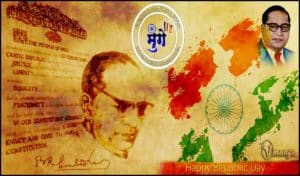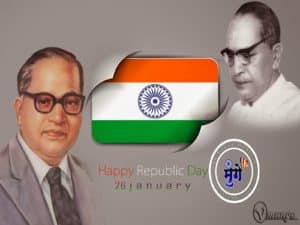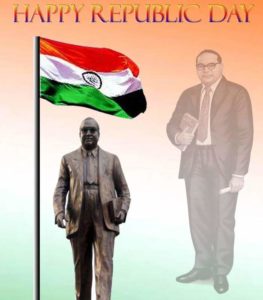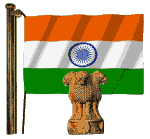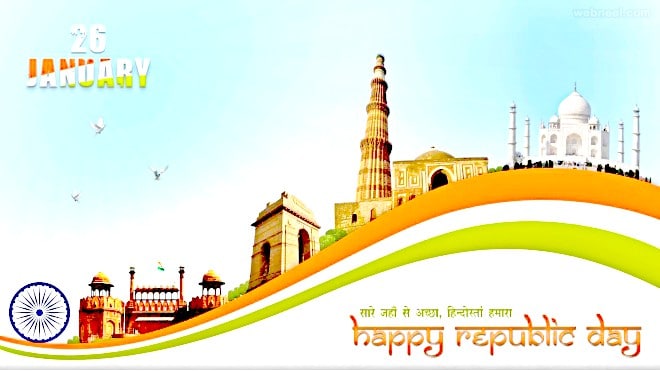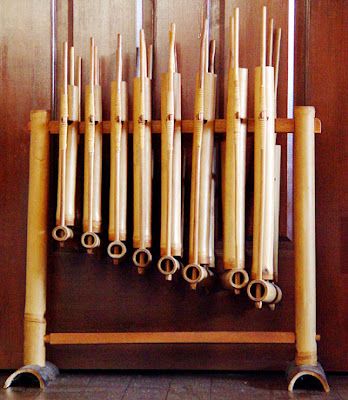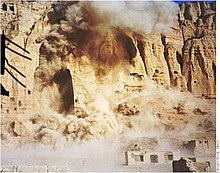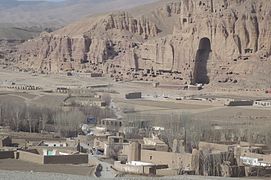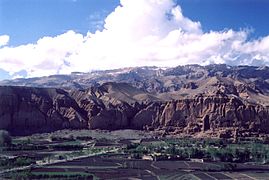PREFACE
1 WHAT IS VINAYA PIṬAKA?
2 VINAYA PIṬAKA
1. Pārājika Pāḷi
2. Pācittiya Pāḷi
3. Mahāvagga Pāḷi
4. Cūḷavagga Pāḷi
5. Parivāra Pāḷi
3 WHAT IS SUTTANTA PIṬAKA?
4 DĪGHA NIKĀYA
1. Sīlakkhandha Vagga Pāḷi
2. Mahā Vagga Pāḷi
3. Pāthika Vagga Pāḷi
5 MAJJHIMA NIKĀYA
1. Mūlapaṇṇāsa Pāḷi
(a) Mūlapariyāya Vagga
(b) Sīhanāda Vagga
(c) Opamma Vagga
(d) Mahāyamaka Vagga
(e) Cūḷayamaka Vagga
2. Majjhima Paṇṇāsa Pāḷi
(a) Gahapati Vagga
(b) Bhikkhu Vagga
(c) Paribbājaka Vagga
(d) Rāja Vagga
(e) Brāhmaṇa Vagga
3. Uparipaṇṇāsa Pāḷi
(a) Devadaha Vagga
(b) Ānupada Vagga
(c) Suññata Vagga
(d) Vibhaṅga Vagga
(e) Saḷāyatana Vagga
6 SAṂYUTTA NIKĀYA
1. Sagāthā Vagga Saṃyutta Pāḷi
2. Nidāna Vagga Saṃyutta Pāḷi
3. Khandha Vagga Saṃyutta Pāḷi
4. Saḷāyatana Vagga Saṃyutta Pāḷi
5. Mahā Vagga Saṃyutta Pāḷi
7 AṄGUTTARA NIKĀYA
1. Ekaka Nipāta Pāḷi
2. Duka Nipāta Pāḷi
3. Tika Nipāta Pāḷi
4. Catukka Nipāta Pāḷi
5. Pañcaka Nipāta Pāḷi
6. Chakka Nipāta Pāḷi
7. Sattaka Nipāta Pāḷi
8. Aṭṭhaka Nipāta Pāḷi
9. Navaka Nipāta Pāḷi
10. Dasaka Nipāta Pāḷi
11. Ekādasaka Nīpata Pāḷi
8 KHUDDAKA NIKĀYA
1. Khuddakapāṭha Pāḷi
2. The Dhammapada Pāḷi
3. Udāna Pāḷi
4. Itivuttaka Pāḷi
5. Suttanipāta Pāḷi
6. Vimāna Vatthu Pāḷi
7. Peta Vatthu Pāḷi
8. The Thera Gāthā Pāḷi
9. The Therī Gāthā Pāḷi
10. Jātaka Pāḷi
11. Niddesa Pāḷi
12. Paṭisambhidā Magga Pāḷi
13. Apadāna Pāḷi
14. Buddhavaṃsa Pāḷi
15. Cariyā Piṭaka
16. Netti
17. Peṭakopadesa
18. Milindapañha Pāḷi
9 WHAT IS ABHIDHAMMA PIṬAKA?
10 ABHIDHAMMA PIṬAKA
1. The Dhammasaṅgaṇī Pāḷi
2. Vibhaṅga Pāḷi
3. Dhātukathā Pāḷi
4. Puggalapaññatti Pāḷi
5. Kathāvatthu Pāḷi
6. Yamaka Pāḷi
7. Paṭṭhāna Pāḷi
Preface
VRI would like to extend its gratitude to the Burma Piṭaka
Association and U Ko Lay for permission to publish the Essence of
Tipiṭaka here in India.
Until now, this lucid and inspiring introduction to the word of the Buddha has been difficult to obtain outside Myanmar.
VRI hopes that the Guide will encourage students of Vipassana
both here and abroad in their meditation practice, and also lead them to
further study of the actual texts.
With the permission of U Ko Lay and the Burma Piṭaka
Association, VRI has made some small changes to the general formatting
and style of the book but its substance remains intact. An index has
been added.
U Ko Lay was formerly the Vice-Chancellor of Mandalay
University and was a devoted student of Sayagyi U Ba Khin. He is
presently carrying out translation work in Yangon, where he lives with
his wife.
Note: This book was published in the year 1995 and reprinted in 1998. Index is not available in the web version
1. WHAT IS VINAYA PIṬAKA?
The Vinaya Piṭaka is made up of rules of discipline laid down
for regulating the conduct of the Buddha’s disciples who have been
admitted into the order as bhikkhus (monks) and bhikkhunis (nuns). These
rules embody authoritative injunctions of the Buddha on modes of
conduct and restraints on both physical and verbal actions. They deal
with transgressions of discipline, and with various categories of
restraints and admonitions in accordance with the nature of the offence.
Seven Kinds of Transgression or Offence (Āpatti)
The rules of discipline first laid down by the Buddha are called mūlapaññatti (the root regulation). Those supplemented later are known as anupaññatti. Together they are known as sikkhāpadas (rules of discipline). The act of transgressing these rules of discipline, thereby incurring a penalty by the guilty bhikkhu, is called āpatti, which means “reaching”, “committing”.
The offences for which penalties are laid down may be classified under seven categories depending on their nature:
(1) Pārājika
(2) Saṅghādisesa
(3) Thullaccaya
(4) Pācittiya
(5) Pāṭidesanīya
(6) Dukkata
(7) Dubbhāsita
An offence in the first category of offences (pārājika), is classified as a grave offence (garukāpatti), which is irremediable (atekicchā), and entails the removal of the offender from bhikkhuhood.
An offence in the second category (saṅghādisesa) is also classified as a grave offence but it is remediable (satekicchā).
The offender is put on a probationary period of penance, during which
he has to undertake certain difficult practices and after which he is
rehabilitated by the Sangha assembly.
The remaining five categories consist of light offences (lahukāpatti),
which are remediable and incur the penalty of having to confess the
transgression to another bhikkhu. After carrying out the prescribed
penalty, the bhikkhu transgressor becomes cleansed of the offence.
When and How the Disciplinary Rules Were Laid Down
For twenty years after the establishment of the order there was neither injunction nor rule concerning pārājika and saṅghādisesa offences. The members of the order of the early days were all ariyas, the least advanced of whom was a stream-winner (one who had attained the first magga and phala-i.e. nibbāna), and there was no need for prescribing rules relating to grave offences.
But as the years went by the Sangha grew in strength.
Undesirable elements lacking the purest of motives and only attracted by
the fame and gain of the bhikkhus began to get into the Buddha’s order.
Some twenty years after the founding of the order it became necessary
to begin establishing rules relating to grave offences.
It was through Bhikkhu Sudinna, a native of Kalanda Village
near Vesāli, who committed the offence of having sexual intercourse with
his ex-wife, that the first pārājika rule came to be introduced. It was laid down to deter bhikkhus from indulging in sexual intercourse.
When such grave offences occurred, where the laying down of a
prohibitory rule became necessary, the Buddha convened an assembly of
the bhikkhus. It was only after questioning the bhikkhu concerned and
after the undesirability of committing such an offence had been made
clear, that a new rule was laid down in order to prevent future lapses
of similar nature.
The Buddha also followed the precedence set by earlier Buddhas.
Using his supernormal powers he reflected on what rules the earlier
Buddhas would lay down under certain given conditions. Then he adopted
similar regulations to meet the situation that had arisen in his time.
Admission of Bhikkhunis into the Order
After spending four vassas (residence period during the
rains) after his enlightenment, the Buddha visited Kapilavatthu, his
native royal city, at the request of his ailing father, King Suddhodana.
At that time, Mahāpajāpatī, Buddha’s foster mother requested him to
admit her into the order.
After his father’s death, the Buddha went back to Vesāli,
refusing the repeated request of Mahāpajāpatī for admission into the
order. The determined foster mother of the Buddha and widow of the
recently deceased King Suddhodana, having cut off her hair and put on
bark-dyed clothes, and accompanied by five hundred Sakyan ladies, made
her way to Vesāli where the Buddha was staying in the Mahāvana, in the
Kūṭāgāra Hall.
The Venerable Ānanda saw them outside the gateway of the
Kūṭāgāra Hall, dust-laden with swollen feet, dejected, tearful, standing
and weeping. Out of great compassion for the ladies, the Venerable
Ānanda interceded with the Buddha on their behalf and requested him to
accept them into the order. The Buddha continued to stand firm. But when
the Venerable Ānanda asked the Buddha whether women were not capable of
attaining magga and phala insight (i.e. nibbāna), the Buddha replied that women were indeed capable of doing so, provided they left the household life like their menfolk.
Thus Ānanda made his request again saying that Mahāpajāpatī had
been of great service to the Buddha waiting on him as his guardian and
nurse, suckling him when his mother died. And as women were capable of
attaining the magga and phala insight, she should be permitted to join the order and become a bhikkhuni.
The Buddha finally acceded to Ānanda’s request: “Ānanda, if Mahāpajāpatī accepts eight special rules (garu-dhammā), let such acceptance mean her admission to the order.”
The eight special rules are:
(1) A bhikkhuni, even if she enjoys a seniority of a hundred
years in the order, must pay respect to a bhikkhu though he may have
been a bhikkhu only for a day.
(2) A bhikkhuni must not keep her rains-residence in a place where there are no bhikkhus.
(3) Every fortnight a bhikkhuni must do two things: ask the bhikkhu saṅgha the day of uposatha (observance day), and approach the bhikkhu saṅgha for instruction and admonition.
(4) When the rains-residence period is over, a bhikkhuni must attend the pavāraṇā
ceremony conducted at both the assemblies of bhikkhus and bhikkhunis,
in each of which she must invite criticism on what has been seen, what
has been heard or what has been suspected of her.
(5) A bhikkhuni who has committed a saṅghādisesa offence must undergo penance for a half-month (pakkha mānatta), in each assembly of bhikkhus and bhikkhunis.
(6) Admission to the order must be sought, from both
assemblies, by a woman novice only after two year’s probationary
training as a candidate.
(7) A bhikkhuni should not insult a bhikkhu in any way, not even obliquely.
(8) A bhikkhuni must abide by instructions given her by bhikkhus, but must not give instructions or advice to bhikkhus.
Mahāpajāpatī accepted unhesitatingly these eight conditions imposed by the Buddha and was consequently admitted into the order.
2. VINAYA PIṬAKA
The Vinaya Piṭaka is made up of five books:
(1) Pārājika Pāḷi
(2) Pācittiya Pāḷi
(3) Mahāvagga Pāḷi
(4) Cūḷavagga Pāḷi
(5) Parivāra Pāḷi
1 Pārājika Pāḷi
Pārājika Pāḷi, which is the first book of the Vinaya Piṭaka,
gives an elaborate explanation of the important rules of discipline
concerning pārājika and saṅghādisesa, as well as aniyata and nissaggiya which are minor offences.
Pārājika Offences and Penalties
Pārājika discipline consists of four sets of rules laid
down to prevent four grave offences. Any transgressor of these rules is
prohibited from becoming a bhikkhu. In the language of Vinaya the pārājika āpatti
falls upon him. He automatically loses the status of a bhikkhu, he is
no longer recognized as a member of the community of bhikkhus, and he is
not permitted to become a bhikkhu again. He either has to go back to
the household life as a layman or return to the status of a sāmaṇera (novice).
One who has lost the status of a bhikkhu for transgression of
any of these rules is likened to: (1) a person whose head has been cut
off from his body-he cannot become alive even if the head is fixed back
on the body; (2) leaves which have fallen off the branches of the tree
they will not become green again even if they are attached back to the
leaf-stalks; (3) a flat rock which has been split-it cannot be made
whole again; (4) a palm tree which has been cut off from its stem-it
will never grow again.
The four pārājika offences which lead to loss of status as a bhikkhu are:
(1) The first pārājika: a bhikkhu who indulges in sexual intercourse loses his bhikkhuhood.
(2) The second pārājika: a bhikkhu who takes with intention to steal what is not given loses his bhikkhuhood.
(3) The third pārājika: a bhikkhu who intentionally deprives a human being of life loses his bhikkhuhood.
(4) The fourth pārājika: a bhikkhu who claims to attainments he does not really possess, namely, attainments to jhāna or magga and phala insight loses his bhikkhuhood.
The pārājika offender is guilty of a very grave transgression. He ceases to be a bhikkhu. His offence (āpatti) is irremediable.
Thirteen Saṅghādisesa Offences and Penalties
Saṅghādisesa discipline consists of a set of thirteen
rules which require formal participation of the Sangha from beginning to
end in the process of making him free from the guilt of the offence.
(1) A bhikkhu having transgressed these rules, and wishing to
be free from his offence must first approach the Sangha and confess to
having committed the offence. The Sangha determines his offence and
orders him to observe the parivāsa penance, a penalty requiring
him to live under suspension from association with the rest of the
Sangha for as many days as he has knowingly concealed his offence.
(2) At the end of the parivāsa observance he undergoes a further period of penance (mānatta) for six days to gain approval of the Sangha.
(3) Having carried out the mānatta penance, the bhikkhu requests the Sangha to reinstate him to full association with the rest of the Sangha.
Now being convinced of the purity of his conduct the Sangha lifts the āpatti at a special congregation attended by at least twenty bhikkhus, where ñatti (the motion for his reinstatement) is recited followed by three recitals of kammavācā (procedural text for formal acts of the Sangha).
Some examples of saṅghādisesa offences are:
(1) Kāyasaṃsagga offence: if any bhikkhu with lustful,
passionate thoughts engages in bodily contact with a woman, such as
holding her hand, caressing her hair or touching any part of her body,
he commits the kāyasaṃsagga saṅghādisesa offence.
(2) Sañcaritta offence: if any bhikkhu acts as a
go-between for a man and a woman in connection with their lawful living
together as husband and wife or their temporary arrangement as man and
mistress or woman and lover, he is guilty of sañcaritta saṅghādisesa offence.
Two Aniyata Offences and Penalties
Aniyata means indefinite, uncertain. There are two aniyata offences where it is unclear whether they are a pārājika offence, a saṅghādisesa offence or a pācittiya offence. This must be determined according to provisions in the following rules:
(1) If a bhikkhu sits down alone with a woman in a place which
is secluded and hidden from view and convenient for an immoral purpose
and if a trustworthy lay woman (i.e. an ariya) seeing him accuses him of any one of the three offences: (i) a pārājika offence, (ii) a saṅghādisesa offence, (iii) a pācittiya offence, and the bhikkhu himself admits that he was so sitting, he should be found guilty of one of these three offences.
(2) If a bhikkhu sits down alone with a woman in a place which
is not hidden from view and not convenient for an immoral purpose but
convenient for talking in a lustful manner to her, and if a trustworthy
lay woman (i.e. an ariya) seeing him accuses him of any one of the two offences: (i) a saṅghādisesa offence, (ii) a pācittiya offence, and the bhikkhu himself admits that he was so sitting, he should be found guilty of one of these two offences.
Thirty Nissaggiya Pacittiya Offences and Penalties
There are thirty rules under the nissaggiya category of
offences and penalties which are laid down to curb greed in bhikkhus for
possession of material items such as robes, bowls etc. To give an
example, an offence is committed under these rules when objects not
permitted are acquired, or when objects are acquired in more than the
permitted quantity. The penalty consists firstly of giving up the
objects in question. This is followed by confession of the breach of the
rule together with an undertaking not to repeat the same offence, to
the Sangha as a whole, or to a group of bhikkhus, or to an individual
bhikkhu to whom the wrongfully acquired objects have been surrendered.
Some examples of the nissaggiya pācittiya offences are:
(1) First nissaggiya sikkhāpada: if any bhikkhu
keeps more than the permitted number of robes (i.e. the lower robe, the
upper robe and the great robe) he commits an offence for which he has to
surrender the extra robes and confess his offence.
(2) Cīvara acchindana sikkhāpada: if any bhikkhu
gives away his own robe to another bhikkhu and afterwards, being angry
or displeased, takes it back forcibly or causes it to be taken away by
someone else he commits a nissaggiya pācittiya offence.
Nissaggiya offences are light offences compared with the grave offences of pārājika āpatti or saṅghādisesa āpatti.
2 Pācittiya Pāḷi
The Pācittiya Pāḷi, which is the second book of the Vinaya
Piṭaka, deals with the remaining sets of rules for the bhikkhus, namely,
the pācittiya, the pāṭidesanīya, the sekhiya, the adhikaraṇasamatha and the corresponding disciplinary rules for the bhikkhunis. Although it is called in Pāḷi just pācittiya, it has the distinctive name of suddha pācittiya (ordinary pācittiya), to distinguish it from nissaggiya pācittiya, described above.
Ninety-two Pācittiya Offences and Penalties
There are ninety-two rules under this class of offences
classified into nine sections. A few examples of this type of offence
are:
(1) Telling a lie deliberately.
(2) A bhikkhu who sleeps under the same roof and within the same walls as a woman commits a pācittiya offence.
(3) A bhikkhu who digs the ground or causes it to be dug commits a pācittiya offence.
A pācittiya offence is remedied merely by admission of the offence to a bhikkhu.
Four Pāṭidesanīya Offences and Penalties
There are four offences under this classification and they all
deal with the bhikkhu’s conduct in accepting and eating alms-food
offered to him. The bhikkhu breaking any of these rules must use a
special formula stating the nature of his fault when admitting his
offence.
The first rule of pāṭidesanīya offence reads: “Should a
bhikkhu eat hard food or soft food having accepted it with his own hand
from a bhikkhuni who is not his relation and who has gone among the
houses for alms-food this should be admitted to another bhikkhu by the
bhikkhu saying: ‘Friend, I have done a censurable thing which is
unbecoming and which should be admitted. I admit having committed a pāṭidesanīya offence.’ “
The events that led to the laying down of this rule happened in
Sāvatthi, where one morning bhikkhus and bhikkhunis were going for
alms-food. A certain bhikkhuni offered the food she had received to a
certain bhikkhu who took away all that was in her bowl. The bhikkhuni
had to go without any food for the day. Three days in succession she
offered to give her alms-food to the same bhikkhu who on all the three
days deprived her of her entire food. Consequently she became famished.
On the fourth day while going on her alms round she fainted and fell
down through weakness. When the Buddha came to hear about this he
censured the bhikkhu who was guilty of the wrong deed and laid down the
above rule.
Seventy-five Sekhiya Rules of Polite Behaviour
These seventy-five rules laid down originally for the proper
behaviour of bhikkhus also apply to novices who seek admission to the
order. Most of these rules were laid down at Sāvatthi as a result of
undisciplined behaviour by a group of six bhikkhus. The rules can be
divided into four groups. The first group of twenty-six rules is
concerned with good conduct and behaviour when going into towns and
villages. The second group of thirty rules deals with polite manners
when accepting alms-food and when eating meals. The third group of
sixteen rules contains rules which prohibit teaching of the Dhamma to
disrespectful people. The fourth group of three rules relates to
unbecoming ways of answering the calls of nature and of spitting.
Seven Ways of Settling Disputes (Adhikaraṇasamatha)
Pācittiya Pāḷi concludes the disciplinary rules for bhikkhus with a chapter on seven ways of settling disputes (adhikaraṇasamatha).
Four kinds of cases are listed:
(1) Vivādādhikaraṇa-disputes as to what is Dhamma, what
is not Dhamma; what is Vinaya, what is not Vinaya; what the Buddha said,
what the Buddha did not say; what constitutes an offence and what is
not an offence.
(2) Anuvādādhikaraṇa-accusations and disputes arising out of them concerning the virtue, practice, views and way of living of a bhikkhu.
(3) Āpattādhikaraṇa-infringement of any disciplinary rule.
(4) Kiccādhikaraṇa-formal meeting or decisions made by the Sangha.
For settlement of disputes that may arise from time to time
amongst the order, precise and detailed methods are prescribed under
seven headings:
(1) Sammukhā vinaya-before coming to a decision conducting an enquiry in the presence of both parties in accordance with the rules of Vinaya.
(2) Sati vinaya-making a declaration by the Sangha of the innocence of an arahat against whom some allegations have been made after asking him if he remembers having committed the offence.
(3) Amūḷha vinaya-making a declaration by the Sangha when the accused is found to be insane.
(4) Patiññatta karaṇa-making a decision after admission by the party concerned.
(5) Yebhuyyasika kamma-making a decision in accordance with the majority vote.
(6) Tassapāpiyasika kamma-a declaration by the Sangha
when the accused proves to be unreliable, making admissions only to
retract them, evading questions and telling lies.
(7) Taṇivatthāraka kamma-”The act of covering up the grass”-exonerating all offences except the offences of pārājika, saṅghādisesa and those in connection with laymen and laywomen when the disputing parties are asked to reconcile by the Sangha.
Rules of Discipline for the Bhikkhunis
The concluding chapters in the Pācittiya Pāḷi are devoted to
the rules of discipline for the bhikkhunis. The list of rules for the
bhikkhunis is longer than that for the bhikkhus. The bhikkhunis rules
were drawn up on exactly the same lines as those for the bhikkhus with
the exception of the two aniyata rules which are not laid down for the bhikkhuni order.
The eight categories of disciplinary rules for bhikkhus and
bhikkhunis of the order are treated in detail in the first two books of
the Vinaya Piṭaka. For each rule an historical account is given as to
how it came to be laid down followed by an exhortation of the Buddha
ending with “This offence does not lead to a rousing of faith in those
who are not convinced of the teaching, nor to an increase of faith in
those who are convinced.” After the exhortation comes the particular
rule laid down by the Buddha followed by word for word commentary on the
rule.
Bhikkhu Bhikkhuni
(1) Pārājika 4 8
(2) Saṅghādisesa 13 17
(3) Aniyata 2 0
(4) Nissaggiya pācittiya 30 30
(5) Suddha pācittiya 92 166
(6) Pāṭidesanīya 4 8
(7) Sekhiya 75 75
(8) Adhikaraṇasamatha 7 7
____ ____
227 311
3 Mahāvagga Pāḷi
The next two books, namely, Mahāvagga Pāḷi which is the third
book and Cūḷavagga Pāḷi which is the fourth book of the Vinaya Piṭaka,
deal with all those matters relating to the Sangha which have not been
dealt with in the first two books.
Mahāvagga Pāḷi, made up of ten sections known as khandhakas,
opens with an historical account of how the Buddha attained supreme
enlightenment at the foot of the Bodhi tree, how he discovered the
famous Law of Dependent Origination and how he gave his first sermon to
the group of five bhikkhus on the discovery of the Four Noble Truths
(i.e. the great “Discourse on the Turning of the Wheel of
Dhamma”-Dhammacakkappavattana Sutta). This was followed by another great
discourse, the Anattalakkhaṇa Sutta. These two suttas can be described
as a compendium of the teaching of the Buddha.
The first section continues to describe how young men of good
families like Yasa sought refuge in him as a Buddha and embraced the
Dhamma; how the Buddha embarked upon the unique mission of spreading the
Dhamma “for the welfare and happiness of the many” when he had
collected around him sixty disciples who were well established in the
Dhamma and had become arahats; how he began to establish the
order of the Sangha to serve as a living example of the truth he
preached; and how his famous disciples like Sāriputta, Moggallāna, Mahā
Kassapa, Ānanda, Upāli, Aṅgulimāla became members of the order. The same
section then deals with the rules for formal admission to the order (upasampadā)
giving precise conditions to be fulfilled before any person can gain
admission to the order and the procedure to be followed for each
admission.
Mahāvagga further deals with procedures for an uposatha
meeting, the assembly of the Sangha on every full moon day and on the
fourteenth or fifteenth waning day of the lunar month when pāṭimokkha, a summary of the Vinaya rules, is recited. Also there are rules to be observed for rains retreat (vassa) during the rainy season as well as those for the formal ceremony of pavāraṇā
concluding the rains retreat, in which a bhikkhu invites criticism from
his brethren in respect of what has been seen, heard or suspected about
his conduct.
There are also rules concerning sick bhikkhus, the use of
leather for footwear and furniture, materials for robes, and those
concerning medicine and food. A separate section deals with the kathina ceremonies where annual making and offering of robes take place.
4 Cūḷavagga Pāḷi
Cūḷavagga Pāḷi, which is book four of the Vinaya Piṭaka, deals
with further rules and procedures for institutional acts or functions
known as saṅghakamma. The twelve sections in this book deal with rules for offences such as saṅghādisesa that come before the Sangha; rules for observance of penances such as parivāsa and mānatta
and rules for reinstatement of a bhikkhu. There are also miscellaneous
rules concerning bathing, dress, dwellings and furniture and those
dealing with treatment of visiting bhikkhus, and duties of tutors and
novices. Some of the important enactments are concerned with tajjanīya kamma,
a formal act of censure by the Sangha taken against those bhikkhus who
cause strife, quarrels and disputes, who associate familiarly with lay
people and who speak against the Buddha, the Dhamma and the Sangha; ukkhepanīya kamma, the formal act of suspension to be taken against those who, having committed an offence, do not want to admit it; and pakāsanīya kamma,
taken against Devadatta announcing publicly that “Whatever Devadatta
does by deed or word, should be seen as Devadatta’s own and has nothing
to do with the Buddha, the Dhamma and the Sangha.” The account of this
action is followed by the story of Devadatta’s three attempts on the
life of the Buddha and the schism caused by Devadatta among the Sangha.
In section ten there is the story of how Mahāpajāpatī, the
Buddha’s foster mother, requested admission into the order, how the
Buddha refused permission at first, and how he finally agreed to the
request because of Ānanda’s appeal on her behalf.
The last two sections describe two important events of
historical interest: the holding of the first Synod at Rājagaha and of
the second Synod at Vesāli.
5 Parivāra Pāḷi
Parivāra Pāḷi, which is the fifth and last book of the Vinaya
Piṭaka, serves as a kind of manual. It is compiled in the form of a
catechism, enabling the reader to make an analytical survey of the
Vinaya Piṭaka. All the rules, official acts, and other matters of the
Vinaya are classified under separate categories according to the
subjects dealt with.
Parivāra explains how rules of the order are drawn up to
regulate the conduct of the bhikkhus as well as the administrative
affairs of the order. Precise procedures are laid down for the settling
of disputes and the handling of matters of jurisprudence, for the
formation of Sangha courts and the appointment of well-qualified Sangha
judges. It lays down how the Sangha Vinicchaya Committee, the Sangha
court, is to be constituted with a body of learned vinayadharas (experts in Vinaya rules) to hear and decide all kinds of monastic disputes.
The Parīvara Pāḷi provides general principles and guidance in
the spirit of which all the Sangha Vinicchaya proceedings are to be
conducted for the settlement of monastic disputes.
3. WHAT IS SUTTANTA PIṬAKA?
The Suttanta Piṭaka is a collection of all the discourses
delivered by the Buddha on various occasions in their entirety. A few
discourses delivered by some of the distinguished disciples of the
Buddha, such as the Venerable Sāriputta, Mahā Moggallāna, Venerable
Ānanda etc., as well as some narratives, are also included in the books
of the Suttanta Piṭaka. The discourses of the Buddha collected together
in the Suttanta Piṭaka were delivered to suit different occasions and
different audiences with different temperaments. Although the discourses
were mostly intended for the benefit of bhikkhus and deal with the
practice of the pure life and with the explanation of the teaching,
there are also several other discourses which deal with the material and
moral progress of the lay disciple.
The Suttanta Piṭaka brings out the meaning of the Buddha’s
teachings, expresses them clearly, and protects and guards them against
distortion and misinterpretation. Just like a string which serves as a
plumb-line to guide the carpenters in their work, just like a thread
which protects flowers from being scattered or dispersed when strung
together by it, similarly by means of suttas the meaning of the Buddha’s
teachings can be brought out clearly, grasped and understood correctly,
and given perfect protection from misinterpretation.
The Suttanta Piṭaka is divided into five separate collections known as nikāyas. They are Dīgha Nikāya, Majjhima Nikāya, Saṃyutta Nikāya, Aṅguttara Nikāya, and Khuddaka Nikāya.
Observances and Practices in the Teaching of the Buddha
In the Suttanta Piṭaka are found not only the fundamentals of
the Dhamma but also practical guidelines to make the Dhamma meaningful
and applicable to daily life. All observances and practices which form
steps in the Buddha’s Noble Path of Eight Constituents lead to spiritual
purification at three levels:
Sīla-moral purity through right conduct.
Samādhi-purity of mind through concentration (samatha).
Paññā-purity of insight through Vipassana meditation.
To begin with one must make the right resolution to take refuge
in the Buddha, to follow the Buddha’s teaching and to be guided by the
Sangha. The first disciples who made the declaration of faith in the
Buddha and committed themselves to follow his teaching were the two
merchant brothers, Tapussa and Bhallika. They were travelling with their
followers in five hundred carts when they saw the Buddha in the
vicinity of the Bodhi tree after his enlightenment. The two merchants
offered him honey rice cakes. Accepting their offering and thus breaking
the fast he had imposed on himself for seven weeks, the Buddha made
them his disciples by letting them recite after him:
Buddhaṃ Saranaṃ Gacchāmi (I take refuge in the Buddha)
Dhammaṃ Saranaṃ Gacchāmi (I take refuge in the Dhamma)
This recitation became the formula of declaration of faith in
the Buddha and his teaching. Later when the Sangha became established
the formula was extended to include the third commitment:
Saṅghaṃ Saranaṃ Gacchāmi (I take refuge in the Sangha)
On the Right Way to Give Alms
As a practical step capable of immediate and fruitful use by
people in all walks of life the Buddha gave discourses on charity
explaining its virtues, and on the right way and the right attitude of
mind with which an offering is to be made for spiritual benefit.
The motivating force in an act of charity is the volition, the
will to give. Charity is a meritorious action that arises only out of
volition. Without the will to give there is no act of giving. Volition
in giving alms is of three types:
(1) The volition that starts with the thought “I shall make an
offering” and that exists during the period of preparation for making
the offering: pubba cetanā (volition before the act).
(2) The volition that arises at the moment of making the offering while handing it over to the recipient: muñca cetanā (volition during the act).
(3) The volition accompanying the joy and rejoicing which arise
during repeated recollection of or reflection on the act of giving: apara cetanā (volition after the act).
Whether the offering is made in homage to the living Buddha or
to a minute particle of his relics after his passing away, it is the
volition, its strength and purity, that determines the nature of the
result thereof.
The discourses also explain the incorrect attitudes of mind with which no act of charity should be performed.
A donor should avoid looking down on others who cannot make a
similar offering nor should he celebrate his own charity. Polluted by
such unworthy thoughts his volition is only of an inferior grade.
When an act of charity is motivated by expectations of
beneficial results of immediate prosperity and happiness or rebirth in
higher existences the accompanying volition is classified as mediocre.
It is only when the good deed of alms-giving is performed out
of a spirit of renunciation motivated by thoughts of pure selflessness,
aspiring only for attainment to nibbāna where all suffering ends, that the volition underlying this act is regarded as of superior grade.
There are abundant examples in the discourses concerning charity and ways of giving alms.
Moral Purity through Right Conduct: Sīla
Practice of sīla forms a most fundamental aspect of the
Buddha’s teaching. It consists of practice of Right Speech, Right
Action, and Right Livelihood to purge oneself of impure deeds, words and
thoughts. Together with the commitment of the Threefold Refuge (as
described above) a lay disciple observes the five precepts by making the
following formal vow:
(1) I undertake to observe the precept of abstaining from killing.
(2) I undertake to observe the precept of abstaining from stealing.
(3) I undertake to observe the precept of abstaining from sexual misconduct.
(4) I undertake to observe the precept of abstaining from telling lies.
(5) I undertake to observe the precept of abstaining from alcoholic drinks, drugs or intoxicants that cloud the mind.
In addition to the negative aspect of the above formula which emphasizes abstinence, there is also the positive aspect of sīla.
For instance, we find in many discourses the statement: “He refrains
from killing, puts aside the cudgel and the sword; full of kindness and
compassion he lives for the welfare and happiness of all living things.”
Every precept laid down in the formula has these two aspects.
Depending upon the individual and the stage of one’s progress,
other forms of precepts (e.g. eight precepts, ten precepts) may be
observed. For the bhikkhus of the order higher and advanced types of
practices of morality are laid down. The five precepts are to be always
observed by lay disciples, who may occasionally enhance their
self-discipline by observing eight or ten precepts. For those who have
already embarked on the path of a holy life the ten precepts are
essential preliminaries to further progress.
Sīla of perfect purity serves as a foundation for the next stage of progress, samādhi-purity of mind through concentration meditation.
Practical Methods of Mental Cultivation for Development of Concentration: Samādhi
Mental cultivation for spiritual uplift consists of two steps.
The first step is to purify the mind from all defilements and corruption
and to have it focused on a single point. A determined effort (Right
Effort) must be made to narrow down the range of thoughts in the
wavering, unsteady mind. Then attention (Right Mindfulness or
Attentiveness) must be fixed on a selected object of meditation until
one-pointedness of mind (Right Concentration) is achieved. In such a
state, the mind becomes freed from hindrances, pure, tranquil, powerful
and bright. It is then ready to advance to the second step by which magga insight and fruition may be attained in order to transcend the state of woe and sorrow.
The Suttanta Piṭaka records numerous methods of meditation to
bring about one-pointedness of mind. These methods of meditation are
dispersed throughout the suttas of the Piṭaka and are explained by the
Buddha sometimes singly, sometimes collectively, to suit the occasion
and the purpose for which they are recommended. The Buddha knew the
diversity of character and mental make-up of each individual and the
different temperaments and inclinations of those who approached him for
guidance. Accordingly he recommended different methods to different
persons to suit the special character and need of each individual.
The practice of mental cultivation which results ultimately in one-pointedness of mind is known as samādhi bhāvanā. Whoever wishes to develop samādhi bhāvanā
must have been established in the observance of the precepts, with the
senses controlled, calm and self-possessed, and must be contented.
Having been established in these four conditions he must select a place
suitable for meditation, a secluded spot. Then he should sit
cross-legged keeping his body erect and his mind alert; he should start
purifying his mind of the five hindrances (sensual desire; ill-will;
sloth and torpor; restlessness and worry; and doubt) by choosing a
meditation method suitable to him and practising meditation with zeal
and enthusiasm. For instance, with the Anapana method he keeps watching
the incoming and outgoing breath until he can have his mind fixed
securely on the breath at the tip of the nose.
When he realizes that the five hindrances have been removed he
becomes gladdened, delighted, calm and blissful. This is the beginning
of samādhi (concentration), which will further develop until it attains one-pointedness of mind.
Thus one-pointedness of mind is concentration of mind when it
is aware of one object, and only one of a wholesome nature. This is
attained by the practice of meditation upon one of the subjects
recommended for the purpose by the Buddha.
Practical Methods of Mental Cultivation for Development of Insight Knowledge (Paññā)
The subject and methods of meditation as taught in the suttas of the Piṭaka are designed both for attainment of samādhi as well as for development of insight knowledge, Vipassana ñāṇa, as a direct path to nibbāna. As a second step in the practice of meditation after achieving samādhi,
when the concentrated mind has become purified, firm and imperturbable,
the meditator directs and inclines his mind to insight knowledge (vipassanā-ñāṇa). With this insight knowledge he discerns the three characteristics of the phenomenal world: impermanence (anicca), suffering (dukkha) and non-self (anattā).
As he advances in his practice and his mind becomes more and
more purified, firm and imperturbable, he directs and inclines his mind
to the knowledge of the extinction of moral impurities (āsavakkhaya ñāṇa). He then truly understands dukkha, the cause of dukkha, the cessation of dukkha and the path leading to the cessation of dukkha. He also comes to understand fully the moral intoxicants (āsavas) as they really are, the cause of āsavas, the cessation of āsavas and the path leading to the cessation of the āsavas.
With this knowledge of extinction of āsavas he becomes
liberated. The knowledge of liberation arises in him. He knows that
rebirth is no more, that he has lived the holy life. He has done what he
has to do for the realization of magga. There is nothing more for him to do for such realization.
The Buddha taught with only one object-the extinction of
suffering and release from conditioned existence. That object can be
obtained by the practice of meditation (for calm and insight) as laid
down in numerous suttas of the Suttanta Piṭaka.
4. DĪGHA NIKĀYA
This collection in the Suttanta Piṭaka is named Dīgha Nikāya as
it is made up of thirty-four long discourses of the Buddha. It is
divided into three divisions:
(1) Sīlakkhanda Vagga (division concerning morality)
(2) Mahā Vagga (the large division)
(3) Pāthika Vagga (the division beginning with the discourse on Pāthika, the naked ascetic)
1 Sīlakkhandha Vagga Pāḷi -
Division Concerning Morality
This division contains thirteen suttas which deal extensively
with various types of morality, namely, minor morality, basic morality
applicable to all; middle morality, and major morality which are mostly
practised by samaṇas and brāhmaṇas. It also discusses the
wrong views then prevalent as well as brahmin views of sacrifice and
caste, and various religious practices such as extreme
self-mortification.
Brahmajāla Sutta (Discourse on the Net of Perfect Wisdom)
An argument between Suppiya, a wandering ascetic, and his pupil
Brahmadatta, with the teacher maligning the Buddha, the Dhamma and the
Sangha and the pupil praising the Buddha, the Dhamma and the Sangha,
gave rise to this famous discourse which is listed first in this Nikāya.
In connection with the maligning of the Buddha, the Dhamma and
the Sangha, the Buddha enjoined his disciples not to feel resentment,
displeasure or anger, because it would only be spiritually harmful to
them. As to the words of praise for the Buddha, the Dhamma and the
Sangha, the Buddha advised his disciples not to feel pleased, delighted
or elated, for it would be an obstacle to their progress in the path.
The Buddha said that whatever worldling (puthujjana) praised the Buddha he could not do full justice to the peerless virtues of the Buddha, namely, his superior concentration (samādhi) and wisdom (paññā). A
worldling could touch on only “matters of a trifling and inferior
nature, mere morality.” The Buddha explained the three grades of
morality and said that there were other dhammas profound, hard to
see, subtle and intelligible only to the wise. Anyone wishing to praise
correctly the true virtues of the Buddha should do so only in terms of
these dhammas.
The Buddha continued to expound on various wrong views. There were samaṇas and brāhmaṇas who, speculating on the past, adhered to and asserted their wrong views in eighteen different ways, namely:
(i) Four kinds of belief in eternity (sassata diṭṭhi)
(ii) Four kinds of dualistic belief in eternity and non-eternity (ekacca sassata diṭṭhi)
(iii) Four views of the world being finite or infinite (antānanta diṭṭhi)
(iv) Four kinds of ambiguous evasion (amarāvikkhepa vāda)
(v) Two doctrines of non-causality (adhiccasamuppanna vāda)
There were samaṇas and brāhmaṇas, who, speculating on the future, adhered to and asserted their wrong views in forty-four ways, namely:
(i) Sixteen kinds of belief in the existence of saññā after death (uddhamāghātanika saññī vāda)
(ii) Eight kinds of belief in the non-existence of saññā after death (uddhamāghātanika asaññī vāda)
(iii) Eight kinds of belief in the existence of neither saññā nor non-saññā after death (uddhamāghātanika nevasaññī nāsaññī vāda)
(iv) Seven kinds of belief in annihilation (uccheda vāda)
(v) Five kinds of mundane nibbāna as realizable in this very life (diṭṭhadhamma nibbāna vāda)
The Buddha said that whatever samaṇas and brāhmaṇas speculated
on the past or the future or both the past and the future, they did so
in these sixty-two ways or one of these sixty-two ways.
The Buddha announced further that he knew all these wrong views
and also what would be the destination, the next existence, in which
the one holding these views would be reborn.
The Buddha gave a detailed analysis of these wrong views
asserted in sixty-two ways and pointed out that these views had their
origin in feeling which arose as a result of repeated contact through
the six sense bases. Whatever person holds these wrong views, in him
feeling gives rise to craving; craving gives rise to clinging; clinging
gives rise to existence; the kammic causal process in existence gives
rise to rebirth; and rebirth gives rise to ageing, death, grief,
lamentation, pain, distress and despair.
But whatever person knows, as they really are, the origin of
the six sense bases of contact, their cessation, their pleasurableness,
their danger and the way of escape from them, he realizes the dhammas, not only mere morality (sīla) but also concentration (samādhi) and liberation (vimutti), wisdom (paññā), that transcend all these wrong views.
All the samaṇas and brāhmaṇas holding the
sixty-two categories of wrong views are caught in the net of this
discourse just like all the fish in a lake are contained in a finely
meshed net spread by a skilful fisherman or his apprentice.
Sāmaññaphala Sutta (Discourse on the Fruits of the Life of a Samaṇa)
On one full moon night while the Buddha was residing in
Rājagaha at the mango grove of Jīvaka this discourse on the fruits of
the life of a samaṇa, personally experienced in this very life,
was taught to King Ajātasattu on request by him. The Buddha explained to
him the advantage of the life of a samaṇa by giving him the examples of a servant of his household or a landholder cultivating the King’s own land becoming a samaṇa to
whom the King himself would show respect and make offerings of
requisites, providing him protection and security at the same time.
The Buddha provided further elucidation on other advantages, higher and better, of being a samaṇa by elaborating on: (i) how a householder, hearing the Dhamma taught by a Buddha, leaves the home life and becomes a samaṇa out of pure faith; (ii) how he becomes established in three categories of sīla, minor,
middle and major; (iii) how he gains control over his sense faculties
so that no depraved states of mind such as covetousness and
dissatisfaction would overpower him; (iv) how he becomes endowed with
mindfulness and clear comprehension and remains contented; (v) how, by
dissociating himself from five hindrances, he achieves the four jhānas (the
first, the second, the third and the fourth) as higher advantages than
those previously mentioned; (vi) how he becomes equipped with eight
kinds of higher knowledge, namely: insight knowledge, the power of
creation by mind, the psychic powers, the divine power of hearing,
knowledge of the minds of others, knowledge of past existences, divine
power of sight, knowledge of extinction of moral intoxicants.
Thus when the knowledge of liberation arises in him, he knows
he has lived the life of purity. There is no other advantage of being a samaṇa, personally experienced, more pleasing and higher than this.
Ambaṭṭha Sutta
Ambaṭṭha, a young disciple of Pokkharasāti, the learned
brahmin, was sent by his master to investigate whether Gotama was a
genuine Buddha endowed with the thirty-two personal characteristics of a
great man. His insolent behaviour, taking pride in his birth as a
brahmin, led the Buddha to subdue him by proving that khattiya is in fact superior to brāhmaṇa. The
Buddha explained further that nobleness in man stemmed not from birth
but from perfection in three categories of morality, achievements of
four jhānas, and accomplishments in eight kinds of higher knowledge.
Soṇadaṇḍa Sutta
This discourse was given to the brahmin Soṇadaṇḍa who
approached the Buddha while he was residing near Lake Gaggarā at Campā
in the country of Aṅga. He was asked by the Buddha what attributes
should one possess to be acknowledged as a brahmin. Soṇadaṇḍa enumerated
high birth, learning in the Vedas, good personality, morality and
knowledge as essential qualities to be a brahmin. When further
questioned by the Buddha, he said that the minimum qualifications were
morality and knowledge without which no one would be entitled to be
called a brahmin. On his request, the Buddha explained to him the
meaning of the terms morality and knowledge, which he confessed to be
ignorant of, namely, the three categories of morality, achievements of
four jhānas and accomplishments in eight kinds of higher knowledge.
Kūṭadanta Sutta
On the eve of offering a great sacrificial feast, the brahmin
Kūṭadanta went to see the Buddha for advice on how best to conduct the
sacrifice. Giving the example of a former King Mahāvijita, who also made
a great sacrificial offering, the Buddha declared: the principle of
consent by four parties from the provinces (namely, noblemen, ministers,
rich brahmins and householders); the eight qualities to be possessed by
the king who would make the offerings; the four qualities of the
brahmin royal adviser who would conduct the ceremonies; and the three
attitudes of mind towards the sacrifices. With all these conditions
fulfilled, the feast offered by the king was a great success, with no
loss of life of sacrificial animals, no hardship on the people, no one
impressed into service, everyone co-operating in the great feast
willingly.
The brahmin Kūṭadanta then asked the Buddha if there was any
sacrifice which could be made with less trouble and exertion, yet
producing more fruitful result. The Buddha told him of the traditional
practice of offering the four requisites to bhikkhus of high morality.
Less troublesome and more profitable again was donating a monastery to
the order of bhikkhus. Better still were the following practices in
ascending order of beneficial effects: (i) going to the Buddha, the
Dhamma, and Sangha for refuge (ii) observing the five precepts (iii)
going forth from the home life and leading the holy life, becoming
established in morality, becoming accomplished in the four jhānas, and becoming equipped with eight kinds of higher knowledge resulting in the realization of the extinction of āsavas. This is the sacrifice which entails less trouble and exertion but which excels all other sacrifices.
Mahāli Sutta
Mahāli Oṭṭhaddha, a Licchavi ruler, once came to see the Buddha
to whom he recounted what Sunakkhatta, a Licchavi prince, had told him.
Sunakkhatta had been a disciple of the Buddha for three years after
which he left the teaching. He told Mahāli how he had acquired the
divine power of sight by which he had seen myriads of pleasant,
desirable forms belonging to the deva world but that he had not heard sounds belonging to the deva world. Mahāli wanted to know from the Buddha whether Sunakkhatta did not hear the sounds of the deva world because they were non-existent, or whether he did not hear them although they existed.
The Buddha explained that there were sounds in the deva world
but Sunakkhatta did not hear them because he had developed
concentration only for one purpose, to achieve the divine power of sight
but not the divine power of hearing.
The Buddha explained further that his disciples practised the
noble life under him not to acquire such divine powers but with a view
to the realization of dhammas which far excel and transcend these mundane kinds of concentrations. Such dhammas are
attainments of the four states of noble fruition-states of a
stream-winner, a once-returner, a non-returner, and the state of mind
and knowledge of an arahat freed of all āsavas that have been rendered extinct.
The Path by which these dhammas can be realized is the
Noble Path of Eight Constituents: Right View, Right Thought, Right
Speech, Right Action, Right Livelihood, Right Effort, Right Mindfulness,
Right Concentration.
Jāliya Sutta
Once when the Buddha was residing at Ghositārāma Monastery near
Kosambī, two wandering ascetics, Muṇḍiya and Jāliya, approached him and
asked whether the soul was the physical body, or the physical body the
soul, or whether the soul was one thing and the physical body another.
The Buddha explained how a person who had finally realized
liberation would not even consider whether the soul was the physical
body, or the physical body the soul, or whether the soul was one thing
and physical body another.
Mahāsīhanāda Sutta
This discourse defines what a true samaṇa is, what a true brāhmaṇa is.
The Buddha was residing in the deer park of Kaṇṇakatthala at Ujuñña.
The naked ascetic Kassapa approached him and said that he had heard that
Samaṇa Gotama disparaged all practices of self-mortification and that
Samaṇa Gotama reviled all those who led an austere life.
The Buddha replied that they were slandering him with what was
not said, what was not true. When the Buddha could see with his
supernormal vision the bad destinies as well as the good destinies of
those who practised extreme forms of self-mortification, and of those
who practised less extreme forms of self-mortification, how could he
revile all systems of self-mortification.
Kassapa then maintained that only those recluses, who for the
whole of their life cultivated the practice of standing or sitting, or
who were abstemious in food, eating only once in two days, seven days,
fifteen days, etc., were real samaṇas and brāhmaṇas. The
Buddha explained to him the futility of extreme self-mortification and
said that only when a recluse practised to become accomplished in
morality, concentration and knowledge, cultivated loving-kindness, dwelt
in the emancipation of mind, and dwelt in the emancipation through
knowledge would he be entitled to be called a samaṇa and brāhmaṇa. Then
the Buddha gave a full exposition on morality, concentration and
knowledge, resulting in Kassapa’s decision to join the order of the
Buddha.
Poṭṭhapāda Sutta
Once when the Buddha was staying at the Monastery of
Anāthapiṇḍika in the Jeta Grove at Sāvatthi he visited the Ekasālaka
Hall where various views were debated. At the time Poṭṭhapāda, the
wandering ascetic, asked him about the nature of the cessation of
consciousness (saññā). Poṭṭhapāda wanted to know how the
cessation of consciousness was brought about. The Buddha told him that
it was through reason and cause that forms of consciousness in a being
arose and ceased. A certain form of consciousness arose through practice
(adhicitta sikkhā) and a certain form of consciousness ceased through practice.
The Buddha then proceeded to expound on these practices consisting of observance of sīla and development of concentration which resulted in arising and ceasing of successive jhānas. The meditator progressed from one stage to the next in sequence until he achieved the cessation of all forms of consciousness (nirodha samāpatti).
Subha Sutta
This is a discourse given not by the Buddha but by his close
attendant, the Venerable Ānanda, on the request of young Subha. The
Buddha had passed away by then. And young Subha wanted to know from the
lips of the Buddha’s close attendant what dhammas were praised by the Buddha and what those dhammas were which he urged people to practise.
Ānanda told him that the Buddha had words of praise for the
three aggregates of Dhamma, namely, the aggregate of morality, the
aggregate of concentration and the aggregate of knowledge. The Buddha
urged people to practise these dhammas, dwell in them, and have
them firmly established. Ānanda explained these aggregates of Dhamma in
great detail to young Subha, in consequence of which Subha became a
devoted lay disciple.
Kevaṭṭa Sutta
The Buddha was residing at Nālandā in Pārāvārika’s mango grove.
A devoted lay disciple approached the Buddha and urged him to let one
of his disciples perform miracles so that the city of Nālandā would
become devoted to the Buddha.
The Buddha told him about the three kinds of miracles which he
had known and realized by himself through supernormal knowledge. The
first miracle, iddhi pāṭihāriya, was rejected by the Buddha because it could be mistaken as the black art called gandhārī magic. The Buddha also rejected the second miracle, ādesanā pāṭihāriya, which might be mistaken as practice of cintāmaṇi charm. He recommended the performance of the third miracle, the anusāsanī pāṭihāriya, the
miracle of the power of the teaching as it involved practice in
morality, concentration and knowledge leading finally to the extinction
of āsavas (āsavakkhaya ñāṇa).
Lohicca Sutta
The discourse lays down three types of blameworthy teachers:
(i) the teacher who is not yet accomplished in the noble practice and
teaches pupils who do not listen to him; (ii) the teacher who is not yet
accomplished in the noble practice and teaches pupils who practise as
instructed by him and attain emancipation; (iii) the teacher who is
fully accomplished in the noble practice and teaches pupils who do not
listen to him.
The praiseworthy teacher is one who has become fully
accomplished in the three practices of morality, concentration and
knowledge and teaches pupils who become fully accomplished like him.
Tevijja Sutta
Two brahmin youths, Vāseṭṭha and Bhāradvāja, came to see the
Buddha while he was on a tour through the kingdom of Kosala. They wanted
the Buddha to settle their dispute as to the correct path that led
straight to companionship with Brahmā. Each one thought only the way
shown by his own master was the true end.
The Buddha told them that as none of their masters had seen
Brahmā, they were like a line of blind men each holding on to the
preceding one. Then he showed them the true path that really led to the
Brahmā realm, namely, the path of morality and concentration, and
development of loving-kindness, compassion, sympathetic joy and
equanimity towards all sentient beings.
2 Mahā Vagga Pāḷi-
The Large Division
The ten suttas in this division are some of the most important
of the Tipiṭaka, dealing with historical and biographical aspects as
well as the doctrinal aspects of Buddhism. The most famous sutta is the
Mahāparinibbāna Sutta which gives an account of the last days and the
passing away of the Buddha and the distribution of his relics.
Mahāpadāna Sutta deals with brief accounts of the last seven Buddhas and
the life story of the Vipassī Buddha. Doctrinally important are the two
suttas: the Mahānidāna Sutta, which explains the Chain of Cause and
Effect, and the Mahāsatipaṭṭhāna Sutta, which deals with the four
methods of steadfast mindfulness and practical aspects of Buddhist
meditation.
Mahāpadāna Sutta
This discourse was given at Sāvatthi to the bhikkhus who were
one day discussing the Buddha’s knowledge of past existences. He told
them about the last seven Buddhas, with a full life story of one of
them, the Vipassī Buddha, recalling all the facts of the Buddhas, their
social rank, name, clan, life-span, the pairs of chief disciples, the
assemblies of their followers, their attainments, and emancipation from
defilements.
The Buddha explained that his ability to remember and recall
all the facts of past existences was due to his own penetrating
discernment as well as due to the devas making these matters known to him.
Mahānidāna Sutta
This discourse was given at Kammāsadhamma market town to the Venerable Ānanda to correct his wrong view that the doctrine of Paṭiccasamuppāda, although
having signs of being deep and profound, was apparent and fathomable.
The Buddha told him that this doctrine not only appeared to be deep and
profound but was actually deep and profound on four counts: it was deep
in meaning, deep as a doctrine, deep with respect to the manner in which
it was taught, and deep with regard to the facts on which it was
established.
He then gave a thorough exposition on the doctrine and said
that because of lack of proper understanding and penetrative
comprehension of this doctrine, beings were caught in and unable to
escape from the ruinous round of rebirth. He concluded that without a
clear understanding of this doctrine, even the mind of those
accomplished in the attainments of jhāna would be clouded with ideas of atta.
Mahāparinibbāna Sutta
This sutta is an important narrative of the Buddha’s last days,
a detailed chronicle of what he did, what he said and what happened to
him during the last year of his life. Compiled in a narrative form, it
is interspersed with many discourses on some of the most fundamental and
important aspects of the Buddha’s teaching. Being the longest discourse
of the Dīgha Nikāya, it is divided into six chapters.
On the eve of the last great tour, the Buddha, while staying at
Rājagaha, gave the famous discourses on seven factors of non-decline of
kings and princes, and seven factors of non-decline of bhikkhus.
Then he set out on his last journey going first to the village
of Pāṭali where he taught on the consequences of an immoral and a moral
life. He then proceeded to the village of Koṭi where he expounded on the
Four Noble Truths. Then the Buddha took up his residence at the village
of Nātika where the famous “Discourse on the Mirror of Truth” was
given.
Next the Buddha went to Vesāli with a large company of
bhikkhus. At Vesāli he accepted the park offered by the courtesan
Ambapāḷi. From Vesāli, the Buddha travelled to a small village named
Veluva where he was overtaken by a severe illness that could have proved
fatal. But the Buddha resolved to maintain the life-process and not to
pass away without addressing his lay disciples and without taking leave
of the Sangha. When Ānanda informed the Buddha how worried he had been
because of the Buddha’s illness, the Buddha gave the famous injunction:
“Let yourselves be your own support, your own refuge. Let the Dhamma,
not anything else, be your refuge.”
It was at Vesāli that the Buddha made the decision to pass away and realize parinibbāna in
three months’ time. Upon his making this momentous decision there was a
great earthquake. Ānanda, on learning from the Buddha the reason of the
earthquake, supplicated him to change the decision, but to no avail.
The Buddha then caused the Sangha to be assembled to whom he announced his approaching parinibbāna. He
then went over all the fundamental principles of his teaching and
exhorted them to be vigilant, alert, and to watch over their own mind so
as to make an end of suffering.
The Buddha then left Vesāli and went to Bhaṇḍa village where he continued to give his discourses to the accompanying Sangha on sīla, samādhi and paññā. Proceeding further on his journey to the north, he gave the discourse on the four great authorities (mahāpadesa) at the town of Bhoga.
From there he went on to Pāvā and stayed in the Mango Grove of
Cunda, the Goldsmith’s son, who made an offering of food to the Buddha
and his community of bhikkhus. After eating the meal offered by Cunda, a
severe illness came upon the Buddha who nevertheless continued on his
journey until he reached Kusinārā where in the Sal Grove of the Malla
princes he urged Ānanda to lay out the couch for him. He lay down on the
couch with mindfulness and deliberation, awaiting the hour of his parinibbāna.
Even on his death-bed the Buddha continued to teach; he
explained that there are four places which arouse reverence and devotion
and four persons worthy of a stupa; and he answered Ānanda’s
questions on how to conduct oneself with regard to women, and on what
should be done regarding the remains of the Buddha. His last act of
selflessness was to expound the truth and show the path to Subhadda, the
wandering ascetic.
Then after ascertaining that there was not a single bhikkhu who
had perplexity or doubt about the Buddha, the Dhamma and the Sangha,
the Buddha uttered his last words: “Inherent in all compounded things is
decay and dissolution. Strive well with full mindfulness.”
Then as the assembled bhikkhus, princes and people paid homage to him with deep reverence, the Buddha passed away, realizing parinibbāna.
Mahāsudassana Sutta
This discourse was given by the Buddha while he was lying on
his death-bed in the Sal Grove of the Mallas. When Ānanda implored him
not to realize parinibbāna in an insignificant, barren, small
town, the Buddha told him that Kusinārā was not an insignificant small
place. In times long past, it was known as Kusāvatī, the capital city of
universal monarchs who ruled over the four quarters of the world.
The Buddha then described the magnificence and grandeur of
Kusāvatī when King Mahāsudassana was the ruler there. He also told how
the King ruled over his dominions righteously and how finally abandoning
all attachments and practising jhāna he passed away and reached the blissful Brahmā realm.
The Buddha revealed that he himself was King Mahāsudassana of
that time. He had cast off the body in this place (former Kusāvatī) six
times as a universal monarch. Now he was casting it off for the seventh
and last time. He ended the discourse reminding Ānanda that all
compounded things are indeed impermanent. Arising and decaying are their
inherent nature. Only their ultimate cessation is blissful nibbāna.
Janavasabha Sutta
This discourse is an extension of another discourse delivered
by the Buddha on his last journey. Ānanda wanted to know the destinies
of lay disciples from the country of Magadha. The Buddha told him that
innumerable persons from Magadha had reached the deva world by
virtue of their faith in the Buddha, the Dhamma and the Sangha. This
information was given him by Janavasabha Deva who was formerly King
Bimbisāra. He informed the Buddha that there were regular assemblies of devas in the deva realm on uposatha days when the king of the devas and
Sanaṅkumāra Brahmā taught the Dhamma on development of the bases of
psychic power, on the three opportunities, on the four methods of
steadfast mindfulness and the seven accessories of concentration.
Mahāgovinda Sutta
In this discourse, Pañcasikha, a gandhabba deva, told the deva assembly where Sanaṅkumāra Brahmā taught the Dhamma as shown by Mahāgovinda, the bodhisatta who
had reached the Brahmā world. The Buddha said that Mahāgovinda was none
other than himself and explained that the Dhamma he taught at that time
could lead one only to the Brahmā world. With his teaching now as an
enlightened Buddha, higher attainments such as the sotāpatti, anāgāmi and the highest achievement arahatta phala were possible.
Mahāsamaya Sutta
The Buddha was residing in the Mahāvana forest at Kapilavatthu with a company of arahats numbering five hundred. Then devas and Brahmās from ten thousand cakkavāḷas came to see the Buddha and the community of bhikkhus. The Buddha told his disciples the names of the devas and Brahmās as listed in this sutta.
Sakkapañha Sutta
Once when the Buddha was residing at the Indasāla Cave near Rājagaha, Sakka, the king of devas, came
to him to ask certain questions. He wanted to know why there was
hostility and violence among various beings. The Buddha told him it was
envy and selfishness that brought about hostility among beings. He
further explained that envy and selfishness were caused by likes and
dislikes, which in turn had their roots in desire. And desire grew from
mental preoccupation (vitakka) which had its origin in saṃsāra-expanding illusions (papañca-saññā-saṅkha).
The Buddha then gave an outline of practices to remove these saṃsāra-expanding illusions including two types of quests, quests that should be pursued and quests that should not be pursued.
Mahāsatipaṭṭhāna Sutta
This sutta is one of the most important doctrinal discourses of
the Buddha. It propounds the only way for the purification of beings,
for overcoming sorrow and lamentation, for the complete removal of pain
and grief, for the attainment of the right path, and for the realization
of nibbāna. This discourse, given directly to the bhikkhus at
the market town of Kammāsadhamma, defines “the only way” as the four
methods of steadfast mindfulness made up of fourteen ways of
contemplating the body, nine ways of contemplating sensation, sixteen
ways of contemplating the mind, and five ways of contemplating the
Dhamma. It ends with a definite assurance of fruitful results:
arahatship in this very existence or the state of an anāgāmi within seven years, seven months or seven days.
Pāyāsi Sutta
This discourse recounts how the Venerable Kumārakassapa showed
the right path to Governor Pāyāsi of Setabyā town in Kosala country.
Governor Pāyāsi held the wrong belief: “There is no other world; no
beings arise again after death; there are no consequences of good or bad
deeds.” The Venerable Kumārakassapa showed him the right path,
illustrating his teaching with numerous illuminating similes. Ultimately
Pāyāsi became full of faith and took refuge in the Buddha, the Dhamma
and the Sangha. The Venerable Kumārakassapa taught him also the right
kind of offerings to be made and that these offerings would be made with
due respect, by one’s own hands, with due esteem and not as if
discarding them. Only under these conditions would the good deed of
offerings bear splendid fruits.
3 Pāthika Vagga Pāḷi
This division is made up of eleven shorter discourses of a
miscellaneous nature. They deal with the Buddha’s rejection of wrong and
severe asceticism practised by followers of many sects. They deal also
with the periodical evolution and dissolution of the universe, the
accounts of universal monarchs and the thirty-two physiognomic
characteristics of a great man. There is one discourse, Siṅgāla Sutta,
addressed to a young brahmin showing the duties to be performed by
members of the human society. The last two suttas, Saṅgīti and
Dasuttara, are discourses given by the Venerable Sāriputta and they
contain lists of doctrinal terms classified according to subject matter
and numerical units. The style of their composition is different from
the other nine suttas of the division.
Pāthika Sutta
At the time of the Buddha, there were many other teachers with
their own disciples holding different views on what constituted the holy
life, on the origin and development of the universe, and on the
performance of wonders and miracles.
Sunakkhatta, a Licchavi prince, became a disciple of the Buddha
and was admitted into the order. But he found the discipline and the
teaching to be beyond him and his comprehension. He became at the same
time attracted to the teachings and practices of other sects. He left
the order after three years. Then becoming a follower of one of the
sects he began to disparage the teachings of the Buddha, and made
slanderous attacks on the Buddha and his disciples. In Pāthika Sutta are
short discourses in which are accounts of the Buddha’s refutation and
explanation with reference to many of Sunakkhatta’s accusations.
Udumbarikā Sutta
This discourse was given to Nigrodha, the wandering ascetic,
and his followers in the park of the Queen Udumbarikā near Rājagaha in
order to destroy their wrong doctrine and establish wholesome doctrine.
So obsessed were the wandering ascetics with their own wrong beliefs
that they gave no response to the Buddha’s invitation to follow his
teaching which would assure them fruitful results within seven days.
Cakkavatti Sutta
In the town of Mātulā, in the country of Magadha, bhikkhus were
enjoined by the Buddha to be their own support, their own refuge,
relying only on the Dhamma and not on any other refuge. Then the Buddha
told them the story of Daḷhanemi, the universal monarch who possessed
the Celestial Wheel as one of his seven treasures. He and his successor
ruled over the four continents, wielding the power and authority of the
universal monarch. Their life-span was long, and as long as they
remained righteous and fulfilled the noble duties of universal monarch,
making the Dhamma their only support, providing shelter and security,
offering wealth and necessities to the needy, their dominions remained
at peace, were prosperous and progressing.
But when the monarch failed to fulfil the noble duties of a
righteous king, when the Dhamma was no longer held as a refuge, the
morality of the people declined. Their life-span dwindled down to ten
years only. Then the ten meritorious deeds productive of wholesome
effects completely disappeared and the ten evil deeds giving unwholesome
results flourished exceedingly. People failed to show reverential
regard for the leaders and elders, to fulfil their duties towards
parents, samaṇas and brāhmaṇas. There also developed
intense mutual aversion, ill-will, thoughts of killing one another,
followed by fighting, devastation and carnage.
A few who survived the holocaust agreed to give up their evil
ways, to live in a spirit of harmony, doing good deeds, showing
reverential regard for the leaders and elders, fulfilling their duties
towards parents, samaṇas and brāhmaṇas. In consequence of
improved morality, their life-span expanded again until it reached
eighty thousand years when a universal monarch appeared once more to
rule righteously. Bhikkhus were thus enjoined to keep within the
confines of the Dhamma, making it their support, their refuge. The
Dhamma would show the way for their physical and mental development
until they attained arahatship.
Aggañña Sutta
This discourse was given as Sāvatthi to two novices under
training, Vāseṭṭha and Bhāradvāja, pointing out the wrong beliefs of
brahmins as regards caste. The brahmins claimed that among the four
classes of people recognised at that time brahmins were the noblest;
next came the khattiya class (the nobility and royalty) followed by vessa (the trading class) and sudda (the lowest class).
The Buddha refuted these claims of the brahmins by explaining
how the world was subjected to processes of evolution and dissolution
and describing how human beings first appeared on earth and how the four
social classes emerged. He explained further that the nobility of a
person was decided not by his birth and lineage but by his morality and
knowledge of the Noble Truths.
“Whoever holds wrong views and commits misdeeds is not noble
whatever his birth. Whoever restrains himself in deed, word and thought
and develops the bodhipakkhiya dhammas until he attains complete eradication of defilements in this very life is the chief, the noblest amongst men and devas irrespective of birth.”
Sampasādanīya Sutta
The Venerable Sāriputta’s deep confidence in the Buddha was
once proclaimed aloud in an eloquent eulogy of the Buddha spoken in the
Buddha’s presence. For making this bold utterance on the virtues of the
Buddha, the Buddha asked him whether he had personal knowledge of the
minds of all the Buddhas, those of the past, of the future and of the
present, their morality, their concentration, their wisdom, and the
manner of their emancipation.
The Venerable Sāriputta said he did not claim to have such
knowledge but justified himself by stating in detail the course of the
Dhamma taken by all the Buddhas, their accomplishment in sīla, abandonment
of five hindrances, establishment in the four methods of steadfast
mindfulness and cultivation of the seven factors of enlightenment-as
being the only course that could lead to unsurpassed supreme
enlightenment.
Pāsādika Sutta
The Venerable Ānanda accompanied by Bhikkhu Cunda went to see
the Buddha to give him the news about the death of Nigaṇṭha Nāṭaputta,
the leader of a well-known sect, and the schism that had arisen amongst
his disciples.
The Buddha told them that it was natural and to be expected to
happen in a teaching which was not well taught, not well imparted, not
conducive to emancipation, and not taught by one who was supremely
enlightened.
In contrast, the Buddha explained that when the teaching was
well taught, well imparted by one who was supremely enlightened, there
were no wrong views, no speculations about past or future or about atta.
In the teaching of the Buddha, bhikkhus were taught the four methods of
steadfast mindfulness by which wrong views and speculations were laid
aside.
Lakkhaṇa Sutta
This discourse on thirty-two bodily marks of a great man was
given by the Buddha at Sāvatthi in Anāthapiṇḍika’s Monastery. For a
person endowed with the thirty-two bodily marks of a great man, only two
possible courses are open to him and no other.
“If he lives the household life, he will become a universal
monarch ruling in righteousness over the four continents. If he goes
forth from the home life into homelessness, he will become an
enlightened Buddha.”
The Buddha explained the thirty-two bodily marks in detail,
together with accounts of meritorious deeds previously performed by
virtue of which each of these thirty-two bodily marks were acquired.
Siṅgāla Sutta
This discourse was given by the Buddha at Rājagaha for the
edification of a young man named Siṅgāla. The youth Siṅgāla used to
worship the six cardinal points, namely, the east, the south, the west,
the north, the nadir and the zenith in obedience to the last advice
given by his dying father. The Buddha explained to the young man that
according to his teaching the six directions were: the east standing for
parents; the south standing for teachers; the west standing for the
wife and children; the north standing for friends and associates; the
nadir standing for servants, employees; the zenith standing for samaṇas, brāhmaṇas.
The Buddha explained further that the six social groups
mentioned in the discourse were to be regarded as sacred and worthy of
respect and worship. One worshipped them by performing one’s duties
towards them. Then these duties were explained to the youth Siṅgāla.
Āṭānāṭiya Sutta
Four celestial kings came to see the Buddha and told him that
there were non-believers among many invisible beings who might bring
harm to the followers of the Buddha. The celestial kings therefore
wanted to teach the bhikkhus the protecting incantation known as the
Āṭānāṭiya Paritta. The Buddha gave his consent by remaining silent.
Then the four celestial kings recited the Āṭānāṭiya Paritta,
which the Buddha advised the bhikkhus, bhikkhunis and lay disciples to
learn, to memorize so that they might dwell at ease, well guarded and
protected.
Saṅgīti Sutta
The Buddha was touring through the country of the Mallas when
he came to Pāvā. The death of Nigaṇṭha Nāṭaputta had taken place only
recently and his followers were left in dissension and strife, wrangling
over doctrines.
The Venerable Sāriputta who delivered this discourse attributed
this schism among Nāṭaputta’s followers to the fact the Nāṭaputta’s
teaching had not been well taught nor well imparted, and was not
conducive to release from the round of existences, being taught by one
who was not supremely enlightened.
But the Buddha’s teaching was well taught, well imparted,
conducive to release from the round of existences, being taught by the
Buddha who was supremely enlightened. He advised the bhikkhus to recite
the Dhamma as taught by the Buddha, in concord and without dissension so
that the teaching should last long. Then he proceeded to enumerate the
Dhamma classified under separate heads as group of the ones, group of
the twos, etc., up to groups of the tens to facilitate easy memorizing
and reciting.
Dasuttara Sutta
This discourse was also delivered by the Venerable Sāriputta,
while the Buddha was staying at Campā, in order that the bhikkhus should
get liberated from fetters and attain nibbāna, bringing about the end of suffering.
He taught the Dhamma classified under separate heads as group
of the ones, group of the twos, etc., up to the groups of the tens.
5. MAJJHIMA NIKĀYA
This collection of medium length discourses is made up of one
hundred and fifty-two suttas in three books known as paṇṇāsa. The first
book, Mūlapaṇṇāsa, deals with the first fifty suttas in five vaggas; the
second book, Majjhimapaṇṇāsa consists of the second fifty suttas, also
in five vaggas; and the last fifty-two suttas are dealt with in five
vaggas of the third book, Uparipaṇṇāsa, which means more than fifty.
The suttas in this nikāya throw much light on the social
ideas and institutions of those days, and also provide general
information on the economic and political life.
1 Mūlapaṇṇāsa Pāḷi
(a) Mūlapariyāya Vagga
Mūlapariyāya Sutta
The Buddha explained the basis of all phenomena, specifying
twenty-four categories such as the four elements (earth, water, fire,
wind); sentient beings, devas; the seen, the heard, the thought of, the known; the oneness, the multiplicity, the whole; and the reality of nibbāna.
The uninstructed worldling cannot perceive the true nature of these
phenomena; only the enlightened ones can see them in true perspective.
Sabbāsava Sutta
In this discourse, mental intoxicants that beset the
uninstructed worldling are defined, and seven practices for eradicating
them are explained.
Dhammadāyāda Sutta
This sutta contains two separate discourses, the first one
given by the Buddha, the second by the Venerable Sāriputta. The Buddha
urged the bhikkhus to receive as their legacy from him the bodhipakkhiya dhamma
only, and not material things like the four requisites. The Venerable
Sāriputta advised the bhikkhus to lead a solitary life for attainment of
jhāna and to strive for the attainment of nibbāna by abandoning greed, ill will, and delusion.
Bhayabherava Sutta
This discourse describes how a bhikkhu leading a solitary life
in a secluded forest invites harm and danger to himself by his impure
thoughts, words and deeds, and how the Buddha had lived a peaceful
forest life harmlessly by cultivating pure thoughts, words and deeds
which finally led him to enlightenment.
Anaṅgana Sutta
In this discourse given on the request of the Venerable Mahā
Moggallāna, the Venerable Sāriputta explained four types of individuals:
(i) an impure person who knows he is impure;
(ii) an impure person who does not know he is impure;
(iii) a pure person who knows his own purity;
(iv) a pure person who does not know his own purity.
Ākaṅkheyya Sutta
This sutta describes how a bhikkhu should develop sīla, samādhi and paññā, instead of craving for gain and fame; how he should restrain his faculties, seeing danger in the slightest fault.
Vattha Sutta
In this discourse the Buddha explained the difference between
an impure mind and pure mind by giving the example of a dirty cloth and a
clean cloth. Only the clean cloth will absorb dye; so also only the
pure mind will retain the Dhamma.
Sallekha Sutta
In this discourse the Buddha explained to Mahā Cunda how wrong views about atta and loka can be removed only by Vipassana insight. The practice of jhāna
is not the austerity practice that removes moral defilements; it only
leads to a blissful existence. Only refraining from forty-four kinds of
bad deeds constitutes austerity practice for removing moral defilements.
The volition alone to do a good deed is enough to produce a good
result; when it is accompanied by the actual deed, the beneficial result
accruing is immeasurable. One immersed in the mire of sensuous
impurities cannot rescue others immersed likewise in the mire.
Sammādiṭṭhi Sutta
This discourse is an exposition on the right view, delivered by
the Venerable Sāriputta at Sāvatthi. When physical, verbal and mental
actions are motivated by greed, hatred and delusion, they are deemed to
be bad. When they arise through non-greed, non-hatred and non-delusion,
the actions are deemed to be good. Right View is understanding what a
good deed is and what a bad deed is; it is the full comprehension of the
Four Noble Truths and not holding on to eternity views concerning atta.
Mahāsatipaṭṭhāna Sutta
This discourse, given at Kammāsadhamma market town, is the most
important sutta which gives practical guidance for cultivation of
mindfulness. It describes the four methods of steadfast mindfulness,
namely, contemplating the body, contemplating sensation, contemplating
the mind, and contemplating the dhamma as the only way for the
purification of beings, for the overcoming of sorrow and lamentation,
for the complete destruction of pain and distress, for the attainment of
the noble magga, and for the realization of nibbāna.
This sutta appears in identical form in the Dīgha Nikāya.
(b) Sīhanāda Vagga
Cūḷasīhanāda Sutta
In this discourse, given at Sāvatthi, the Buddha made the bold statement that the four categories of ariyas, namely the stream-winner, the once-returner, the non-returner and the arahat exist only in his teaching and not in any other.
Mahāsīhanāda Sutta
In this discourse, given at Vesāli, the Venerable Sāriputta
reported to the Buddha about the disparagement of the Buddha’s virtues
made by Sunakkhatta who had left the teaching. The Buddha said that
Sunakkhatta was not intellectually equipped to have the faintest glimpse
of the Buddha’s virtues such as the ten strengths, the four kinds of
supreme self-confidence, and the non-decline of sabbaññuta ñāṇa till the time of parinibbāna.
He then described the five destinations and the actions which lead to
them as well as the wrong beliefs and practices of the naked ascetics to
whose camp Sunakkhatta now belonged.
Mahādukkhakkhandha Sutta
This discourse was given at Sāvatthi to refute the naked
ascetics when they tried to make out that they followed the same path
and taught the same Dhamma as the Buddha. The Buddha also explained to
the bhikkhus what the pleasures of the senses were, what their faults
and dangers were, and the way of escape from them. The Buddha explained
further that outside of his teaching, these dhammas were not known and no one but the Buddha and his disciples could teach such dhammas.
Cūḷadukkhakkhandha Sutta
This discourse was given by the Buddha at Kapilavatthu to the
Sakyan Prince Mahānāma, to explain to him at his request how greed,
ill-will and ignorance cause moral defilements and suffering.
Anumāna Sutta
This discourse was given by the Venerable Mahā Moggallāna to
many bhikkhus at Susumāragiri in the country of Bhagga. They were urged
to see if they had purged themselves of sixteen kinds of stubbornness
such as inordinate desire, humiliating others while praising oneself,
wrathfulness, etc. If these sixteen kinds of unwholesome dhammas were detected in oneself, a determined effort should be made to get rid of them.
Cetokhila Sutta
This discourse, given by the Buddha at Sāvatthi, mentions the
five kinds of mental thorns: doubt about the Buddha, doubt about the
Dhamma, doubt about the Sangha, doubt about the efficacy of the practice
in sīla, samādhi and paññā, ill-will and animosity
towards fellow bhikkhus. It also mentions the five fetters: attachment
to sensual desires, attachment to oneself, attachment to material
objects, immoderation in eating and sleeping, and adopting the holy life
with the limited objective of attaining only blissful existences. These
mental thorns and fetters are obstacles to liberation from dukkha. They should be removed and eradicated for realization of nibbāna.
Vanapattha Sutta
This discourse, given at Sāvatthi, is concerned with the choice
of a suitable place for a bhikkhu. A bhikkhu has to depend on a forest
glade or a village or a town or an individual for his residence and
support. If he finds out any particular place is not satisfactory for
his spiritual development or for material support, he should abandon
that place at once.
If he finds it satisfactory with respect to material support,
but not beneficial for spiritual development, he should abandon that
place, too. But when it proves beneficial for spiritual development,
even if the material support is meagre, the bhikkhu should stay on in
that place. When conditions are satisfactory both for spiritual
development and material support, he should live in such a place for the
whole of his life.
Madhupiṇḍika Sutta
A Sakyan Prince, named Daṇḍapāṇi, once asked the Buddha at
Kapilavatthu what doctrine he taught. The Buddha replied that his
doctrine was one which could not be grasped by any brahmin nor by māra. It is this: not to live in discord with any one in the world; not to be obsessed by sense impressions (saññā); not to be troubled by doubts; and not to crave for any form of existence.
Dvedāvitakka Sutta
This discourse was given by the Buddha at Sāvatthi to explain
two kinds of thinking: wholesome and unwholesome. Bhikkhus should
practise to see the advantages of engaging in wholesome thoughts and the
dangers of unwholesome thoughts.
Vitakkasaṇṭhāna Sutta
This discourse was given by the Buddha at
Sāvatthi on how to combat the arising of unwholesome thoughts with
wholesome thoughts. For example, greed and sensuous thoughts should be
banished by contemplating on unpleasant and impermanent nature of the
object of desire; ill-will and hatred must be countered by thoughts of
loving-kindness; and ignorance may be overcome by seeking illumination
and guidance from the teacher. §
(c) Opamma Vagga
Kakacūpama Sutta
This discourse was given by the Buddha at Sāvatthi in
connection with bhikkhu Moḷiyaphagguna, who was friendly with
bhikkhunis. When others censured him for being too friendly with
bhikkhunis, he lost his temper and broke into a quarrel with the
bhikkhus who criticized him.
When the Buddha admonished and advised him to keep away from
bhikkhunis and to control his temper, he remained recalcitrant. The
Buddha showed the harmfulness of ill-temper and advised other bhikkhus
to keep tight check on their temper, not losing it even when someone was
sawing their limbs into bits.
Alagaddūpama Sutta
This discourse was given by the Buddha at Sāvatthi. Bhikkhu
Ariṭṭha misunderstood the Buddha’s teaching and maintained that the
Buddha showed how to enjoy sensuous pleasure without jeopardizing one’s
progress on the path. When the Buddha remonstrated with him for his
wrong views he remained unrepentant.
The Buddha then spoke to the bhikkhus on the wrong way and the
right way of learning the Dhamma, giving the simile of a snake catcher,
and the simile of the raft.
Vammika Sutta
This discourse was given by the Buddha at Sāvatthi. Venerable Kumārakassapa was asked by a deva
a set of fifteen questions which he brought to the Buddha for
elucidation. The Buddha explained to him the meaning of the questions
and assisted him in their solution.
Rathavinīta Sutta
This sutta recounts the dialogue between the Venerable
Sāriputta and the Venerable Puṇṇa at Sāvatthi on the seven stages of
purity, such as purity of sīla, purity of mind, purity of view etc., that must be passed before attaining nibbāna.
Nivāpa Sutta
This discourse was given by the Buddha at Sāvatthi on the
snares that waylay bhikkhus on their path, making use of the simile of
the hunter, the hunter’s followers, the green pasture and four different
herds of deer. The hunter was likened to māra, the hunter’s crowd to māra’s
followers, the green pasture he had set up to the sensuous pleasures,
and four different herds of deer to four different types of recluses who
left homelife.
Pāsarāsi Sutta
This sutta given by the Buddha at Sāvatthi is also known by the
name of Ariyapariyesanā Sutta. The Buddha recounted his life from the
time he was born in the human world as the son of King Suddhodana until
the moment of the great “Discourse on the Turning of the Wheel of
Dhamma”, giving details of his renunciation, initial wrong practices of
severe asceticism and final discovery of the Noble Path of Eight
Constituents. In particular, stress was laid on two different types of
quests, the noble and the ignoble. He explained that it is extremely
unwise to go after sensual pleasures which subject one to ageing,
disease and death. The most noble quest is to seek out that which will
liberate one from ageing, disease and death.
Cūḷahatthipadopama Sutta
This sutta was given by the Buddha at Sāvatthi. The brahmin
Jāṇussoṇi asked the wandering ascetic Pilotika, who had just come back
from the Buddha, whether he knew all the virtues and accomplishments of
the Buddha. The wandering ascetic replied that only a Buddha who could
match another Buddha in attainments could know all the virtues of the
other. As for him, he could only exercise his imagination in this
respect, just as a hunter would judge the measurements of an elephant
from the size of its footprints.
Later when the brahmin Jāṇussoṇi went to see the Buddha and
recounted his conversation with the wandering ascetic, the Buddha told
him that the size of an elephant’s footprint might still be misleading.
Only when one followed the footprints and could see the animal grazing
in the open, could one accurately judge its true measurements. So also
one could fully appreciate and understand the virtues of the Buddha and
his teaching only when one followed his teaching and practised as he
taught until the final goal of arahatship was reached.
Mahāhatthipadopama Sutta
This discourse was given by the Venerable Sāriputta to the
bhikkhus at Sāvatthi using the simile of the elephant’s footprint. He
explained that just as the footprint of all animals could be contained
within the footprint of an elephant, all wholesome dhammas are comprised in the Four Noble Truths.
Mahāsāropama Sutta
This discourse was given by the Buddha at Rājagaha in
connection with Devadatta, who remained contented with gain and fame
because of his attainment of supernormal powers and left the teaching to
cause a schism in the order. The Buddha said that this teaching was not
for the purpose of gain and fame, which were like the external shoots
and branches of a tree; nor just for the accomplishment in sīla,
which may be likened to the outer crust of a tree; nor for mere
establishing of concentration to achieve supernormal powers, which were
like the bark of a tree. The Dhamma was taught for the attainment of
arahatship, the noble liberation, which alone resembled the inner pith
of a tree.
Cūḷasāropama Sutta
This discourse was given by the Buddha at Sāvatthi in
connection with the Brahmin Pingalakoccha who asked the Buddha whether
all the six teachers claiming to be Buddhas were really enlightened. The
Buddha explained the brahmacariya practice taught by a Buddha led to arahatship, not just to the achievement of gain and fame or supernormal powers. §
(d) Mahāyamaka Vagga
Cūḷagosiṅga Sutta
The Venerable Anuruddha, the Venerable Nandiya and the
Venerable Kimbila were staying in the Gosiṅga Sal tree woodland. The
Buddha visited them and praised them on their way of living, practising
the holy life with perfect harmony and concord amongst themselves, thus
forming an adornment to the lovely woodland park.
Mahāgosiṅga Sutta
Once, while the Buddha was residing in the Gosiṅga Sal tree
woodland, the Venerable Sāriputta asked the Buddha: “Who would most
adorn this woodland park and enhance its beauty?” The discourse records
the different answers provided by the Venerables Revata, Anuruddha, Mahā
Kassapa, Mahā Moggallāna, Sāriputta and by the Buddha himself.
Mahāgopālaka Sutta
This discourse, given by the Buddha at Sāvatthi, explains the
conditions under which the teaching would grow and prosper and the
conditions under which it would decline and decay. The example of a
cowherd is given. When a cowherd is equipped with eleven skills of
managing and tending his cattle there is progress and growth in his
work. So also when the bhikkhu is skilled and accomplished in eleven
factors such as knowledge of truth about the khandhas, practice of sīla, samādhi and paññā etc., the teaching will grow and prosper.
Cūḷagopālaka Sutta
This discourse deals with eleven factors, the failure to fulfil
which would contribute to the downfall and ruin of the teaching. Just
as the cattle under the care of an unwise and unskillful cowherd cross
the river from a wrong quay on the bank and meet with destruction
instead of reaching the other shore, so also the followers of the
teachers who are not accomplished in the knowledge of truth, khandhas, etc., will only end up in disaster.
Cūḷasaccaka Sutta
This discourse, given at Vesāli, gives an account of the debate
between the Buddha and Saccaka, the wandering ascetic, on the subjects
of atta. Saccaka maintained the rūpa, vedanā, saññā, saṅkhāra and viññāṇa were one’s atta. It was atta
which enjoyed the fruits of good deeds and suffered the consequences of
bad deeds. The Buddha refuted his theory, pointing out that none of the
khandhas was atta, each being subjected to the laws of anicca, dukkha and anattā, and not amenable to anyone’s control. Saccaka had to admit his defeat in the presence of his followers.
Mahāsaccaka Sutta
The same Saccaka, the wandering ascetic, came again to the
Buddha the next day and asked about the cultivation of mind and body. He
knew only the wrong methods of developing concentration. The Buddha
explained to Saccaka the various practices he himself had followed and
mistakes he had made until he found the middle path that finally led him
to the realization of nibbāna.
Cūḷataṇhāsaṅkhaya Sutta
On enquiry by the king of devas how a disciple of the Buddha trained himself to realize nibbāna,
the Buddha gave him a short description of how a householder, after
leaving his home, put himself on a course of training that gradually
purified his mind of all moral defilements and led him to the final
goal.
Mahātaṇhāsaṅkhaya Sutta
A disciple of the Buddha, Sāti by name, held the view that the
Buddha taught: “The same consciousness transmigrates and wanders about.”
Other disciples tried to rid him of this wrong view but to no avail.
The Buddha told him that he never taught such wrong views. He only
taught: “Consciousness arises out of conditions; there is no arising of
consciousness without conditions.”
Mahā-assapura Sutta
The people of Assapura, a market town of Aṅga country, were
ardently devoted to the Buddha, the Dhamma and the Sangha, helping and
assisting the members of the order by offering them the bhikkhu
requisites. Out of gratitude for such support, the Buddha urged the
bhikkhus to make strenuous efforts in their training and practice of
Dhamma, gradually going from stage to stage, starting with avoidance of
evil deeds by restraint of physical and vocal actions, proceeding with
mental restraint through meditation, then progressing towards attainment
of four stages of jhāna, and finally reaching the stage where all moral defilements are eliminated and nibbāna attained.
Cūḷa-assapura Sutta
Out of gratitude for the support given by the lay devotees of
Assapura, a market town in the country of Aṅga, the Buddha urged the
bhikkhus to be worthy of the name of samaṇa and brāhmaṇa. Samaṇa means one who has stilled his passions; brāhmaṇa,
one who has rid himself of defilements. A bhikkhu should therefore
subject himself to the course of discipline and practice as laid down by
the Buddha until he has eliminated the twelve defilements such as envy,
ill-will, deceit, wrong views etc. §
(e) Cūḷayamaka Vagga
Sāleyyaka Sutta
This exposition was given to villagers of Sālā on ten
demeritorious deeds that would lead to states of misery and woe and ten
meritorious deeds that would give rise to rebirth in happy realms.
Verañjaka Sutta
This discourse was given to the householders of Verañjā dealing with identical subjects as in the Sāleyyaka Sutta.
Mahāvedalla Sutta
The Venerable Mahākoṭṭhika asked many questions to the Venerable Sāriputta at Sāvatthi regarding an uninstructed person with no paññā, and instructed persons with paññā; many questions in viññāṇa and vedanā, on the difference between paññā and viññāṇa, and many other things. The Venerable Sāriputta obliged him with detailed answers.
Cūḷavedalla Sutta
Therī Dhammadinnā was asked many questions by the householder Visākhā about personality (sakkāya), the origin of sakkāya, the cessation of sakkāya and the way leading to the cessation of sakkāya. All the questions were satisfactorily answered by the Therī.
Cūḷadhammasamādāna Sutta
This sutta describes four practices involving: (i) happy living
now, followed by dire consequences in the future; (ii) unhappy living
now, followed by dire consequences in the future; (iii) unhappy living
now, followed by a happy life in the future; (iv) happy living now,
followed by a happy life in the future.
Mahādhammasamādāna Sutta
In this discourse, the four practices as described in
Cuḷadhammasamādāna Sutta are explained with more details giving similes
of poisoned fruit juice, delicious cordial and medicinal preparation of
cow’s urine.
Vīmaṃsaka Sutta
Any claim to Buddhahood may be put to acid tests as provided in
this sutta. A detailed procedure to scrutinize such a claim is laid
down here.
Kosambiya Sutta
This discourse on how loving-kindness should be the basis of
their relations was given by the Buddha to the bhikkhus of Kosambī, who
were living in discord because of disagreement over trifling matters.
Brahmanimantanika Sutta
The Brahmā Baka held the wrong view of eternity believing in
permanence, stability, and endurance. The Buddha showed him how wrong
his belief was.
Māratajjanīya Sutta
This is an account given by the Venerable Mahā Moggallāna of how māra
once troubled him by causing pains and aches in the stomach. He had to
coax him to stop annoying him by telling him that he had been māra’s uncle at the time of Kakusandha Buddha.
2 Majjhima Paṇṇāsa Pāḷi
(a) Gahapati Vagga
Kandaraka Sutta
This discourse was delivered at Campā in connection with
Kandaraka, the wandering ascetic, and Pessa, son of an elephant rider,
who marvelled at the silence maintained by the huge congregation of
bhikkhus not making any sound, not even a sneeze or a cough. The Buddha
explained that their silence was due to their accomplishments in samādhi
and to their training in four methods of steadfast mindfulness. The
Buddha also elucidated the four types of individuals engaged in
meditation.
Aṭṭhakanāgara Sutta
The householder Dasama of Aṭṭhaka wanted to know if there was a single dhamma which could cause liberation and realization of nibbāna. The Venerable Ānanda informed him there was a group of dhammas, eleven in number, namely the four jhānas, the four brahmavihāra practices, and ākāsānañcāyatana, viññāṇañcāya, ākiñcaññāyatana. Contemplating the impermanent nature of each of these dhammas would lead one to nibbāna.
Sekha Sutta
This discourse was given by the Venerable Ānanda to the Sakyans
headed by Prince Mahānāma. The Venerable Ānanda explained the path
consisting of three steps-sīla, samādhi and paññā-to be followed by an aspirant to higher knowledge culminating in the knowledge of cessation of āsava.
Potaliya Sutta
Potaliya had left worldly affairs behind with a view to leading
the holy life. When the Buddha saw him dressed in ordinary everyday
attire, the Buddha addressed him as gahapati (householder), which
Potaliya resented. The Buddha explained to him that in the vocabulary
of the Vinaya one was said to have cut oneself off from the world only
when one refrained from killing, stealing, telling lies, slandering, and
only when one was abstemious, not conceited, and controlled in one’s
temper.
Jīvaka Sutta
This discourse was given at Rājagaha in connection with Jīvaka,
the great physician, who enquired whether it was true that the Buddha
ate the meat of animals killed purposely for him. The Buddha told him
that he had made it a rule for the bhikkhus not to partake of any meat
which they saw or heard or had reason to suspect to be especially
prepared for them. Further, a bhikkhu should not show eagerness for food
nor be greedy in eating; he should eat with reflection that he took the
meal only to sustain the body in order to pursue the path of
liberation.
Upāli Sutta
A prominent, wealthy lay disciple of Nigaṇṭha Nāṭaputta was
sent by his master to meet the Buddha and defeat him in argument on
certain aspects of the theory of kamma. Whereas the Nigaṇṭha
stressed the physical and vocal actions being more productive of
resultant effects, the Buddha maintained that it was volition or mental
action that was paramount. By means of his discourse the Buddha
converted Upāli, while Nāṭaputta died, overwhelmed by intense wrath over
the loss of his most prominent disciple.
Kukkuravatika Sutta
This discourse, given by the Buddha to two naked ascetics named
Puṇṇa and Seniya at the market town of Koliya, deals with four kinds of
actions and four kinds of resultant effects arising therefrom: (i) a
black deed leading to a black result; (ii) a white deed leading to a
white result; (iii) a deed which is both black and white leading to a
result which is both black and white and (iv) a deed which is neither
black nor white leading to a result which is neither black nor white.
Abhayarājakumāra Sutta
Prince Abhayarājakumāra was sent by Nigaṇṭha Nāṭaputta to ask
the Buddha whether he uttered unpleasant words about the destiny of
Devadatta. The Buddha enumerated six modes of utterances out of which he
would make two modes of utterances: words which are true, profitable
but not pleasant to others; and words which are true, profitable and
pleasant to others.
Bahuvedanīya Sutta
This discourse was given at Sāvatthi to explain the various kinds of vedanā which might be two in number-sukha and dukkha vedanās; or three in number by including the upekkhā vedanā;
or five, six, eighteen or thirty-six, or one hundred and eight,
depending on the method of enumeration. Ordinarily sensations that arise
from pleasures of the senses are regarded as sukha or happiness. But the Buddha explains that the acme of happiness is attainment of nirodha samāpatti.
Apaṇṇaka Sutta
This discourse was given by the Buddha to the villagers of Sālā
in the country of Kosala who had not yet accepted any of the teachings
taught by leaders of the various sects visiting their village. The
Buddha showed them the right path which would not lead them astray. The
wrong views of the sectarians were contrasted against the right views
propounded by the Buddha; the disadvantages of wrong views, and the
advantages of right views were explained. §
(b) Bhikkhu Vagga
Ambalaṭṭhikarāhulovāda Sutta
In this discourse, given at Rājagaha, the Buddha exhorted his son Rāhula, a sāmaṇera
aged seven, on the necessity of observing the fundamental moral precept
of truthfulness, and of practising mindfulness, by giving the similes
of the upturned water pot, the royal elephant and the mirror.
Mahārāhulovāda Sutta
This discourse on the five khandhas was given at
Sāvatthi by the Buddha to Rāhula at the age of eighteen. The Venerable
Sāriputta also taught Rāhula the meditation on Anapana. The Buddha
further explained to him the advantages of Anapana meditation and gave
him another discourse on the four great elements.
Cūḷamālukya Sutta
This discourse was given at Sāvatthi to Bhikkhu Mālukya.
Bhikkhu Mālukya interrupted his meditation one afternoon, went to the
Buddha and asked him the well known classical questions: is the universe
eternal or not etc.; is the soul the same as the body, is the soul one
thing and body another, etc.; does life exist after death, or does it
not exist after death.
The Buddha explained to him that the practice of the holy life
did not depend upon these views. Whatever view one may hold about them,
there would still be birth, ageing, decay, death, sorrow, lamentation,
pain, grief, distress. The Buddha said that he taught only about dukkha, the cause of dukkha, the cessation of dukkha and the way leading to the cessation of dukkha.
Mahāmālukya Sutta
This discourse was given to Bhikkhu Mālukya at Sāvatthi to
explain the five fetters, namely, personality belief, doubt, attachment
to wrong practice, sensual desires and ill-will, which lead beings to
lower destinations.
Bhaddāli Sutta
This discourse, given at Sāvatthi, is an exhortation to Bhikkhu
Bhaddāli who refused to obey the disciplinary rule of not eating after
midday and in the evening. The Buddha explained why bhikkhus in the
teaching should respect disciplinary rules laid down by him.
Laṭukikopama Sutta
This discourse was given to the Venerable Udāyī in connection
with observance of disciplinary rules and precepts. When the five
strengths (balas), namely, faith, energy, mindfulness,
concentration and insight are not well developed, the bhikkhu finds even
a paltry restraint like refraining from eating meals in the afternoon
and in the evening very irksome and onerous. But when the five balas are fully developed, even stringent rules can be observed without any difficulty or discomfort.
Cātumā Sutta
This discourse was given at Cātumā to the disciples of the
Venerable Sāriputta and the Venerable Mahā Moggallāna, who came with
five hundred bhikkhus to see the Buddha. The five hundred bhikkhus made a
lot of noise while settling down. The Buddha refused to see them at
first, but later relented and taught them the dangers in the life of a
bhikkhu. Just as there are dangers and hazards in a sea such as stormy
waves, crocodiles, whirlpools and sharks, so also there are dangers
against which the bhikkhu must be always on guard, namely, ill-will
against those who instruct them and guide them; dissatisfaction with
training rules such as those concerning taking of meals or dealing with
womenfolk; and pleasures of the senses.
Naḷakapāna Sutta
This discourse was given to the Venerable Anuruddha and to the
villagers of Naḷakapāna to explain that unless a bhikkhu has attained
the higher stages of magga and phala, accomplishments in
supernormal psychic powers may prove to be harmful to him. The Buddha
himself talked about the destinations of departed persons not to earn
praise and admiration but to arouse enthusiasm and faith in his
disciples.
Goliyāni Sutta
This discourse was given at Rājagaha by the Venerable Sāriputta to Goliyāni Bhikkhu concerning eighteen dhammas which a forest dwelling bhikkhu should observe.
Kīṭāgiri Sutta
This discourse was given at the market town of Kīṭāgiri on the
advantages of taking meals only before noon and the disadvantages of
eating in the evening. §
(c) Paribbājaka Vagga
Tevijjavaccha Sutta
Vacchagotta, the wandering ascetic, questioned the Buddha whether it would be true to say that sabbaññuta ñāṇa
was constantly and continuously present to him all the time, while
walking or standing, asleep or awake. The Buddha replied that it would
not be true to say so. It would be true to say only that the Buddha was
accomplished in the three kinds of knowledge, namely, knowledge of the
past, power of divine seeing, and knowledge of liberation.
Aggivaccha Sutta
This discourse was given by the Buddha at Sāvatthi in
connection with Vacchagotta who approached the Buddha quite often to ask
many questions about atta. On this occasion too he asked the Buddha whether there was atta; whether atta was permanent, etc. The Buddha told him he held no theories about atta because he had seen the nature of things as they really were. Then he explained to him the Dhamma in some detail.
Mahāvaccha Sutta
This discourse was given by the Buddha to Vacchagotta at
Rājagaha. On his visit to the Buddha after a long interval, Vacchagotta
no longer troubled the Buddha with his speculations about atta, loka, etc. Instead, he requested to be taught on good and bad deeds (kusalākusalaṃ kammaṃ) in brief. The Buddha explained to him the Dhamma on good and bad deeds in brief as well as in detail.
Vacchagotta became a disciple of the Buddha and received
admission into the order. Then, practising the Dhamma as instructed, he
ultimately attained arahatship, realizing nibbāna. The problems of atta, loka, etc., no longer obsessed him.
Dīghanakha Sutta
This important discourse was given by the Buddha in the
Sūkarakhata Cave near Rājagaha to Dīghanakha, the wandering ascetic and a
nephew of the Venerable Sāriputta, in order to remove his wrong views
of annihilation. As the Buddha taught him the dhamma on contemplation of the body and contemplation of sensation (sukha, dukkha, adukkhamasukha),
his uncle the Venerable Sāriputta was standing behind the Buddha,
fanning him. It was only fifteen days ago that the Venerable Sāriputta
had been admitted into the order by the Buddha. While following the
progress of the discourse, as though sharing the food prepared for
another, the Venerable Sāriputta advanced rapidly from the stage of a sotāpanna, which he had already reached, and attained the perfect state of arahatship with the fourfold analytical knowledge (paṭisambhidā ñāṇa). At the end of the discourse his nephew, the wandering ascetic Dīghanakha, became a sotāpanna.
Māgandiya Sutta
This discourse was given by the Buddha at the market town of
Kammāsadhamma in the Kuru country in connection with Māgandiya, the
wandering ascetic, who resented the Buddha’s criticism of his wrong
beliefs. The Buddha exhorted him to practise control of the senses and
sensuous thoughts. He told the wandering ascetic the story of his
renunciation, how he had left his luxurious palaces and how, on
discovering the truth, he found happiness in arahattaphala which was far superior to any of the sensuous pleasures. Māgandiya gave up his wrong views to become a disciple of the Buddha.
Sandaka Sutta
This discourse was given at Kosambī to Sandaka, the wandering
ascetic, and his followers by the Venerable Ānanda. The Venerable Ānanda
explained to them the four wrong views of sect-leaders who held that
there was no existence after death, that there was neither evil nor
good, no cause for any phenomena, and that there were only aggregates of
seven elements. Finally he taught the wandering ascetics the Dhamma as
expounded by the Buddha. As a consequence of his teaching Sandaka and
his followers abandoned their wrong views and became disciples of the
Buddha.
Mahāsakuludāyī Sutta
At one time the Buddha and his company of bhikkhus were
residing at Rājagaha where six leaders of sects were also spending the
rains with their respective followers. Then Udāyī, the wandering
ascetic, who was visited by the Buddha, extolled the virtues of the
Buddha saying that other leaders were sometimes criticized even by their
followers, whereas the Buddha was the exception. Even if the Buddha’s
disciples left the order, they did not find fault with the Buddha or the
Dhamma. They only blamed themselves for not being able to follow his
teaching. Udāyī attributed this difference in reverential respect
enjoyed by the Buddha to five aspects of his virtues. The Buddha
rejected Udāyī’s enumeration of his virtues which were mostly attributed
to ascetic practices, and explained to him the real cause of the total
veneration bestowed on him by his followers.
Samaṇamuṇḍika Sutta
The wandering ascetic Uggāhamāna, son of Samaṇamuṇḍika, was
teaching that any recluse who refrained from wrong deed, wrong word,
wrong thought, and wrong livelihood was a fully accomplished arahat.
The Buddha rejected his assertion, saying that in that case, even an
infant sleeping innocently upon his bed could claim to the state of
arahatship. He then explained that it was only the Noble Path of Eight
Constituents leading to Right Knowledge and Right Liberation that could
bring about realization of arahatship.
Cūḷasakuludāyī Sutta
This discourse was given at Rājagaha. The wandering ascetic Sakuludāyī asked the Buddha many questions about atta and sīla,
and the Buddha explained to him the practice of the teaching beginning
with the precept of not taking the life of a being and ending with the
realization of nibbāna.
Vekhanasa Sutta
This discourse was given at Sāvatthi. The Buddha explained to
Vekhanasa, the wandering ascetic, how happiness accruing from spiritual
attainments was superior to that derived from sensuous pleasures. The
Buddha also gave the assurance that any honest worker who would follow
his instructions sincerely could enjoy the bliss of spiritual
attainments. §
(d) Rāja Vagga
Ghaṭīkāra Sutta
This discourse, given by the Buddha while journeying in Kosala,
recounts the story of high devotion of Ghaṭīkāra, the potter, who
looked after his blind parents and who at the same time attended upon
Kassapa Buddha with great reverence. There was also the account of how
Ghaṭīkāra forcibly pulled along his friend, young Jotipāla, to where
Kassapa Buddha was, to pay respect. After hearing the Dhamma discourses
young Jotipāla left the household life to be admitted into the order by
Kassapa Buddha. This interesting ancient episode that had happened in
Kassapa Buddha’s time many aeons ago was recounted to the Venerable
Ānanda by Gotama Buddha standing on the very spot where once stood, a
long, long time ago, the house of Ghaṭīkāra, the potter. The Buddha
concluded his story by revealing that young Jotipāla was none other than
the present Gotama Buddha.
Raṭṭhapāla Sutta
Raṭṭhapāla, the son of a wealthy brahmin obtained his parents’
permission with great difficulty to become a bhikkhu under the guidance
of the Buddha. After twelve years of strenuous endeavour, when he became
a fully-fledged arahat, he visited his parents’ home. His
parents attempted to entice him with wealth and wife back to household
life but to no avail. He taught his parents the law of impermanence (anicca). He said he saw nothing alluring in wealth and marriage.
Maghādeva Sutta
This discourse was given at the royal mango grove at Mithilā.
The Buddha told the Venerable Ānanda about the noble tradition laid down
by the righteous King Maghādeva. When his hair began to turn white, he
gave up the household life leaving his dominions to his eldest son. This
tradition was handed down from king to son for generations and
generations, over thousands and thousands of years until the reign of
King Nimi.
King Nimi had a son by the name of Kaḷārajanaka who did not go
forth from home life into homelessness when the time came like his
predecessors. Kaḷārajanaka terminated the noble practice laid down by
the tradition. He thus became the last person of that tradition.
The Buddha revealed that he was the King Maghādeva of that
ancient time laying down the noble tradition. The Buddha said that noble
tradition did not lead to calm, to higher knowledge. It only led to the
realm of the Brahmās. But the noble practice which he was leading now
as a Buddha certainly led to the disillusionment with the five khandhas, the abandonment of attachment and the cessation of dukkha, and to calm, higher knowledge, penetrative insight and realization of nibbāna.
The Buddha then exhorted, “Ānanda, continue to follow this good
practice which I have laid down. Let you not be the person with whom my
tradition ends.”
Madhura Sutta
This discourse was given by the Venerable Mahākaccāna at
Madhurā. He refuted the brahmins’ claim that only brahmins were noble
and superior, and that others were inferior. He explained to King
Mādhura that it was one’s morality, not birth, that established one’s
nobility. Anyone whether brāhmaṇa, khattiya, vessa or sudda,
committing a wrong deed would be born again in the states of woe;
anyone doing a good deed would be born again in a happy realm. After
this discourse by the Venerable Mahākaccāna, King Madhurā, formerly of
another faith, took refuge in the Buddha, the Dhamma and the Sangha.
Bodhirājakumāra Sutta
This discourse was given by the Buddha at Susumāragira in the
country of Bhaggā in connection with the statement made by Prince Bodhi
that “sukha (happiness) cannot be attained through sukha; sukha can be attained only through dukkha“.
The Buddha said he had also once thought in a similar manner, and
recounted the whole story of his renunciation, his struggles with wrong
practices, his frantic search for the truth, and his ultimate
enlightenment. When asked by the prince how long would it take a bhikkhu
to achieve, in this very lifetime the supreme goal of the holy life,
arahatship, the Buddha stipulated five attributes for the aspiring
bhikkhu. If he was equipped with five attributes: faith, good health,
integrity (not being deceitful), unrelenting zeal, and sufficient
intellect to understand the phenomena of “arising and passing away”, and
having the tathāgata as his instructor and guide, a bhikkhu
would achieve arahatship within seven years at most. Under the most
favorable circumstances he could become accomplished within half a day.
Aṅgulimāla Sutta
This discourse, given by the Buddha at Sāvatthi, describes how
Aṅgulimāla, the notorious robber and murderer, was tamed by the Buddha,
and how he took refuge in the Buddha, the Dhamma and the Sangha.
Although he had the name of Ahiṃsaka (non-violence), he was formerly
cruel and murderous and was called Aṅgulimāla by people. Being tamed now
by the Buddha, he ceased hurting anyone, and started living a life true
to his name. He had become an arahat.
Piyajātika Sutta
A householder of Sāvatthi whose son had died went to see the
Buddha who told him that dear beloved ones formed a source of sorrow as
they brought pain and grief. The householder was displeased with what
the Buddha said. Gamblers playing with dice just close by the Buddha’s
monastery told him differently. They said that loved ones surely brought
joy and happiness. King Pasenadi concurred with the gamblers but his
queen Mallikā maintained that only what the Buddha said must be true.
She justified her faith in the Buddha by giving many illustrations of
the Buddha’s penetrating and illuminating wisdom. King Pasenadi was
finally won over to her view.
Bāhitika Sutta
This discourse was given at Sāvatthi by the Venerable Ānanda to
King Pasenadi on the bank of the River Aciravatī. He dealt with
unwholesome deeds, words and thoughts which were blameworthy and
wholesome deeds, words and thoughts which were praiseworthy. King
Pasenadi was pleased with the discourse and made a gift of cloth from
the country of Bāhiti to the Venerable Ānanda.
Dhammacetiya Sutta
King Pasenadi of Kosala once came to see the Buddha. Entering
the dwelling where the Buddha was staying, he fell on his forehead at
the feet of the Buddha. When asked by the Buddha why he was showing such
extreme humbleness and respect to the body of the Buddha, the king
launched eloquently on a eulogy of the Buddha, praising his virtues. The
Buddha told his bhikkhus that the words uttered by the king constituted
a memorial in honour of the Dhamma and urged them to learn this
memorial and recite it frequently.
Kaṇṇakatthala Sutta
This discourse, given by the Buddha at Ujuñña, contains answers
to King Pasenadi Kosala’s questions about four classes of people and
their destinations after death, about sabbaññuta ñāṇa, and about the great Brahmā. §
(e) Brāhmaṇa Vagga
Brahmāyu Sutta
The Brahmin Brahmāyu was one hundred and twenty years old when
he heard of the fame of the Buddha. He sent his disciple Uttara who was
well versed in Vedas to find out by examining the thirty-two physical
characteristics of a great man whether Gotama was indeed an enlightened
Buddha. On Uttara’s good report testifying to the Buddha having the
requisite characteristics of a Buddha, Brahmāyu went himself to see the
Buddha. Fully satisfied after hearing the graduated discourse that
Gotama was indeed an enlightened Buddha, he became a devoted disciple
and achieved the third stage of the path and fruition (anāgāmi), before he passed away.
Sela Sutta
Sela was a brahmin of Āpana market-town who, on hearing about
the fame of the Buddha from Keṇiya the hermit, went to see the Buddha
accompanied by three hundred young brahmins. After hearing a discourse
from the Buddha he became fully convinced that he had indeed seen a
truly enlightened Buddha. All of them requested to join the order and
received permission from the Buddha.
Assalāyana Sutta
Some five hundred brahmins who had come to Sāvatthi on business
attempted to challenge the Buddha on his views with regard to the
purity and nobility of the four classes of people. They sent Assalāyana,
a highly talented young man well-versed in the Vedas, to contest with
the Buddha. The young man’s meeting with the Buddha ended up in his
conversion.
Ghoṭamukha Sutta
A discussion took place between the Venerable Udena and a
brahmin by the name of Ghoṭamukha on the subject of the practice of the
holy life. The Venerable Udena described four kinds of persons engaged
in ascetic practices. After the discourse the brahmin became a disciple
of the Venerable Udena and took his refuge in the Buddha, the Dhamma and
the Sangha.
Caṅkī Sutta
Caṅkī, a brahmin of Opasāda Village, came to see the Buddha
with a large crowd amongst whom was a young brahmin by the name of
Kāpaṭika. The young man entered into a discussion with the Buddha about
the “Three Vedas” which had been handed down from generation to
generation in unbroken tradition. The tradition which the brahmins
believed to be the only truth was likened by the Buddha to a line of
blind men each one clinging on to the preceding one.
Esukārī Sutta
This discourse was given at Sāvatthi in connection with a
brahmin named Esukārī. In this sutta too the Buddha rejected the brahmin
classification of society into four classes claiming the highest
position for the brahmins. It was not only the brahmins who could
develop loving-kindness, free from enmity and ill-will. Members of other
classes also could develop loving-kindness. It was not birth but the
practice of wholesome dhamma that made a person noble.
Dhanañjāni Sutta
Dhanañjāni was an old devoted lay disciple of the Buddha. After
the death of his first wife who had great faith in the Buddha, the
Dhamma and the Sangha, he was no longer diligent in and mindful of the
practice of Dhamma. His second wife was without faith in the teaching of
the Buddha. To maintain his family he resorted to wrongful means of
livelihood. The Venerable Sāriputta put him back on the right path. On
his deathbed, he sent for the Venerable Sāriputta who solaced him with
the Dhamma. This caused him on his death to be reborn in the Brahmā
world. The Buddha asked the Venerable Sāriputta why he had put the old
brahmin only on the way to the inferior Brahmā world when a higher
attainment was possible for him.
Vāseṭṭha Sutta
A discussion had arisen between two brahmin youths Vāseṭṭha and Bhāradvāja on the origin of a brāhmaṇa. Bhāradvāja maintained it was birth, lineage and caste that made a person a brāhmaṇa. Vāseṭṭha believed moral conduct and performance of customary duties were essential qualifications to be a brāhmaṇa. They went to the Buddha for settlement of their dispute.
The Buddha told them that a person was not a brāhmaṇa
just because of his birth if he was full of worldly attachments, or was
harnessed to greed, ill-will, craving and ignorance. A person became a brāhmaṇa,
whatever his birth, when he had cut off his fetters of defilements,
removed the obstacles of ignorance and attained the knowledge of the
Four Noble Truths. The most perfect brāhmaṇa was an arahat.
Subha Sutta
This discourse was given on account of Subha, son of the
brahmin Todeyya, at Sāvatthi. Like other brahmins, Subha believed that
only householders could accomplish meritorious deeds in a right manner,
not those who had gone forth from the household life. The occupation of
householders produced great benefits whereas the occupation of the
recluse brought little benefits. The Buddha removed his wrong views and
Subha became a devoted disciple of the Buddha.
Saṅgārava Sutta
Saṅgārava was a young brahmin who was full of pride with
learning in the Vedas, entertaining wrong views of his birth. He went to
ask the Buddha whether the Buddha claimed, like some samaṇas and brāhmaṇas,
to have attained in this very life special knowledge and vision and to
have reached the other shore. The Buddha explained that there were three
kinds of samaṇas and brāhmaṇas who made such claims:
those who made the claim through hearsay, having learnt things by
hearsay only; those who made the claim by mere reasoning and logic; and
finally those who made the claim by personally realizing the penetrative
insight of the Dhamma unheard of before.
The Buddha told Saṅgārava that he was of this third type and
recounted how he had become accomplished in the Dhamma by practice and
self-realization.
3 Uparipaṇṇāsa Pāḷi
(a) Devadaha Vagga
Devadaha Sutta
This discourse was given by the Buddha at Devadaha in the
country of the Sakyans to refute the wrong views of the Nigaṇṭhas. The
Nigaṇṭhas believed that whatever a person experienced in this life was
caused by former action. They practised austerity as a penance to put an
end to the result of former action. The Buddha taught them the right
path that would lead to the end of suffering.
Pañcattaya Sutta
This discourse was given by the Buddha to bhikkhus at Sāvatthi
to explain the wrong beliefs of other sects speculating on whether the
world is finite or infinite, etc.
Kinti Sutta
This discourse was given by the Buddha at Pisinārā. The Buddha
explained that he taught the Dhamma not for the sake of gain, such as
robes, alms-food, lodgings, etc., nor in expectation of future happy
existences. His teachings, namely, the four methods of steadfast
mindfulness, the four right efforts, etc., in short, the thirty-seven
factors of enlightenment were for the attainment of higher knowledge
leading to the end of suffering. Whenever there was a dispute over the
doctrine with regard to meanings and words, it should be resolved
strictly in accordance with these dhammas.
Sāmagāma Sutta
Nigaṇṭha Nāṭaputta had recently died at Pāvā and his followers
had split into two groups. On being informed by Ānanda that he was
worried lest there be such a schism among the order, after the passing
away of the Buddha, the Buddha taught this discourse on imperfect and
perfect teachers and disciples, on disputes and their origin, and on the
essentials of his teaching.
Sunakkhatta Sutta
Bhikkhu Sunakkhatta, a former Licchavi prince, once enquired of
the Buddha whether all the bhikkhus who came to the Buddha and declared
their attainment of arahatship actually attained it. The Buddha said
some of them actually did attain arahatship whereas some deceived
themselves; again others claimed arahatship, knowing full well that they
were not entitled to it, simply to trouble him with unnecessary
questions. The Buddha then taught him the essential dhammas in which one must become accomplished before one could claim arahatship.
Āneñja-sappāya Sutta
This discourse was given by the Buddha while he was staying
once at Kammāsadhamma, in the country of the Kurus. The Buddha explained
to the bhikkhus the dangers of enjoying sensual pleasures, which were
transitory, empty and deceptive. He said he had shown them the path
leading to imperturbability (āneñja-sappāya), to the realm of nothingness, to the realm of neither consciousness nor non-consciousness, and ultimately to nibbāna. He then urged the bhikkhus: “Go to the forest, to solitude. Strive hard in meditation.”
Gaṇakamoggallāna Sutta
The Buddha was once asked by the Brahmin Gaṇaka Moggallāna
whether there were systematic rules, practices and methods in his
teaching, just as there were training rules, manuals, guidances in
various branches of worldly knowledge. The Buddha told him about the
Dhamma giving details about precepts to be observed, disciplinary rules
to be followed, various concentrations to be developed and jhānas and paññās to be achieved step by step.
Gopakamoggallāna Sutta
Two leading brahmins of Rājagaha asked the Venerable Ānanda whether the Buddha had appointed a particular thera
to be the head of the Sangha after he passed away. Ānanda informed them
there was no such person. No person could substitute for the Buddha.
They wanted to know the if the Sangha had agreed upon a certain bhikkhu
to be their head. When Ānanda told them there was no such person, they
wondered how the Sangha could remain in agreement and unity. Ānanda then
explained to them that they had refuge in the Dhamma, and that the
Sangha of each locality recited together the Pāṭimokkha, the summary of
disciplinary rules, every half month.
Mahāpuṇṇama Sutta
The Buddha was sitting in the midst of a large number of
bhikkhus out in the open on a full moon night. All the bhikkhus were
intently engaged in meditation. The silence of the night was broken by
the oldest of the meditating bhikkhus who, with the permission of the
Buddha, asked him about the five aggregates of grasping, how craving
developed with respect to each aggregate, and how craving would cease.
The Buddha explained each point raised by the bhikkhu to the great
benefit of the assembled Sangha.
Cūḷapuṇṇama Sutta
This discourse was given on how to differentiate between a good
man and a bad man, with detailed description of the characteristics of
good and bad men. §
(b) Ānupada Vagga
Ānupada Sutta
This discourse was given at Sāvatthi. The Buddha brought out in
full detail the virtues of one of his two chief disciples, the
Venerable Sāriputta, extolling his wisdom which was extensive like the
big earth, describing how, unlike other ordinary disciples who had
attained arahatship, the Venerable Sāriputta went through the practices
for development of sīla, samādhi and paññā in a
very thorough manner, step by step, contemplating very intensely on the
minutest phenomenon of “arising and perishing” until he gained the
highest goal of the holy life. The Buddha explained also how the
Venerable Sāriputta was fully accomplished in the Dhamma to deserve the
honour of being a chief disciple of the Buddha.
Chabbisodhana Sutta
The Buddha said that when any bhikkhu claimed the attainment of
arahatship, his claim should not be admitted or rejected outright. His
claim should be carefully scrutinized according to the guiding
principles provided in this discourse.
Sappurisa Sutta
This describes how a good, worthy man is to be distinguished
from a bad, unworthy person enumerating twenty-six characteristics by
which each individual is to be judged.
Sevitabbāsevitabba Sutta
This discourse was given briefly by the Buddha, and the
Venerable Sāriputta continued to expound it in more detail. It deals
with practices and actions which a bhikkhu should or should not resort
to. Whatever action or practice of object is conducive to one’s
spiritual progress and development should be resorted to and made use
of; whatever is detrimental to one’s spiritual advancement should be
rejected.
Bahudhātuka Sutta
This discourse is an analytical study of elements (dhātu), bases (āyatana),
the Law of Dependent Origination, and the right of wrong causes. Only
the bhikkhu skilled in these studies may be reckoned as a wise person.
Isigili Sutta
This discourse was given by the Buddha at Isigili, one of the
hills surrounding Rājagaha. This is an account of why this hill was
called by that name and of the many paccekabuddhas who used to dwell there.
Mahācattārīsaka Sutta
This discourse is a detailed exposition on Right Concentration
which has its base in the other seven constituent parts of the Noble
Path, and on twenty meritorious dhammas.
Ānāpānassati Sutta
Ānāpānassati as a method of meditation was explained to a large
gathering of bhikkhus including nearly all well-known senior disciples
such as the Venerable Sāriputta, Mahā Moggallāna, Mahā Kassapa,
Anuruddha, Ānanda etc. Development of mindfulness of respiration
establishes a person in the four methods of steadfast mindfulness. The
four methods of steadfast mindfulness, being developed, establishes a
person in the seven factors of enlightenment. The seven factors of
enlightenment, being developed, brings about insight knowledge and
emancipation.
Kāyagatāsati Sutta
This discourse describes the meditation practice involving
contemplation on the thirty-two parts of the body. The practical steps
in the method as well as its advantages are fully explained.
Saṅkhārupapatti Sutta
This discourse explains how its possible to have one’s wish fulfilled if one is well established in the five wholesome dhammas, namely: faith, moral conduct, learning, liberality and wisdom. §
(c) Suññata Vagga
Cūḷasuññata Sutta
The Buddha once told Ānanda that he often dwelt in the liberation of the void, suññata-vihāra.
When requested by Ānanda, he explained what liberation of the void
meant-liberation through insight that discerns voidness of self.
Mahāsuññata Sutta
Seeing many bhikkhus living together in a crowded dwelling
place, the Buddha told Ānanda that a bhikkhu should not like living in
company. Solitude is most beneficial for a bhikkhu. He urged bhikkhus to
look upon him as a sincere friend who would repeatedly point out their
faults to help correct them.
Acchariya-abbhuta Sutta
This discourse is an account of the twenty marvelous attributes of the Buddha as extolled by the Venerable Ānanda.
Bākula Sutta
Bhikkhu Bākula, aged one hundred and sixty years, met his old
friend, the naked ascetic Kassapa, after he had been in the order of the
Buddha for eighty years. Kassapa asked him how often he had indulged in
sexual intercourse during those eighty years. Bākula told his friend
the marvellous attributes he possessed as an arahat, including the fact that he became an arahat after seven days of strenuous endeavour, after which he was completely rid of moral defilements.
Dantabhūmi Sutta
In this discourse the Buddha explained to the novice Aciravata
how a young prince like Prince Jayasena, son of King Bimbisāra could not
hope to know, to see, to realize such dhammas as concentration and jhānas,
living as he did in the lap of luxury, surrounded by pleasures of the
senses, enjoying the pleasures of the senses and consumed and
overwhelmed by the flames of desire. The Buddha pointed out the
difference in outlook between an arahat and an ordinary uninstructed person giving the simile of a tamed elephant and wild elephant of the forest.
Bhūmija Sutta
This discourse was given by the Venerable Bhūmija to his
nephew, Prince Jayasena to explain how fruition would result by
practising the Noble Path of Eight Constituents. The Buddha confirmed
that only by following the right path, namely, the Noble Path of Eight
Constituents and not any other path, would fruition result. The Buddha
gave the similes of attempting to make oil out of sand, squeezing the
horns of a cow for milk, churning water to make butter, and rubbing two
pieces of wet green wood to make fire.
Anuruddha Sutta
This discourse was given by the Venerable Anuruddha to Pañcakaṅga, the carpenter, to explain the difference between appamāna cetovimutti-liberation through practice of four brahmavihāra meditations and mahaggata cetovimutti-liberation through kasiṇa meditation using a meditational device.
Upakkilesa Sutta
Once the Buddha left Kosambī because of quarrelling,
contentious bhikkhus and went to Pācīnavaṃsa Park where the Venerable
Anuruddha, the Venerable Nandiya and the Venerable Kimbila were staying.
When these bhikkhus informed the Buddha about the aura (obhāsa) and vision (dassana) of various shapes and forms they perceived in the course of their meditation, the Buddha taught them about upakkilesa
(mental defilements), that appear at a certain stage in the meditation
process. They should be on their guard not to be led astray by these
deceptive defilements.
Bālapaṇḍita Sutta
This discourse was given by the Buddha at Sāvatthi on fools and
the characteristic behaviour of fools; on how evil thoughts, words and
deeds of fools harm themselves and others; and on how these evil actions
lead fools to states of misery and woe. The utter wretchedness and
intense suffering in such states are beyond description. Once a fool
through his evil actions finds himself in one of the nether regions,
there is very little likelihood for him to rise again to the upper
realms. The chances are more remote than that of a blind turtle to get
his head through a single hole in a yoke which is being tossed about in a
stormy sea.
The discourse deals also with the wise and their
characteristics; the wholesome thoughts, words and deeds of the wise,
the wholesome effects resulting from such meritorious actions and the
bliss enjoyed by them in the realms of happiness.
Devadūta Sutta
This is a discourse on evil results arising from evil action, giving details of suffering in realms of misery and woe. §
(d) Vibhaṅga Vagga
Bhaddekaratta Sutta
This sutta, which means “a discourse on a night of good
meditation” gives a detailed description of Vipassana meditation. The
Buddha urged the bhikkhus not to dwell in the past which was gone, nor
to seek the future which was unattained yet, but to perceive the Dhamma
in the phenomena presently occurring and at the same time not to become
involved in and attached to them.
Ānanda-bhaddekaratta Sutta
This is a discourse in which the Venerable Ānanda repeated to
the bhikkhus the Bhaddekaratta Sutta, for which performance he was
highly commended by the Buddha.
Mahākaccāna-bhaddekaratta Sutta
This is a detailed exposition by the Venerable Mahākaccāna on Vipassana meditation of the five khandhas
as explained by the Buddha in the Bhaddekaratta Sutta. The Venerable
Mahākaccāna was commended by the Buddha for his exposition.
Lomasakaṅgiya-bhaddekaratta Sutta
This is a detailed exposition by the Venerable Lomasakaṅgiya on Vipassana meditation of the five khandhas as explained in the Bhaddekaratta Sutta.
Cūḷakamma-vibhaṅga Sutta
Young Subha, son of the brahmin Todeyya, was curious to know
why some were born in high class families, some in low class families;
why some were born rich, others poor; why some were beautiful, others
ugly; why some were of good health with a long span of life, others of
poor health with a short span of life, etc. He approached the Buddha and
asked fourteen questions in all to satisfy his curiosity. The Buddha
gave a long discourse on kamma and its resultant effects. Deeds,
words and thoughts have endless consequences of joy and sorrow to be
experienced in this very life and hereafter. Men depend on their own
deeds and nothing else for their condition and status in life.
Mahākamma-vibhaṅga Sutta
This is another discourse on kamma and its resultant effects which are most difficult to foresee. How the workings of kamma are most strange and surprising is explained with reference to four types of individuals.
Saḷāyatana-vibhaṅga Sutta
This discourse is a detailed analytical exposition by the
Buddha on the six internal sense bases, the six external sense bases,
the six types of consciousness arising from the six types of contact,
etc.
Uddesa-vibhaṅga Sutta
In this discourse the Buddha taught briefly how restraint of
the mind with regard to external sense bases and non-attachment to
internal sense bases led to the cessation of suffering. The Venerable
Kaccāna gave an exposition on this subject which earned him praise from
the Buddha.
Araṇa-vibhaṅga Sutta
This discourse is an exhortation on the practice of the middle
path, avoiding the two extremes of indulgence in sensual pleasures and
practice of self-mortification, and on modes of conduct; not indulging
in backbiting; not keeping to colloquial vocabulary only and not
spurning the conventional usage of the language, but speaking gently,
slowly.
Dhātu-vibhaṅga Sutta
This is an important discourse taught to Pukkusāti, a recluse
who had left the home life inspired by the fame of Gotama Buddha whom he
had not yet met and whom he was on his way to see. The Buddha went
purposely to meet this recluse in a potter’s hut to teach this
discourse: a man is made up of six elements, namely, solidity, fluidity,
heat, motion, space and consciousness. On analysis, none of these
elements is found to be “mine” or “me” or “my self”. All of them are
subject to the law of impermanence. So also are the three types of
sensations. When a bhikkhu perceives the real nature of the physical and
mental phenomena, he becomes endowed with absolute wisdom, knowledge of
the noble truth.
Sacca-vibhaṅga Sutta
In this discourse the Buddha taught the bhikkhus the Four Noble
Truths as he had done at the time of giving the “Discourse on the
Turning of the Wheel of Dhamma” at Isipatana in Vārānasī. He then urged
the bhikkhus to seek guidance from the two theras, the Venerable
Sāriputta and the Venerable Mahā Moggallāna, likening the Venerable
Sāriputta to a mother and the Venerable Mahā Moggallāna to a
foster-mother. The Venerable Sāriputta could analyse and explain the
Four Noble Truths in detail and lead them to the stage of the first path
and fruition. The Venerable Mahā Moggallāna could then lead them on
till the highest path and fruition, arahatship, was achieved.
Dakkhiṇā-vibhaṅga Sutta
This discourse was given to the Buddha’s foster-mother
Mahāpajāpatī on the occasion of her offering to the Buddha a set of
robes made by her own hand. The Buddha urged his foster-mother to make
the offering to the Sangha, the community of bhikkhus. He enumerated
fourteen kinds of donations to individuals and seven kinds of donations
to the Sangha, explaining the superior benefit accruing from offerings
made to the Sangha. §
(e) Saḷāyatana Vagga
Anāthapiṇḍikovāda Sutta
This discourse was given by the Venerable Sāriputta to
Anāthapiṇḍika on his death-bed. The Venerable Sāriputta directed him not
to grasp at the six internal sense bases, nor the six external sense
bases, nor the feelings that arise in relation to them, nor at the six
elements (including space and consciousness), nor at the five
aggregates, nor the realms of infinite space, of infinite consciousness,
of nothingness, of neither consciousness nor non-consciousness. With no
attachment to any of them, there would come liberation.
Channovāda Sutta
The Venerable Channa was very ill. The Venerable Sāriputta and
Cunda paid him a visit. They gave him solace by giving instruction in
Vipassana meditation. The Venerable Channa died an arahat.
Puṇṇovāda Sutta
This discourse was given to Bhikkhu Puṇṇa by the Buddha on how
to practise the holy life in solitude. When the Buddha asked him how he
would contend with the dangers which infested the locality where he was
going to stay, he told the Buddha of the six categories of fortitude he
was endowed with, including indifference to an attack even on his life.
Nandakovāda Sutta
This discourse was given by the Venerable Nandaka to five hundred bhikkhunis in the presence of the Buddha one full moon night. He dealt with the twelve categories of internal and external sense
bases, the six types of consciousness, their impermanent nature and how
to practise the seven factors of enlightenment. He won the approval of the Buddha for his lucid exposition of the Dhamma.
Cūḷarāhulovāda Sutta
This discourse was given by the Buddha to his son Rāhula who
was then a bhikkhu of the order fully mature to receive the highest
Dhamma. The Buddha exhorted him, in the form of question and answers on
the impermanent nature of the twelve sense bases, in consequence of
which the Venerable Rāhula attained arahatship.
Chachakka Sutta
This discourse was given by the Buddha frequently to many
bhikkhus on the six internal sense bases, the six external sense bases,
six types of consciousness, six types of contacts, six types of
sensation, six kinds of craving and on how their interrelationship led
to continuity of phenomena from one existence to another.
Mahāsaḷāyatanika Sutta
This discourse is an exposition on how the ignorance of the six
categories of dhamma such as the six internal sense bases, etc., gives
rise to craving, and craving to suffering. It also explains how, when
they are seen as they really are by following the Noble Path of Eight
Constituents, the knowledge of the seven factors of enlightenment arises
resulting in the perfect peace of nibbāna.
Nagaravindeyya Sutta
This is a discourse in which the Buddha explained to the villagers of Nagaravinda the distinction between samaṇas and brāhmaṇas
who deserved honour and homage and those who did not. Only those
religious teachers who had discarded the craving that arose out of āyatana dhammas were worthy of veneration.
Piṇḍapātapārisuddha Sutta
This is an exhortation to bhikkhus to keep themselves pure in
mind while going on alms round or while eating their meal, by discarding
craving, removing hindrances and developing the knowledge of the seven
factors of enlightenment through continuous practice.
Indriyabhāvanā Sutta
This discourse was given to the Venerable Ānanda by the Buddha
showing the difference between the control of senses practised by an arahat
and that practised by one still under training. The Buddha explained
that feelings of liking, disliking or of indifference that arise from
conditioned phenomena could be soon eliminated by the practice of
Vipassana meditation.
6. SAṂYUTTA NIKĀYA
This collection of discourses in the Suttanta Piṭaka known as
Saṃyutta Nikāya has 7762 suttas of varied length, generally short,
arranged in a special order according to subject matter into five major
divisions: (1) Sagāthā Vagga (2) Nidāna Vagga (3) Khandha Vagga (4)
Saḷāyatana Vagga and (5) Mahā Vagga. Each major vagga is divided into
fifty-six groups known as saṃyuttas-related subjects grouped together.
The saṃyuttas are named after the subjects they deal with, for example,
Bojjhaṅga Saṃyutta on the seven factors of enlightenment, or after some
principal personalities such as the Venerable Sāriputta, King Pasenadi
of Kosala, or Sakka. Kosala Saṃyutta is a group of discourses concerning
King Pasenadi of Kosala, and Devatā Saṃyutta deals with devas like
Sakka, Indra, Brahmā, etc. Each saṃyutta is further divided into
sections which are made up of individual suttas. Thus the well-known
Dhammacakkappavattana Sutta is the first discourse (sutta) in the second
section of Sacca Saṃyutta which comes under the Mahāvagga division of
Saṃyutta Nikāya. In the following excerpts from Saṃyutta Nikāya, only a
few suttas representing each major division are given.
1 Sagāthā Vagga Saṃyutta Pāḷi
This major division of Sagāthā Vagga Saṃyutta Pāḷi contains eleven saṃyuttas with discourses grouped according to characters appearing in them: the king of devas, the devas, the Brahmā, māra, King of Kosala, bhikkhus and bhikkhunis. The name of the vagga,
Sagāthā is derived from the fact that various personalities appearing
in the discourses conducted their dialogues or interviews with the
Buddha mostly in verse.
Devatā Saṃyutta
On the request of a Brahmā, the Buddha explains in the Oghataraṇa Sutta of this saṃyutta
that he crossed over the flood of sensuous desire, of existence, of
wrong views and of ignorance neither by remaining inactive, nor by
making strenuous efforts. By remaining inactive he would have been
sucked into the whirlpool; by making frantic efforts he would have been
swept away in the current of the flood. He followed a middle course.
The Buddha also teaches in other suttas of this saṃyutta
that all beings are entangled in the mesh of attachments brought about
by six internal sense bases and six external sense objects. The way to
escape from these entanglements is to become established in sīla,
to develop concentration meditation and insight meditation in order to
be fully accomplished in the higher knowledge of liberation.
Until one becomes fully developed in the knowledge of the path, taṇhā can still give rise to rebirth. This fact is borne out by the story of a deva
named Samaṇa, given in Accharā Sutta. A certain young man having faith
in the teaching of the Buddha gets himself admitted into the order. Then
taking a meditation subject of his choice, he repairs to a solitary
abode in the forest and devotes himself incessantly to the practice of
meditation.
His efforts at meditation are very strenuous. Thus striving day
and night and getting enervated by lack of sufficient food, he is
suddenly seized with a paralytic stroke which causes him instant death.
Although he has put in a great deal of effort in the practice of
meditation, he passes away without even attaining the stage of sotāpanna, the stream-winner.
Because of taṇhā which he has not yet eradicated, he has
to go through the round of existences again; but in the consequence of
the merit he has acquired in the practice of meditation, a magnificent
celestial palace awaits him in the celestial abode of the Tāvatiṃsa.
By spontaneous manifestation he appears as if just awakened
from sleep at the entrance of the palace, a celestial being resplendent
in full celestial attire. He does not realize that he has taken a new
existence in a new world. He thinks he is still a bhikkhu of the human
world. The celestial maidens who are awaiting his arrival bring a
body-length mirror and place it in front of the deva. On seeing
his reflection in the mirror, he finally realizes that he has left the
bhikkhus existence and has arisen in the celestial realm.
The Samaṇa Deva is greatly perturbed then. He reflects that he
has taken up meditation not to be reborn in the celestial land but to
attain the goal of arahatta fruition. So without entering the
palatial building, he repairs hastily to the presence of the Buddha. He
asks of the Buddha how to avoid and proceed past the Mohana garden, the
Tāvatiṃsa celestial abode, full of celestial maidens who to him appear
as demons. The Buddha advises him that the straight path for a quick
escape is the Noble Path of Eight Constituents using the two-wheeler
Vipassana carriage, fitted with the two wheels of physical exertion and
mental exertion. While the Buddha is teaching Dhamma in three verses,
Samaṇa Deva is able to develop quickly successive Vipassana ñāṇas step by step until he attains the first path and fruition.
Devaputta Saṃyutta
In Rohitassa Sutta of this saṃyutta Rohitassa Deva comes
to the Buddha with another problem. He tells the Buddha he was in a
former existence a hermit endowed with supernormal psychic power which
enabled him to traverse throughout the universe with immense speed. He
had travelled with that speed for over one hundred years to reach the
end of the world but he did not succeed. He wants to know whether it
would be possible to know or see or reach the end of the world where
there is no birth nor death to be known or seen or reached by travelling
there. Yet he does not say there is an end of suffering without
reaching nibbāna. It is in the fathom long body of oneself with
its perception and its mind that the Buddha describes the world, the
origin of the world, the cessation of the world, and the way leading to
the cessation of the world. The Buddha’s way leading to the cessation of
the world is the Noble Path of Eight Constituents.
Kosala Saṃyutta
In this saṃyutta are interesting suttas which describe
the frequent meetings of the Buddha with King Pasenadi of Kosala. The
King has heard of the fame of the Buddha from his queen Mallikā but has
not yet met him. But when at last he meets the Buddha as described in
the Dahara Sutta, he puts a direct question whether the Venerable Gotama
claims to have attained the supreme enlightenment. He says that there
are other religious teachers such as Pūraṇa Kassapa, Makkhali Gosāla,
Nigaṇṭha Nāṭaputta, Sañjaya, Pakudha and Ajita, with their own order,
with their own followers, who are much older than the Buddha and are
generally regarded to be arahats. Even these teachers do not make claim to supreme enlightenment.
The Buddha replies that if it can be rightly said of anyone to
have attained supreme enlightenment, then it is only of himself that it
can be rightly said. The Buddha adds that there are four things that
should not be looked down and despised because they are young. They are a
young prince, a serpent, a fire and a bhikkhu. A young prince of noble
parentage should not be despised. He might one day become a powerful
ruler and wreak royal vengeance. A writhing snake moves very fast; it
might attack and bite a heedless man. A small fire when heedlessly
ignored might grow in intensity and cause untold damage. A man treating a
virtuous bhikkhu with contempt might bring upon himself unwholesome
results such as dwindling prosperity and lack of offspring to inherit
from him.
Dutiya Aputtaka Sutta describes another occasion when King
Pasenadi calls on the Buddha after he has just taken over an immense
accumulation of wealth belonging to a multi-millionaire who has died
recently. The dead man has left behind treasure worth over one hundred
lakhs which, in the absence of any heirs to claim, becomes the king’s
property. The king reports that the dead millionaire was a great miser, a
niggardly person, begrudging even to himself the luxury of comfortable
living. He wore only very rough, thread-bare clothes, eating poor,
coarse food and travelled about in an old, roofless rickety carriage.
The Buddha confirms that what the king says about the
millionaire is quite true and tells the king the reason for the
millionaire’s miserliness. In one of his past existences, he met a paccekabuddha going around for alms-food. He gave permission to his family to offer food to the paccekabuddha and went out to attend some business. On his way back, he met the paccekabuddha whom
he asked whether he had been given any alms-food by his family, and
looked into the bowl. On seeing the delicious food in the bowl, an
unwholesome thought suddenly arose in his mind that it would have been
more profitable to feed his servants with such food than to give it away
to a paccekabuddha.
For his good deed of allowing his family to make the offering to the paccekabuddha he was reborn in the deva
world seven times and became a millionaire seven times in the human
world. But as a result of the ill thought he had entertained in that
previous existence he never had the inclination to lead a luxurious life
enjoying fine clothes, good food, and riding in comfortable carriages.
The millionaire has now exhausted the good as well as the bad
effects of his thoughts and actions with regard to the offering of food
to the paccekabuddha. But unfortunately he has to face the
consequences of a more serious evil deed, that of causing the death of
his own nephew in a past existence.
The Buddha tells the king that he is therefore reborn, after
his death in the human world, in the state of the most intense
suffering, Mahāroruva.
Brāhmaṇa Saṃyutta
Many brahmins of the Bhāradvāja clan became devoted disciples
of the Buddha, ultimately attaining arahatship. At first, all of them
were quite unfriendly, if not openly hostile. Bhāradvāja Gotta,
mentioned in the Dhanañjāni Sutta, was such a brahmin. Although his wife
Dhanañjāni was a disciple of the Buddha, very much devoted to his
teaching, Bhāradvāja Gotta and his brahmin teachers showed great
contempt for the Buddha and his teachings.
On one occasion, when Bhāradvāja was giving a feast to his
brahmin teachers, his wife in the course of waiting upon these brahmins
slipped accidentally and as she tried to regain her balance, blurted out
three times in excitement the formula of adoration to the Buddha: “Namo tassa bhagavato arahato sammāsambuddhassa.”
Upon hearing the word “Buddha”, the brahmin teachers rose up from their
seats and ran away helter-skelter in all directions just like a flock
of crows in whose midst a stone has been thrown.
Telling his wife in a fury that he would defeat the Buddha in a
contest of doctrines, Bhāradvāja goes to see the Buddha. The interview
ends up with Bhāradvāja asking the Buddha’s permission to enter his
order. He finally attains arahatship.
Akkosa Sutta mentions Bhāradvāja Gotta’s younger brother
Akkosaka Bhāradvāja, who on hearing that his elder brother has joined
the Buddha’s order, was highly exasperated. Raging with fury, he stormed
into the presence of the Buddha whom he reviled and reproached in the
most vulgar, offensive language.
Very calmly and with great compassion the Buddha asked the
young Bhāradvāja if he has ever given gifts to his friends and
relatives. When the young Bhāradvāja replies that he indeed has made
offers of gifts to his friends and relatives, the Buddha asked him,
“What happens to the gifts if your friends and relatives do not accept
them?”
“Well then they remain with me as my own property,” replies Bhāradvāja.
Then the Buddha says, “You have heaped abusive language on us
who have not uttered a single word of abuse to you; you have been very
offensive and quarrelsome with us who do not offend you nor quarrel with
you. Young Bhāradvāja, we do not accept your words of abuse, your
offensive quarrelsome language. They remain with you as your own
property.”
Taken by surprise by this unexpected reaction, Bhāradvāja is
frightened with the thought that this might be a recluse’s method of
casting a spell on him by way of retaliation. He asks the Buddha if he
is angry with him for his rude behaviour. The Buddha states that he has
long left anger behind. Being free from all mental defilements how could
he take offence with him! To meet anger with anger is to sink lower
than the original reviler. He is the conqueror who wins a hard won
battle by not retaliating anger with anger.
At the end of the discourse, Akkosaka Bhāradvāja, the younger
brother, also left homelife to join the Buddha’s order. In time, he too
became accomplished in higher knowledge and attained arahatship.
In Kasī Bhāradvāja Sutta is an account of the Buddha’s encounter with the brahmin Kasī Bhāradvāja who was a rich landowner.
It was sowing time and the Kasī Bhāradvāja was preparing to
start ploughing operations with five hundred ploughs. It was made an
auspicious occasion with the distribution of food and with festivities.
The Buddha went to where food was being distributed and stood at one
side. Kasī Bhāradvāja, seeing him waiting for food, said to him, “I
plough, samaṇa, and I sow. Having ploughed and sown, I eat. You too, samaṇa, should plough and sow; having ploughed and sown, you shall eat.”
The Buddha replies, “I too plough, brahmin, and I sow, and having ploughed and sown, I eat.”
“We see no yoke or plough or pole or oxen of yours. Yet you
claim to be a ploughman. How do you explain yourself?” asked the
brahmin.
“The faith which I have had since the time of Sumedha, the hermit, is the seed. It will grow to bear the fruit of nibbāna. The sīla
with which I keep control of my sense doors is the rain. The two kinds
of knowledge, the mundane and supramundane, I possess are my plough and
yoke. Sense of shame for doing evil and fear of evil deeds are the pole
and the handle of the plough. My energy is the ox, and my concentration
is the rope with which I put the ox to the yoke. My mindfulness is the
ploughshare and the goad. Guarded in my speech and modest in the use of
food, these self-restraints serve as a fence around my field of Dhamma.
With my harnessed ox as my energy, I have ploughed on never turning back
until the seed produces the fruit of nibbāna, the deathless. Having done such ploughing, I eat now what I have sown and I am free from every kind of suffering.”
Kasī Bhāradvāja was so delighted and impressed with the
Buddha’s words, that he requests to be regarded as a disciple of the
Buddha from that day until the end of his life.
In Gahatthavandana Sutta the Buddha explains that the brahmins
well versed in the Vedas as well as kings ruling over human dominions
and devas of Cātumahārājika and Tāvatiṃsa realm bow in homage to the Sakka, the king of the devas. The Sakka himself shows respect and makes obeisance not only to the samaṇas
who have lived their holy life without any breach of moral conduct for
many years but also to the lay disciples of the Buddha who are well
established in their faith and who have done meritorious deeds of giving
charity, observing the five, the eight or the ten precepts, and
dutifully maintaining their families.
2 Nidāna Vagga Saṃyutta Pāḷi
This second major division of Nidāna Vagga Saṃyutta Pāḷi contains ten saṃyuttas,
all dealing with fundamental aspects of the doctrine. The discourses
are chiefly concerned with the principles of conditionality and
interdependence, explained in the detailed formula which is called Paṭiccasamuppāda (Conditioned Genesis or Dependent Origination), consisting of twelve factors.
Various aspects of Paṭiccasamuppāda, together with
expositions on doctrinal matters concerning practice of the holy life
form the main theme of the early suttas in these saṃyuttas.
Nidāna Saṃyutta
In Paṭiccasamuppāda Sutta, the first sutta of this saṃyutta,
the Law of Dependent Origination outlined in the form of a formula is
briefly explained by the Buddha to five hundred bhikkhus who are
perceived by the Buddha to be sufficiently developed and ripe for the
attainment of arahatship. In the Vibhaṅga Sutta, the second sutta of the
saṃyutta, the Law of Dependent Origination is further explained in fuller details to the other bhikkhus.
In Pañcaverabhaya Sutta, the Buddha lays down the criteria by
which the status of attainment of a noble bhikkhu may be judged. If a
bhikkhu is freed of the five dangers arising from five evil deeds,
namely, killing, stealing, sexual misconduct, telling lies and taking
intoxicating liquor and drugs; if he is established in the four
accomplishments of a sotāpanna, namely, firm faith and confidence
in the virtues and attributes of the Buddha, of the Dhamma and of the
Sangha, and perfect purity in sīla; and if he possesses
comprehensive analytical knowledge of the Law of Dependent Origination,
he is assured of a happy future with no danger of arising in states of
woe and misery and is certain of further advancement in the holy life.
In Puttamaṃsūpama Sutta, it is explained that four nutriments (āhāra), are “conditions” necessary for the existence and continuity of beings: (i) ordinary material food (kabalīkārāhārakārāhāra); (ii) contact of sense organs (phassa); (iii) consciousness (viññāṇa); and (iv) mental volitional or will (manosañcetanā).
This sutta is addressed especially to young bhikkhus recently
admitted into the order. They are enjoined to take their meals with due
reflection on the loathsome nature of food so as not to be overcome by
greed and attachment for it. A bhikkhu should take meals not with a view
to enjoy it or relish it, thereby augmenting craving, but just to
sustain himself in order that the holy life may be lived. A particularly
illuminating parable is used here by the Buddha: a man and his wife set
out on a very long journey accompanied by their beloved son. Half-way
on their journey they ran short of food. With no means of fresh supply,
they plodded on with starvation staring in their face. The little son
soon succumbed to hunger and died. The man and his wife decided to save
their lives by eating the flesh of their dead son. They ate with no
relish nor enjoyment but only to sustain themselves for the rest of the
journey.
Other apt parables are given by the Buddha for the
understanding of the remaining three nutriments. When one understands
the real nature of the nutriments on which life depends, one understands
the craving (taṇhā), responsible for all suffering. Thereby the way is open to the supreme liberation, arahatship.
Susima Paribbajaka Sutta gives an account of the wandering
ascetic Susima who is one of those who join the Buddha’s order with
ulterior motives. After the rains residence many bhikkhus come to pay
their respects to the Buddha to whom they would report their attainment
of arahatship. When he learns from these arahats that they
possess no supernormal powers such as the divine power of vision, divine
power of hearing, or knowing other people’s mind, he is very
disappointed. He has come into the order just to acquire powers with
which to win fame and gain for himself.
He approaches the Buddha and inquires how the bhikkhus could
claim arahatship when they possess no supernormal powers. The Buddha
explains to him that their liberation is through pure insight knowledge
not associated with jhāna accomplishments. Through Vipassana meditation only they have seen the real nature of nāma and rūpa (realities of nature-dhammaṭṭhiti) followed by realization of nibbāna through magga ñāṇa.
The Buddha takes him through the same course of meditation, testing by means of questions his understanding of the five khandhas, their nature of anicca, dukkha, anattā, finally establishing him in the insight that none of the these khandhas
is to be regarded as “This is mine; this is I; this is my self”. At the
end of the discourse he gains full understanding of the Dhamma with the
attainment of arahatship. When he realizes the state of arahatship
himself without coming into the possession of the supernormal powers, he
confesses to the Buddha the ulterior motive with which he had joined
the order, and begs to be pardoned for such evil intentions.
Dhātu Saṃyutta
The natural law of affinity is pointed out by the Buddha in the Caṅkama Sutta of the saṃyutta
while he is staying at the Gijjhakūṭa Hill near Rājagaha. He draws the
attention of the bhikkhus to the scene outside, where his senior
disciples are taking a stroll attended upon by their own group of
followers. He says, “Bhikkhus, those many bhikkhus under the leadership
of the Venerable Sāriputta are all wise being endowed with much deep
knowledge of the Dhamma. Those surrounding the Venerable Mahā Moggallāna
are well accomplished in supernormal powers. The Venerable Mahākassapa
and his followers are strict observers of dhutaṅga austerity
practices. The bhikkhus led by the Venerable Anuruddha are fully endowed
with the divine power of vision. The Venerable Puṇṇa and his disciples
are adepts at teaching Dhamma. The Venerable Upāli with his followers
are experts in Vinaya rules of discipline and the bhikkhus under
Ānanda’s guidance are noted for their knowledge in many fields.
Devadatta and his many followers are distinguished by their evil ways,
thoughts and desires. Bhikkhus, in this way are the beings grouped
together in accordance with their natural bents and tendencies. The law
of affinity works in such a way that kindred spirits flock together;
those of evil disposition in one group, those of wholesome inclinations
in another. This law of affinity has held true in the past, as it is
true now and will be true in the future.”
Anamatagga Saṃyutta
In the various suttas of this saṃyutta, the Buddha teaches that the cycle of existence, the saṃsāra, represents the continuous arising and passing away of khandhas, āyatanas and dhātus. This incessant process of evolution and dissolution of dhātus (the fundamental elements of matter and mind) and khandhas (compounded of the dhātus) is endless. Blinded by avijjā (ignorance), and by nīvaraṇas (hindrances), and fettered by taṇhā (craving), beings have been passing from one existence to another around and around the cycle of saṃsāra,
for immeasurable periods of time. To bring home this fact of immensity
of suffering undergone by beings, the Buddha has given many similes in
this saṃyutta, most illustrative of which are those of the four
oceans and the Vepulla Mountain given in the Assu Sutta. The tears shed
through the ages by each being on account of suffering due to disease,
death, separation from the loved ones, association with the unloved
ones, would fill the four oceans to the brim. The bones left behind by a
being after death in each existence, if collected together at a certain
place would be as high as the Vepulla Mountain which lies north of the
Gijjhakūṭa Hill.
The only way to escape from this round of endless suffering is to perceive the real nature of the khandhas
by means of Vipassana meditation until one becomes disenchanted with
them; and thus by abandoning craving for, and attachment to them one
attains liberation through the realization of nibbāna.
The Buddha teaches in other suttas that one should in the
meanwhile develop loving-kindness towards all sentient beings with the
realization that, during the immeasurably long passage through the saṃsāra, there is no being who has not been one’s mother, father, sister, brother or one’s son or daughter, relative or friend.
Kassapa Saṃyutta
In the Candūpama Sutta of this saṃyutta the Buddha lays
down codes of conduct for bhikkhus, giving the example of the moon. Just
as the moon sheds its light equally on every object or person, so also a
bhikkhu should equally treat everyone, young or old or of middle age,
showing favouritism to none nor hostility to any. He must deal with them
with due regard, humility and meekness. Mindfulness should be ever
present in his relations with all classes of people. For example, when a
certain person tries to obtain his drinking water from an old well or
from a riverbank of loose sand or from down a precipice, he approaches
the source of water with great care, controlling his movements and
actions. Much in the same way should a bhikkhu conduct himself with
great mindfulness in his dealings with all classes of people.
In teaching the Dhamma to lay disciples, if his motive is to
win gain and fame for himself, then his teaching should be regarded as
impure. The Dhamma should always be taught out of compassion and with
pure thought so that the Dhamma which is excellent in the beginning,
excellent in the middle and excellent in the end, namely, the Dhamma on sīla, samādhi, and paññā, can be heard, understood and practised by the listener.
In the Saddhammappatirūpaka Sutta, the Buddha outlines the
conditions under which the teaching would decline or under which it
would prosper. The Buddha gives the discourse in answer to a question
asked by the Venerable Mahākassapa as to why it is that in former days
when there were only a few disciplinary rules promulgated by the Buddha,
there were a large number of arahats; and now that the disciplinary rules have multiplied, only a few attain arahatship.
The Buddha explains that the number of disciplinary rules
increases in proportion to the deterioration in the moral state of
beings. So long as no spurious and false teachings appear in the three
branches of the teaching (pariyatti, theoretical learning; paṭipatti, practice; paṭivedha,
fruits of the practice), so long will the teaching remain genuine, pure
and untarnished. But when spurious and false teaching appears, this
teaching with its three branches will decline gradually until it
vanishes altogether, much in the same way as the genuine gold disappears
when imitation gold is introduced to take its place.
The Buddha concludes: “And Kassapa, just as iron is destroyed
by rust, it is the members of the order who are corrupt, immoral, who
cannot hope to attain higher knowledge, who will bring about the
downfall of the teaching.”
In the last few suttas of Nidāna Vagga are discourses that
describe the fearful destiny of corrupt bhikkhus and bhikkhunis and
those lay people who have done evil deeds in previous lives. The
Venerable Mahā Mogallāna sees them suffering intensely in the Peta world
and describes their conditions vividly. The Buddha confirms what the
Venerable Moggallāna has recounted.
3 Khandha Vagga Saṃyutta Pāḷi
The main theme of most suttas in this division is, as the name implies, khandhas,
the five aggregates that constitute what is regarded as a being. Each
of the components of these aggregates, namely, matter, sensation,
perception, mental concomitants and consciousness is shown to be a
bundle of dukkha (suffering). Made up of thirteen saṃyuttas, Khandha Vagga forms an important collection of doctrinal discussions on such topics such as atta, anattā, eternity and annihilation.
The Nakulapitā Sutta gives an account of the advice given to
Nakulapitā, an ageing disciple of the Buddha. He asks for advice from
the Buddha on how to conduct and keep himself free from the pains of old
age and disease. The Buddha explains that rūpakkhandha, the material body being a bundle of dukkha,
is subjected constantly to the pains of old age and disease; but the
mental complex could be kept free of agony and pain by keeping it
undefiled with impurities. A more detailed exposition of this brief
explanation of the Buddha is given to Nakulapitā by the Venerable
Sāriputta. The uninterested common worldling clings to the five
aggregates through craving and conceit, and holds the wrong view that
each of the aggregates (rūpa, vedanā, saññā, saṅkhāra and viññāṇa) is self, atta. Even as he clings to the five aggregates as atta these aggregates manifest their own oppressive characters by inflicting pain of old age, pain of disease, pain of defilements (kilesa).
Because of these oppressive pains the uninstructed common worldling is
subjected to sorrow, lamentation, pain, grief and despair. But when the
worldling becomes instructed and has become accomplished in the
thirty-seven factors of enlightenment, he does not cling to the five
aggregates through craving, conceit or holding wrong views of self. Then
even though the five aggregates manifest their own characteristics of
being oppressive, he is no longer subjected to mental afflictions of
sorrow, lamentations, pain, grief and despair.
In the Bhāra Sutta, the five groups of grasping (pañcupādānakkhandha)
are designated as a burden, a heavy load. It is craving for sense
objects, craving for existence, craving for non-existence which is
responsible for this heavy burden being borne along. Realization of the
Noble Truth of cessation, nibbāna, is where the craving is completely eradicated, where this heavy load is finally discarded.
The Yamaka Sutta explains that the five aggregates are of an
impermanent nature; they should be looked upon as one’s enemies.
Understanding their real nature of anicca, anattā and dukkha, the twenty kinds of wrong views of self should be discarded so that one may not be set upon by these enemies.
The Vakkali Sutta gives an account of the Buddha’s visit to the
ailing Bhikkhu Vakkali upon his request. The great compassion of the
Buddha becomes manifest in this account. When Vakkali informs the Buddha
that for a long time he has been longing to set his eyes upon the
Buddha, the Buddha gently reproaches him: “Vakkali, what is there in
seeing the decomposing body of mine? It is enough to see the Dhamma. He
who has seen the Dhamma has seen me. The body of mine is like all else
always rotting away, falling into decay.” The Buddha teaches him the
Dhamma on the impermanence of all things, their unsatisfactoriness and
insubstantiality and finally shows him the way to liberation.
Of the five aggregates, the Buddha says it is better for a person to mistake his physical body as atta
(self), rather than mind or consciousness, because the physical body
appears more solid and substantial than thought or mind which constantly
changes faster than the physical body.
The Khemaka Sutta records an illuminating conversation between a
bhikkhu named Khemaka and a group of bhikkhus who want to verify the
stage of his attainments. When the bhikkhus ask him if he sees self or
anything pertaining to self in the five aggregates, Khemaka replies,
“No.” But when the bhikkhus suggest that, if so, he must be an arahat free from all defilements, Khemaka replies that though he does not find self or anything pertaining to self in the five khandhas, he is not an arahat
free of taints. He still has a vague feeling “I am” although he does
not clearly see “This is I” with respect to matter, sensation,
perception, mental formations or consciousness.
His vague feeling is likened to the smell of a flower: it is
neither the smell of the petals, nor of the colour, nor of the pollen,
but the smell of the flower. He then goes on to explain that even if a
person retains the feeling “I am” at the early stages of realization, as
he progresses further and attains to higher stages, this feeling of “I
am” disappears altogether, just as the smell of soap lingers in a
freshly washed cloth and disappears after a time when it is kept in a
box.
In the Puppha Sutta, the Buddha declares that he is not quarrelling or arguing with the world; it is only the world with its devas, māras,
kings and people that is disputing with him. To proclaim the truth is
not engaging in disputes. He speaks only what wise men hold to be true.
Wise men say that there is no corporeality, sensation, perception,
mental formations or consciousness which is stable, permanent, enduring.
He says the same. Wise men say that there is only corporeality,
sensation, perception, mental formations or consciousness which is
unstable, impermanent, unenduring. He also says so.
“In this changing world, there are only things which are
subject to constant change and decay. Perceiving their real nature, I
declare that the world is compounded of things subjected to decay and
decomposition, namely, the aggregates of matter, sensations,
perceptions, mental formations and consciousness, which are incessantly
rising and passing away. There is nothing else besides these perishing
aggregates. Bhikkhus, I teach this Dhamma in a brief manner. I also
teach this Dhamma more comprehensively and completely. But if the
uninstructed common worldling remains unperceiving and unknowing in
spite of very enlightening discourses, how can I help? Various kinds of
lotus grow in the water, develop in water, rise above water, and remain
there unpolluted by water; so also I was born in this world, I grew up
in this world, I developed in this world and rose high above it without
being attached to it, without being affected by it.”
In the Pheṇapiṇḍūpama Sutta, the aggregate of rūpa is likened to froth; it is unstable, impermanent, constantly rising, and vanishing. It is therefore not self. The aggregate of vedanā
is likened to an air bubble. The various sensations are just like
bubbles, disappearing fast, impermanent, untrustworthy of the nature of anicca, dukkha and anattā. Sense
perception which apprehends whatever is seen, heard, smelt, tasted,
touched or known, is likened to a mirage. What is considered by a samaṇa
as a being, a man, a woman or self is an optical illusion like a
mirage. In reality it is merely a phenomenon of incessant arising and
vanishing. Saṅkhāras, volitional activities, are likened to
plantain trunks. A plantain trunk is made up of layers of fibrous
material with no substantial, solid inner core. Saṅkhāras are
like the plantain trunk void of inner substance. Consciousness is like a
conjuror’s trick. It arises and vanishes instantly. Consciousness
arises not as one wishes, but as conditioned by its own cause and
circumstances.
4 Saḷāyatana Vagga Saṃyutta Pāḷi
This division is made up of ten saṃyuttas or groups. It
deals mainly with the six sense organs or bases of contact named
internal sense bases (eye, ear, nose, tongue, body and mind); six
corresponding sense objects, known as external sense bases (visible
form, sound, odour, taste, tangible things and mind-objects); and
consciousness that arises in relation to each pair of these internal and
external sense bases. There are expositions on the impermanent nature
of these sense bases and how relinquishing of attachment to them results
in liberation. The second saṃyutta, known as the Vedanā
Saṃyutta, focuses on the sensation arising from the coming together of
the sense bases and conciousness. Sensation is shown to be of three
kinds: pleasant, unpleasant and indifferent. None of these is permanent
and each one of these is the cause of craving which in turn is the root
of all suffering. Concise but illuminating expositions on nibbāna are found in many suttas. So also are there practical guides of Vipassana meditation.
In the very first two suttas, the Buddha explains that the six
internal sense bases and six external sense bases have the nature of
impermanence. Being impermanent, they are really suffering and not self.
“Bhikkhus, realizing their true nature, you should not regard these
twelve sense bases as ‘This is mine’, ‘This is I’, ‘This is my self’.
Contemplate on them steadfastly, constantly, until Vipassana insight
into their real nature arises.” The Buddha continues to explain that
insight into the true nature of the twelve āyatanas will develop
dispassion and disenchantment for them. Being disenchanted with them,
there is no craving, clinging, thereby achieving the path and fruition.
In the famous Āditta Sutta, the fire sermon, delivered at
Gayāsisa to one thousand ascetics formerly devoted to fire-worship but
recently converted and admitted into the order as bhikkhus, the Buddha
explains that each of the six sense bases and the six sense objects is
burning with the fire of lust, with the fire of hate, with the fire of
ignorance. Each is burning with the fire of birth, ageing and death;
with the fire of sorrow, lamentation, pain, grief, and despair. Six
forms of consciousness arising in relation to the six sense bases are
also burning. The six contacts and the six sensations resulting from
them are also burning.
The Buddha explains further that when a bhikkhu who has
practised the Dhamma develops Vipassana insight and perceives that each
of the bases is burning, he becomes disenchanted with it. Then craving
fades away. With the fading of craving he is liberated. And when
liberated there is knowledge that he is liberated. At the end of the
discourse, one thousand former worshippers of fire attain arahatship.
In the Paṭhama Migajāla Sutta, the Buddha’s definition of a
bhikkhu who lives in solitude is very edifying. When a bhikkhu
unmindfully takes delight in the six sense objects, regards them wrongly
as “This is mine”, “This is I”, “This is my self”, craving for them
arises in him and he becomes attached to fetters. Such a bhikkhu in whom
craving has arisen is regarded as one living with a companion, even if
he lives alone deep in a forest away from towns and villages. When,
however, he mindfully perceives the true nature of the six sense bases
and objects, he does not wrongly hold on to them as “This is mine”,
“This is I”, “This is my self” and craving for them does not arise in
him. Such a bhikkhu in whom craving has not arisen is said to be living
in solitude without any companion even if he lives in the midst of
people, in towns or villages.
The Puṇṇa Sutta gives an account of a bhikkhu by the name Puṇṇa
who asks for instruction from the Buddha on a suitable subject on which
he can meditate in solitude. The Buddha advises him to contemplate on
the true nature of the six sense bases and objects. When he perceives
their true nature, no craving for them will arise in him. Eradication of
craving will result in liberation and attainment of arahatship. After
receiving the instruction, the bhikkhu informs the Buddha of his
intention to reside in a very distant and remote land. The Buddha tells
him that it is a wild country inhabited by savage tribes, and asks him
how he intends to cope with the dangers and hazards that would face him.
The answer given the bhikkhu provides a model lesson in fortitude and
endurance.
The bhikkhu says, if he were menaced with invectives and curses
or attacked physically, or if he had stones thrown at him or if he were
hit with sticks or cut with swords, or pierced with spear, he would
bear them with endurance with no malice against the savage tribes. Even
if his head were to be chopped off he would feel he was luckier than
those noble ones who had to commit suicide to be released from the
suffering of the khandhas.
The Buddha remarks, “Well said, bhikkhu, well said. I believe
you are qualified to lead a solitary life in that wild country. You will
overcome all difficulties.”
As presaged by the Buddha, the bhikkhu is able to overcome all
hostilities and difficulties in his new residence, and to convert five
hundred men and five hundred women so that they come to take refuge in
the Buddha, the Dhamma and the Sangha. And during the very first vassa
residence, practising the meditation as instructed by the Buddha, the
Bhikkhu Puṇṇa attains arahatship, fully accomplished in the three vijjās.
In the Bhāradvāja Sutta, an interesting interview between King
Udena and the Venerable Piṇḍola Bhāradvāja is described. King Udena
approaches the Venerable Piṇḍola Bhāradvāja while he is meditating at
the foot of a tree in the king’s park. The king remarks that many young
men have abandoned sensual pleasures and lead the holy life. They
maintain the holy practice throughout their life. The king enquires,
“What is the means by which they maintain the purity of their holy
life?” The bhikkhu replies that they keep to the pure life by training
themselves as instructed by the Buddha to regard a woman of their
mother’s age as their mother, a woman of their sister’s age as their
sister, and a girl of their daughter’s age as their daughter.
The king is not satisfied with the answer. He argues that even
if a bhikkhu trains himself in the said manner, it is no guarantee for
the non-arising of impure thoughts in him in connection with a female
person. The Venerable Piṇḍola Bhāradvāja explains further they practise
meditation on the foulness of a body by contemplating on the thirty-two
constituent parts of the body. The king is still not convinced. He
maintains that for older bhikkhus with more mature experience, who are
well established in mindfulness and concentration, contemplation on the
thirty-two constituent parts of the body might prove to be salutary; but
this type of meditation for younger bhikkhus might have an adverse
effect exciting lust and passion instead of aversion for the human body.
Only when the Venerable Piṇḍola Bhāradvāja tells him the bhikkhus
practise restraint of the six faculties keeping a close watch on the
doors of the six senses that the king agrees that purity of the holy
life is possible under such circumstances.
In the Paṭhama Dārukkhandhopama Sutta, the discourse given by
the Buddha on the bank of the River Ganges at Kosambī, the Buddha uses
the simile of a log floating down the river. He says that if the log
does not get stranded on either of the two banks, nor sinks in the
middle of the river, nor gets salvaged and deposited on the bank by some
one, nor is retrieved by men or devas, nor sucked in by a
whirlpool, and if it does not get decomposed on the way, it will be
carried by the current until its destination, the ocean, is reached.
In this simile, the near bank means the six internal sense
bases, the far bank represents the six external sense objects, sinking
in the mid-river means getting immersed in sensuous desires; being
salvaged and deposited on a bank means being hindered by one’s own
conceit; being retrieved by men means doing some services or running
errands for men; being retrieved by devas means practising the holy life with the deva
realm as one’s objective; being sucked into a whirlpool means wallowing
in sensual pleasures; getting decomposed on the way means becoming
corrupt, immoral, heedless of the disciplinary rules. If a bhikkhu
manages to steer himself clear of all these obstacles, he will be
carried along by the current of Right View until he reaches his
destination, nibbāna.
In the Chappāṇakopama Sutta, the Buddha teaches that a bhikkhu
practising the holy life must exercise control of his sense faculties.
The six sense faculties may be likened to six animals, namely, a snake, a
crocodile, a giant bird, a dog, a jackal and a monkey. Suppose each
animal is bound by a rope and the ropes are tied together into a single
knot. When they are left in this state, each animal will try to get to
its own habitat-the snake to its underground hole, the crocodile to the
river, etc. In this way they will pull and struggle against one another
until they become exhausted and are dragged along by the strongest of
them. The mind of a bhikkhu with unrestrained sense faculties will be
impelled by the senses towards corresponding sense objects.
But suppose each animal is bound by a separate rope which is
fastened to a pole firmly planted in the ground. Each animal will make
furious attempts to return to its home and becoming exhausted will
finally stand, sit, curl or lie down quietly near the post. Similarly by
practising contemplation of the body (kāyagatāsati), the sense
faculties are placed well under control. Mindfulness of the body serves
as the firm post to which each of the faculties is tied down.
In the section focusing on sensation (Vedanā Saṃyutta) the
Buddha describes the three types of sensation, pleasant, unpleasant and
neutral. In the Samādhi Sutta he states that a disciple of the Buddha
who is concentrated (samāhito), aware (sato) and maintaining thorough understanding of impermanence (sampajāno) knows
with wisdom the sensations, their arising, their cessation and the path
leading to their end. Having reached the end of sensations such a
meditator is said to be free from craving, fully liberated.
In the Pahāna Sutta he makes clear that pleasant sensation
gives the meditator the opportunity to eliminate the underlying
condition of craving (rāgānusayo pahātabbo). In the same way, unpleasant sensation and neutral sensation allow the eradication of the deep conditioning of aversion (paṭighānusayo pahātabbo) and ignorance (avijjānusayo pahātabbo) respectively.
One who eradicates these underlying conditionings is called one who is
totally free of underlying conditioning, who has seen the truth, who has
cut off all craving and aversion, who has broken all bondages, who has
fully realized the illusory nature of the ego, who has made an end of
suffering.
The sutta emphasizes that those who relish pleasant
sensations, who reel in unpleasant ones or take pleasure even in the
tranquil neutral sensations are not liberated from their misery. The
condition for achieving full liberation is defined as: striving
ardently, not missing the thorough understanding of impermanence even
for a moment (ātāpī, sampajaññaṃ na riñcati). A meditator who achieves this state is said to be a wise person who knows the totality of the sensations.
In several suttas in this section the Buddha makes it clear that vedanā (the
sensation he is refering to here) is bodily sensation. In the Paṭhama
Ākāsa Sutta he compares the various winds that arise in the sky to the
different kinds of sensations that arise in the body.
In the Paṭhama Gelañña Sutta, given at Vesāli on the occasion of a visit to the sick room, he exhorts the bhikkhus to
remain constantly aware of impermanence and to let the time come. This,
he says, is his dispensation. He goes on to explain that one must
understand that when a pleasant, unpleasant or neutral sensation has
arisen it is based on something: it is based on this very body. Thus the
meditator dwells observing the impermanent nature of the sensations in
the body.
This section on vedanā is full of practical advice and inspiration for serious meditators.
In a later saṃyutta, Dukkarapañhā Sutta states that in
the teaching of the Buddha, it is difficult first to become a member of
the order as a novice and as a bhikkhu. Secondly, it is difficult to be
happy and comfortable in the order with its disciplinary rules. Thirdly,
even if one stays the course and remains in the order, it is difficult
for one to practise concentration meditation and Vipassana meditation to
attain higher stages of knowledge. Then fully endowed with supporting pāramīs
(perfections), a bhikkhu who gets instruction in the morning and starts
practising meditation in the morning may be fully liberated by the
evening; if he gets instruction in the evening and starts practising
meditation in the evening he may be fully liberated by the morning.
A wealthy householder by the name of Citta figures quite
prominently in some of the suttas of this division. In Nigaṇṭha
Nāṭaputta Sutta, Nigaṇṭha Nāṭaputta finds himself unable to accept the
view expressed by the Buddha that there is jhāna and samādhi free from vitakka and vicāra. He discusses this problem with Citta, the wealthy householder, who is an ariya disciple of the Buddha. Citta tells him: “I believe there is jhāna and samādhi free from vitakka and vicāra,
not because of my faith in the Buddha but because of my own achievement
and realization.” Citta explains that he has personally experienced jhāna samādhi unaccompanied by vitakka and vicāra and has no need to rely on others for believing this.
The same Citta used to have in his younger days a close friend
who later became the naked ascetic Kassapa. Each has gone his own
separate way and the two friends meet again only after thirty years.
Citta asks his friend whether by living the ascetic life he has gained
anything more than what could be achieved by the wholesome Dhamma of
ordinary people. The ascetic Kassapa admits that he has nothing to show
besides his nakedness, his shaven head and the accumulation of dust on
his body.
When asked in return what he himself has gained by being a
disciple of the Buddha and following the path as instructed by his
teacher, Citta informs him that he has become fully accomplished in the
four jhānas, and having removed the five fetters, is now an anāgāmi (a non-returner). The naked ascetic, impressed by his achievements,
tells Citta that he wants to be a disciple of the Buddha. Citta
introduces him to the leading bhikkhus and helps him to get admission
into the order. With the guidance of the theras and encouragement
of his friend Citta, the ex-ascetic Kassapa puts in such an effort in
the practice of meditation that in no time he gains the supreme goal of
arahatship.
In the Saṅkhadhama Sutta, the Buddha points out the wrong views held by Nigaṇṭha Nāṭaputta on kamma
and its resultant effects. According to the village headman
Asibandhakaputta, his teacher Nigaṇṭha Nāṭaputta teaches that every one
who commits evil deeds of killing, lying, etc., is definitely bound to
be reborn in states of woe. Whatever action is performed in a greater
frequency, that action tends to determine the destiny of a being. The
Buddha points out the fallacy in the two statements, one contradicting
the other. An individual does not often commit the evil deed, for
instance, of killing. Other actions besides killing are performed by him
in a more frequent manner; hence, according to Nigaṇṭha Nāṭaputta, he
will not be destined to states of woe for his evil act of killing.
Then the Buddha explains that only very heinous acts such as
killing of one’s own parents, creating a schism in the Sangha, etc.,
bring the dire resultant effect of certain destiny in the states of woe.
Other misdeeds, physical, vocal or mental, cannot be regarded as
leading with certainty to unhappy destinations. Instead of just feeling
remorseful and penitent over one’s particular evil deed, one should
recognize it to be evil, and resolve not to repeat a similar unwholesome
action, and follow it with the practice of concentration and Vipassana
meditation.
Thus abandoning all evil deeds and doing only wholesome deeds together with the development of brahmavihāra bhāvanā until accomplished in jhāna,
one can escape from the unhappy consequences of one’s evil actions and
look forward to a better future. This Saṅkhadhama Sutta establishes the
fact that as in matter of practice so also in the matters of views, the
Buddha takes the middle path.
In the Bhadraka Sutta, the Buddha explains the origin of
suffering by giving illuminating examples. The village headman Bhadraka
wants to know the cause of suffering that afflicts mankind. In reply,
the Buddha asks him to think of his son and imagine that his son is
meeting with unexpected misfortunes, or getting arrested by the king’s
order or facing a severe punishment. Bhadraka imagines as he is told and
finds that such thoughts give rise to sorrow, lamentation, pain,
distress, grief and despair in him. When he imagines a stranger to be
placed in a similar situation, facing similar predicament, he finds that
he is not troubled at all with any mental agony. He explains to the
Buddha that the difference in his mental reaction to the two situations
lies in the fact that he loves his son with a parent’s love and is very
fond of his son, whereas he has no such feeling towards the stranger.
Next the Buddha asks him if any love, passion or desire arises
in him before he meets or sees or hears about the woman who has become
his wife. Bhadraka replies that only when he meets, sees and hears about
her that does he develop passion and attachment towards his wife. When
the Buddha asks him further whether he will suffer from sorrow,
lamentation, pain, distress, grief, despair, if anything untoward
happens to his wife, he confesses that he will suffer more than these
agonies; he might even lose his life through intense suffering.
The Buddha points out then that the root cause of suffering in
the world is craving, greed, passion and desire that engulf mankind. It
has been so in the past, as it is now , and so it will be in the future.
5 Mahā Vagga Saṃyutta Pāḷi
The last vagga of Saṃyutta Nikāya is made up of twelve saṃyuttas,
the list of which gives a clear indication of the subjects dealt with
in this division: Magga Saṃyutta, Bojjhaṅga Saṃyutta, Satipaṭṭhāna
Saṃyutta, Indriya Saṃyutta, Sammappadhāna Saṃyutta, Bala Saṃyutta,
Iddhipāda Saṃyutta, Anuruddha Saṃyutta, Jhāna Saṃyutta, Ānāpāna
Saṃyutta, Sotāpatti Saṃyutta and Sacca Saṃyutta. The main doctrines
which from the fundamental basis of the Buddha’s teaching are reviewed
in these saṃyuttas, covering both the theoretical and practical aspects. In the concluding suttas of the vagga, the ultimate goal of the holy life: arahatta phala, nibbāna,
the end of all suffering, is constantly kept in full view together with
a detailed description of the way of achieving it, namely, the Four
Noble Truths and the Noble Path of Eight Constituents.
In the opening suttas it is pointed out how friendship with the
good and association with the virtuous is of immense help for the
attainment of the path and perfection. It is one of the supporting
factors conducive to the welfare of a bhikkhu. Not having a virtuous
friend and good adviser is a great handicap for him in his endeavours to
attain the path.
In the Kuṇḍaliya Sutta, the wandering ascetic Kuṇḍaliya asks
the Buddha what his objective is in practising the holy life. When the
Buddha replies that he lives the holy life to enjoy the fruits of the
path and the bliss of liberation by knowledge, the ascetic wants to know
how to achieve these results. The Buddha advises him to cultivate and
frequently practise restraint of the five senses. This will establish
the threefold good conduct in deed, word and thought. When the threefold
good conduct is cultivated and frequently practised, the four
foundations of mindfulness will be established. When the four
foundations of mindfulness are well established, the seven factors of
enlightenment will be developed. When the seven factors of enlightenment
are developed and frequently applied, the fruits of the path and
liberation by knowledge will be achieved.
In the Udāyī Sutta, there is an account of Udāyī who gives
confirmation of such achievements through personal experience. He tells
how he comes to know about the five khandhas from the discourses, how he practises contemplation on the arising and ceasing of the khandhas, thereby developing udayabbaya ñāṇa which, through frequent cultivation, matures into magga
insight. Progressing still further by developing and applying
frequently the seven factors of enlightenment he ultimately attains
arahatship. In many suttas are recorded the personal experiences of
bhikkhus and lay disciples who on being afflicted with serious illness
are advised to cultivate and practise the seven factors of
enlightenment. They recount how they are relieved, not only of pains of
sickness but also of suffering that arises from craving.
In Sakuṇagghi Sutta, the bhikkhus are exhorted by the Buddha to
keep within the confines of their own ground, i.e., the four
foundations of mindfulness, namely: contemplation of body, sensation,
mind and mind-objects. They can roam freely in the safe resort guarded
by these outposts of the four foundations, unharmed by lust, hate and
ignorance. Once they stray outside their own ground, they expose
themselves to the allurements of the sensuous world. The parable of the
falcon and the skylark illustrates this point. A fierce falcon suddenly
seizes hold of a tiny skylark which is feeding in an open field.
Clutched in the claws of its captor, the unfortunate young bird bemoans
its foolishness in venturing outside of its own ground to fall victim to
the raiding falcon. “If only I had stayed on my own ground inherited
from my parents, I could easily have beaten off this attack by the
falcon.” Bemused by this challenging soliloquy, the falcon asks the
skylark where that ground would be that it has inherited from its
parents. The skylark replies, “The interspaces between clods of earth in
the ploughed fields are my ground inherited from my parents.” “All
right, tiny tot, I shall release you now. See if you can escape my
clutches even on your own ground.”
Then standing on a spot where three big clods of earth meet,
the skylark derisively invites the falcon, “Come and get me, you big
brute.” Burning with fury, the falcon sweeps down with fierce speed to
grab the mocking little bird in its claws. The skylark quickly
disappears into the interspaces of the earth clods, but the big falcon,
unable to arrest its own speed, smashes into the hard protruding clods
to meet its painful death.
In Bhikkhunupassaya Sutta, the Buddha explains for Ānanda’s
benefit two methods of meditation. When established in the four
foundations of mindfulness, a bhikkhu will experience a beneficial
result gradually increasing. But should his mind be distracted by
external things during the contemplation on body, sensation, mind or
mind-object, the bhikkhu should direct his mind to some
confidence-inspiring object, such as recollection of the virtues of the
Buddha. By doing so, he experiences joy, rapture, tranquillity and
happiness, which is conducive to concentration. He can then revert back
to the original object of meditation. When his mind is not distracted by
external things, no need arises for him to direct his mind to any
confidence-inspiring object. The Buddha concluded his exhortation thus:
“Here are trees and secluded places, Ānanda. Practise meditation Ānanda.
Be not neglectful lest you regret it afterwards.”
As set out in the Ciraṭṭhiti Sutta, the Venerable Ānanda takes
this injunction to heart and regards the practice of the four methods of
steadfast mindfulness as of supreme importance. When a bhikkhu by the
name of Badda asks the Venerable Ānanda, after the death of the Buddha,
what will bring about the disappearance of the Buddha’s teaching, the
Venerable Ānanda replies, “So long as the practice of the four methods
of steadfast mindfulness is not neglected, so long will the teaching
prosper; but when the practice of the four methods of steadfast
mindfulness declines, the teaching will gradually disappear.”
Anapanassati meditation, one of the methods of body
contemplation, consists in watching closely one’s in-breath and
out-breath and is rated highly as being very beneficial. In the Mahā
Kappina Sutta, the bhikkhus inform the Buddha, “We notice, Venerable
Sir, that Bhikkhu Mahā Kappina is always calm and collected, never
excited, whether he is in company or alone in the forest.” “It is so,
bhikkhus. One who practises Anapanassati meditation with mindfulness and
full comprehension remains calm in body and collected in mind,
unruffled, unexcited.”
The Icchānaṅgala Sutta describes how the Buddha himself once
stayed for the rains-residence of three months in Icchānaṅgala forest
grove in solitude practising Anapanassati meditation most of the time.
Anapanassati meditation is known as the abode of the enlightened ones,
the abode of the noble ones.
When fully accomplished in the cultivation of the seven factors
of enlightenment, through practice of body contemplation or
Anapanassati meditation, one becomes firmly established in unshakable
confidence in the Buddha, the Dhamma and the Sangha. The moral conduct
of such a person, through observance of precepts, is also without
blemish. He has reached, in his spiritual development, the stage of the
stream-winner (sotāpatti magga), by virtue of which he will never
be reborn in states of woe and misery. His path only leads upwards,
towards the three higher stages of accomplishment. He has only to plod
on steadfastly without looking backwards.
This is explained in the Paṭhama Mahānāma Sutta, by the simile
of an earthen pot filled partly with gravel and stones and partly with
fat and butter. By throwing this pot into water and smashing it with a
stick, it will be seen that gravel and stones quickly sink to the bottom
while fat and butter rise to the surface of the water. Likewise, when a
person who has established himself in the five wholesome dhammas
of faith, conduct, learning, charity and insight dies his body remains
to get decomposed but his extremely purified mental continuum continues
in higher states of existence as birth-linking consciousness, paṭisandhi citta.
In the concluding suttas are expositions on the middle path, the Four Noble Truths and the Noble Path of Eight Constituents.
The Buddha’s first sermon, the Dhammacakkappavattana Sutta, appears in the last saṃyutta, namely, Sacca Saṃyutta.
The Buddha did not make his claim to supremely perfect
enlightenment until he had acquired full understanding of the Four Noble
Truths. “As long, O bhikkhus, as my knowledge of reality and insight
regarding the Four Noble Truths in three aspects and twelve ways was not
fully clear to me, so long did I not admit to the world with its devas, māras
and Brahmās, to the mass of beings with its recluses, brahmins, kings
and people that I had understood, attained and realized rightly by
myself the incomparable, the most excellent perfect enlightenment”.
The Buddha concluded his first sermon with the words “This is my last existence. Now there is no more rebirth for me.”
7. AṄGUTTARA NIKĀYA
This Collection of Discourses, Aṅguttara Nikāya, containing
9557 short suttas is divided into eleven divisions known as nipātas.
Each nipāta is divided again into groups called vaggas which usually
contain ten suttas. The discourses are arranged in progressive numerical
order, each nipāta containing suttas with items of Dhamma, beginning
with one item and moving up by units of one until there are eleven items
of Dhamma in each sutta of the last nipāta. Hence the name Aṅguttara
meaning “increasing by one item”. The first nipāta, Ekaka Nipāta,
provides in each sutta single items of Dhamma called the Ones; the
second nipāta, Duka Nipāta, contains in each sutta two items of Dhamma
called the Twos, the last nipāta, Ekādasaka Nipāta, is made up of suttas
with eleven items of Dhamma in each, called the Elevens.
Aṅguttara Nikāya constitutes an important source book on
Buddhist psychology and ethics, which provides an enumerated summary of
all the essential features concerning the theory and practice of the
Dhamma. A unique chapter entitled Etadagga Vagga of Ekaka Nipāta
enumerates the names of the foremost disciples amongst the bhikkhus,
bhikkhunis, upāsakas, upāsikās, who had achieved
pre-eminence in one sphere of attainment or meritorious activity, e.g.,
the Venerable Sāriputta in intuitive wisdom and knowledge (paññā); the Venerable Mahā Moggallāna in supernormal powers (iddhi); Bhikkhunī Khemā in paññā; Bhikkhuni Uppalavanna in iddhi; the Upāsaka Anāthapiṇḍika and the Upāsikā Visākhā in alms-giving (dāna) and so on.
1 Ekaka Nipāta Pāḷi
This group contains single items of Dhamma which form the
subject matter of discourses given by the Buddha at Sāvatthi to the
numerous bhikkhus residing there. But some of the suttas were given by
the Venerable Sāriputta or the Venerable Ānanda.
(a) There is no one sight, sound, smell, taste and touch other
than that of a woman which can so captivate and distract the mind of a
man; conversely there is no one sight, sound, smell, taste and touch
other than that of a man which can so captivate and distract the mind of
a woman. (paras 1 to 10)
(b) There is no other single thing that brings about so much
disadvantage and unhappiness as an undeveloped and uncultivated mind. A
developed and cultivated mind brings about benefit and happiness. (paras
28 to 31)
(c) No other single thing changes so quickly as the mind. The
mind is intrinsically pure and bright; it is defiled by greed, hatred
and ignorance. (paras 48, 49)
(d) If a bhikkhu practises the meditation of loving-kindness,
develops it even for the short duration of a fingersnap, he is regarded
as following the advice of the Buddha, acting according to his
instructions. Such a bhikkhu deserves to eat the alms-food offered by
the people. (paras 53, 54)
(e) There is only one person whose appearance in the world
brings welfare and happiness to the many, brings benefit, welfare and
happiness to devas and men. It is a tathāgata, a fully enlightened Buddha.
It is impossible for two enlightened Buddhas to appear simultaneously in the same world system. (paras 170 to 174)
(f) It is impossible for a person possessed of right views, i.e. a sotāpanna, to regard any conditioned formation as permanent, happiness, self (nicca, sukha, atta). It is possible only for an uninstructed worldling to regard anything as permanent, happiness, self. (paras 268 to 270)
(g) If one thing is developed and frequently practised, the
body is calmed, the mind is calmed, discursive thinking is stilled,
ignorance is shed, knowledge arises, delusion of self is eliminated,
evil tendencies are eradicated, the fetters are removed. That one thing
is the mindful contemplation of the body. (paras 571 to 576)
2 Duka Nipāta Pāḷi
(a) There are two things to be borne in mind: not to be content
with what has been achieved in the process of development, i.e. even
with the attainment of jhānas or inner lights (which indicates a
certain stage of insight meditation), and to resolve to struggle
unremittingly and strenuously until realization of the goal,
enlightenment. (para 5)
(b) There are two potentialities of men: to do good or to do
evil. It is possible to abandon evil; abandoning of evil brings benefit
and happiness. It is also possible to cultivate good. Cultivation of
goodness also brings benefit and happiness. (para 19)
(c) Two things are conducive to attainment of liberation in two
ways: concentration meditation and insight meditation. If concentration
is developed, the mind becomes developed and passion fades away
resulting in liberation of mind. If insight is developed, wisdom is
developed and ignorance fades away resulting in liberation by knowledge.
(para 32)
(d) There are two persons one can never repay: mother and
father. Even if one should live a hundred years during which one attends
upon one’s mother and father, heaps all one’s attention, love and
personal service on them, one can never repay them for having brought
up, fed and guided one through this life.
But if a person causes his parents who are non-believers to
become established in the faith and to take refuge in the Buddha, the
Dhamma and the Sangha; if he causes his parents who do not observe the
precepts to become established in morality; if he causes his miserly
parents to become generous so that they come to share their wealth with
the poor and the needy; if he causes his ignorant parents to become
established in the knowledge of the Four Truths, then such a person
repays and more than repays his parents for what they have done for him.
(paras 33, 34)
(e) There are two kinds of happiness: the happiness of the home
life and the happiness of homelessness; the happiness of homelessness
is superior.
…the happiness of the senses and happiness of renunciation; the happiness of renunciation is superior.
…tainted happiness and untainted happiness; … carnal and
non-carnal happiness; … and ignoble and noble happiness; … bodily and
mental happiness; mental happiness is superior. (paras 65 to 71)
3 Tika Nipāta Pāḷi
(a) The fool can be known by three things: by his conduct in
deed, word and thought. So also the wise man can be known by three
things: by his conduct in deed, word and thought. (para 3)
(b) There are three places a sovereign king should not forget:
his birth place, the place where he was crowned as king and the site of
battle in which he conquered his enemies. There are three places a
bhikkhu should not forget: the place of renunciation, the place where he
achieved the knowledge of the Four Noble Truths and the place where he
attained arahatship. (para 12)
(c) He who devotes himself earnestly to his business in the
morning, in the daytime and in the evening will prosper and grow in
wealth; the bhikkhu who devotes himself earnestly to development of
concentration in the morning, in the daytime and in the evening will
progress and gain advancement in his spiritual work. (para 19)
(d) These three types of persons are found in the world: one
with a mind like an open sore; one with a mind like a flash of
lightning; one with a mind like a diamond. One who is irascible and very
irritable, displaying anger, hatred and sulkiness; such a one is said
to be a person with a mind like an open sore. One who understands the
Four Noble Truths correctly is said to have a mind like a flash of
lightning. One who has destroyed the mind-intoxication defilements and
realized the liberation of mind and the liberation by knowledge is said
to have a mind like a diamond. (para 25)
(e) There are these three kinds of individuals in the world:
one who speaks words reeking with foul smell; one who speaks words of
fragrance; and one who speaks words sweet as honey. (para 28)
(f) There are three root causes for the origination of actions (kamma):
greed, hatred and ignorance. An action done in greed, hatred and
ignorance will ripen wherever the individual is reborn; and wherever the
action ripens, there the individual reaps the fruit (vipāka) of the action, be it in this life, in the next life or in future existences. (para 38)
(g) He who prevents another from giving alms hinders and
obstructs three persons. He causes obstruction to the meritorious act of
the donor; he obstructs the recipient in getting his gift; he
undermines and harms his own character. (para 58)
(h) Three dangers from which a mother cannot shield her son nor the son his mother: old age, disease and death. (para 63)
(i) The well-known sutta, Kesamutti Sutta, also known as Kālāma
Sutta, appears as the fifth sutta in the Mahā Vagga of the Tika Nipāta.
At Kesamutta, a small town in the Kingdom of Kosala, the Buddha thus
exhorted the Kālāmas, the inhabitants of the town: “Do not be led by
reports or traditions, or hearsay. Do not be led by the authority of
religious texts, nor by mere logic or inference, nor by considering
appearances, nor by speculative opinion, nor by seeming possibilities,
nor because one’s own teacher has said so. Oh Kālāmas, when you know for
yourselves that certain things are wrong, unwholesome, bad, then give
them up; when you know for yourselves that certain things are right,
wholesome, good, then accept them, follow them.” (para 66)
(j) A bhikkhu devoted to the holy life should pay equal
attention to three factors in turn, namely, concentration, energetic
effort and equanimity, and not exclusively to one of these factors only.
If he gives regular attention to each of them, his mind will become
soft, pliant, malleable, lucid and well concentrated, ready to be
directed to whatever mental states are realizable by supernormal
knowledge. (para 103)
(k) There are three rare persons in the world: a tathāgata
who is a perfectly enlightened one is rare in the world; a person who
can expound the teaching and discipline as taught by the Buddha is rare
in this world; and a person who is grateful and thankful is rare in the
world. (para 115)
(l) Whether a tathāgata appears in the world or not, the
fact remains as a firm and inevitable condition of existence that all
conditioned formations are impermanent, that all conditioned formations
are subject to suffering, that all things are devoid of self. (para 137)
4 Catukka Nipāta Pāḷi
(a) These four persons are found in the world: he who goes with
the stream; he who goes against the stream; he who stands firm; he who
has crossed over to the other shore and stands on dry land.
The person who indulges in sense desires and commits wrong
deeds is one who goes with the stream. He who does not indulge in sense
desires or commit wrong deeds, but lives the pure, chaste life,
struggling painfully and with difficulty to do so, is one who goes
against the stream. He who stands firm is the person, who having
destroyed the five lower fetters is reborn spontaneously in the Brahmā
realm, where he realizes nibbāna without ever returning to the
sensuous sphere. The one who has gone to the other shore standing on dry
land is the person who has destroyed all the mental intoxicants, and
who has realized, in this very life, by himself, the liberation of the
mind and liberation by knowledge. (para 5)
(b) There are four Right Efforts:
(i) The energetic effort to prevent evil, unwholesome states of mind from arising;
(ii) the energetic effort to get rid of evil, unwholesome states of mind that have already arisen;
(iii) the energetic effort to arouse good, wholesome states of mind that have not yet arisen;
(iv) the energetic effort to develop and bring to perfection the good and wholesome states of mind already arisen. (para 13)
(c) As a tathāgata speaks, so he acts; as he acts, so he speaks. Therefore he is called a tathāgata. (para 23)
(d) There are four highest kinds of faith: the tathāgata,
the holiest and fully enlightened, is the highest among all living
beings. Among all conditioned things, the Noble Path of Eight
Constituents is the highest. Among all conditioned and unconditioned
things, nibbāna is the highest. Amongst all groups of men, the order of the tathāgata, the Sangha made up of the four pairs of noble men, the eight ariyas is the highest.
For those who have faith in the highest, namely, the Buddha, the path, the nibbāna and the ariyas, the highest result will be theirs. (para 34)
(e) There are four ways of dealing with questions:
(i) Some should be given direct answers;
(ii) Others should be answered by way of analysing them;
(iii) Some questions should be answered by counter-questions;
(iv) Lastly, some questions should simply be put aside. (para 42)
(f) There are four distortions (vipallāsas) in
perception, thought and view. To hold that there is permanence in the
impermanent; to hold that there is happiness in suffering; to hold the
there is atta where there is no atta; to hold that there is pleasantness (subha) in that which is foul. (para 49)
(g) When Nakulapitā and Nakulamātā express their wish to the
Buddha to be in one another’s sight as long as the present life lasts
and in the future life as well, the Buddha advises them to try to have
the same faith, the same virtue, the same generosity and the same
wisdom; then they will have their wish fulfilled. (paras 55-56)
(h) He who gives food gives four things to those who receive
it. He gives them long life, beauty, happiness and strength. The donor
himself will be endowed with long life, beauty, happiness and strength
wherever he is born in the human or the deva world. (para 57)
(i) There are four subjects not fit for speculative thought (acinteyyāni). They are: the specific qualities of a Buddha (buddhavisayo); a person’s jhāna attainment; the results of kamma;
and the nature of the world. These imponderables are not to be pondered
upon; which, if pondered upon, would lead one to mental distress and
insanity. (para 77)
(j) There are four things concerning which no one whether samaṇa, brāhmaṇa, deva, māra or anyone else in the world can give a guarantee:
(i) That which is liable to decay should not decay;
(ii) That which is liable to illness should not fall ill;
(iii) That which is liable to die should not die; and
(iv) That no resultant effect should come forth from those evil deeds done previously. (para 182)
(k) There are four ways by which a person’s character may be judged:
His virtue can be known by a wise and intelligent person paying
close attention after living together with him for a very long time.
His integrity can be known by a wise and intelligent person by having
dealings with him, paying close attention for a period of long time. His
fortitude can be known by a wise and intelligent person by observing
him in close attention in times of misfortune. His wisdom can be judged
by a wise and intelligent person when conversing with him on various
subjects over a long period of time. (para 192)
(l) There are four things conducive to the growth of wisdom:
associating with a good person; hearing the good Dhamma; maintaining a
right attitude of mind and leading a life in accordance with the Dhamma.
(para 248)
5 Pañcaka Nipāta Pāḷi
(a) There are five strengths possessed by a person in training
for higher knowledge: faith, shame (to do evil), moral dread, energy and
insight-knowledge. He believes in the enlightenment of the Buddha; he
feels ashamed of wrong conduct in deed, word and thought; he dreads
anything evil and unwholesome; he arouses energy to abandon everything
unwholesome and to acquire everything that is wholesome; he perceives
the phenomenon of constant rising and ceasing and he is thus equipped
with insight which will finally lead him to nibbāna, destruction of suffering. (para 2)
(b) There are also five strengths, namely faith, energy,
mindfulness, concentration and insight-knowledge. The strength of the
faith is seen in the four characteristic qualities of a stream-winner;
the strength of the energy is seen in the four Right Efforts; the
strength of mindfulness is seen in the four methods of steadfast
mindfulness and the strength of concentration is seen in the four jhānas;
the strength of the insight-knowledge is seen in the perception of the
phenomenon of constant arising and ceasing, an insight which will
finally lead to nibbāna. (para 14)
(c) Impurities that defile gold are iron, tin, lead, silver and
other metals. Impurities that defile mind are sensuous desire, ill
will, sloth and torpor, restlessness and worry, sceptical doubts. (para
23)
(d) A giver of alms surpasses a non-giver in five aspects,
namely, in life-span, beauty, happiness, fame and power, whether both be
reborn in the deva world or the human world. This difference in
five aspects will persist until liberation is achieved. Then there is no
distinction between the liberation of one and the other or between one arahat and the other. (para 31)
(e) There are five contemplations which ought to be practised by everyone, bhikkhus or lay folks, men and women:
“I am certain to become old. I cannot avoid ageing.”
“I am certain to become ill and diseased. I cannot avoid illness.”
“I am certain to die. I cannot avoid death.”
“All things dear and beloved will not last. They will be subject to change and separation.”
“My kamma (past and present actions) is my only property, kamma is my only heritage, kamma is the only cause of my being, kamma is my only kin, my only protection. Whatever actions I do, good or bad, I shall become their heir.” (para 57)
(f) Five standards which should be set up for teaching the
Dhamma: the Dhamma should be taught in graduated discourses; the Dhamma
should be given as a well-reasoned discourse; the Dhamma should be given
out of compassion and sympathy; the Dhamma should not be given for the
sake of worldly gain and advantage; the Dhamma should be taught without
alluding to oneself or the others. (para 159)
(g) There are five ways of getting rid of a grudge: if a grudge
arises towards any person, then one should cultivate loving-kindness,
or compassion or equanimity towards him. Or one should pay no attention
to him and give no thought to him. Or one may apply the thought: his
only property is his actions; whatever he does, good or bad, he will be
the heir to that. In these ways all grudges that have arisen can be
removed. (para 161)
(h) Wrong occupations which should not be followed by a lay
disciple: trading in arms and weapons; trading in living beings; trading
in meat; trading in intoxicants; trading in poison. (para 177)
6 Chakka Nipāta Pāḷi
(a) There are six things which are unsurpassed: the noblest
things seen, the noblest things heard, the noblest gain, the noblest
learning, the noblest service, and the noblest reflection. The sight of
the tathāgata or the tathāgata’s disciples is the noblest thing seen. The hearing of the Dhamma from the tathāgata or his disciples is the noblest thing heard. Faith in the tathāgata or his disciples is the noblest gain. Learning supreme virtue (adhisīla), supreme mind development (adhicitta), supreme wisdom (adhipaññā) is the noblest learning. Serving the tathāgata or his disciples is the noblest service. Reflecting on the virtues of the tathāgata or his disciples is the noblest reflection. (para 30)
(b) There are six kinds of suffering in the world for one who
indulges in sense-pleasures: poverty, indebtedness, owing interest,
being demanded repayment, being pressed and harassed by creditors,
imprisonment.
Similarly in the teaching of the ariyas, a person is
regarded to be poor and destitute who lacks faith in things that are
meritorious, who has no shame and no scruples, no energy and no
understanding of things that are good, and who conducts himself very
badly in deed, word and thoughts. (para 45)
(c) There are six steps to gain liberation: sense-control
provides the basis for morality. Morality gives the foundation to Right
Concentration. Right Concentration provides the basis for understanding
of the true nature of physical and mental phenomena. With the
understanding of the true nature of the physical and the mental
phenomena comes disenchantment and non-attachment. Where there is
disenchantment and non-attachment, there arises the knowledge and vision
of liberation. (para 50)
(d) There are six things to be known: sense-desires, feelings, perceptions, moral intoxicants (āsavas), kammas and dukkha.
Their causal origin should be known, their diversity, their resulting
effects, their cessation and the way leading to their cessation should
be known.
The way leading to the cessation of all the dhammas is the Noble Path of Eight Constituents. (para 63)
(e) There are six things which appear very rarely in the world:
rare is the appearance in the world of a perfectly enlightened Buddha;
rare is the appearance of one who teaches the Dhamma and Vinaya as
proclaimed by the Buddha; rare it is to be reborn in the land of the ariyas;
rare it is to be in the possession of unimpaired physical and mental
faculties; rare it is to be free from dumbness and stupidity; rare it is
to be endowed with the desire for doing good, wholesome things. (para
96)
(f) There are six benefits in realizing the sotāpatti:
(i) Firm faith in the Dhamma,
(ii) Impossibility of falling back,
(iii) A limit to suffering in the round of existences (no more than seven more existences),
(iv) Being endowed with supramundane knowledge which is not shared by the common worldling,
(v) And (vi) clear understanding of the causes and the phenomena arising from them. (para 97)
7 Sattaka Nipāta Pāḷi
(a) There are seven factors for winning respect and esteem of
fellow bhikkhus: having no desire for gain; not wanting to be shown
reverence but indifferent to attention; being ashamed of doing evil;
being fearful of doing evil; having little want; and having the right
view. (para 1)
(b) A bhikkhu becomes an eminent field for sowing seeds of
merit, when he knows the text of the teaching, knows the meaning of the
teaching, also knows himself, knows the proper limit for acceptance of
offerings, knows the proper time for various activities, knows his
audience, and knows the spiritual tendency of an individual. (para 68)
(c) If a bhikkhu develops his mind in the four methods of
steadfast mindfulness, the four right efforts, the four bases of psychic
power, the five faculties, the five strengths, the seven factors of
enlightenment, the Noble Path of Eight Constituents, he will be freed of
the mental intoxicants, without any attachment, whether he wishes or
not for liberation. (para 71)
(d) Short is the life of a man, just like the dew-drop on the
tip of a blade of the grass; a bubble appearing on the water when rain
falls; a line drawn on water with a stick; a mountain stream; a lump of
spittle on the tip of the tongue; a piece of meat thrown into an
extremely hot iron pot; and a cow being led to be slaughtered-whenever
she lifts a leg, she will be closer to slaughter, closer to death. (para
74)
(e) Those teachings that lead to disenchantment, entire turning
away from worldliness, non-attachment, cessation and calm, direct
knowledge, enlightenment and nibbāna-such teachings may be taken as the true Dhamma and discipline, as the Buddha’s teaching. (para 83)
8 Aṭṭhaka Nipāta Pāḷi
(a) There are eight benefits accruing from practice of
meditation on loving-kindness: whosoever practises meditation on
loving-kindness enjoys sound sleep, wakes up fresh and well, is not
disturbed by bad dreams, is regarded with esteem by men, is treated with
respect by non-humans, is accorded protection by the devas, is not hurt by fire, poison or weapons and is destined to reappear in the Brahmā realm.
(b) There are eight worldly conditions, the vicissitudes of
life that keep the world turning around: gain, loss, fame, disrepute,
praise, blame, happiness, suffering. (para 546)
(c) There are eight strengths: the strength of a child lies in
crying; of a woman in her anger; of a bandit in his arms; of a king in
his sovereignty; of an unwise man in censure and reviling; of a wise man
in careful consideration of pros and cons; of a man of knowledge in
caution; and the strength of a bhikkhu lies in his fortitude and
forbearance. (para 27)
(d) Eight great reflections of the Venerable Anuruddha on the
Dhamma: this Dhamma is for one with few wants, not for one who wants
much; this Dhamma is for the contented, not for one hard to be
satisfied; this Dhamma is for the one who loves solitude, not for the
one who loves company; this Dhamma is for the energetic, not for the
indolent; this Dhamma is for the one of vigilant mindfulness, not for
the heedless; this Dhamma is for the one of the concentrated mind, not
for the distracted; this Dhamma is for the wise, not for the
unintelligent; this Dhamma is for the one who delights in nibbāna, not for the one who rejoices in worldliness (conceit, craving and wrong view). (para 30)
(e) There are eight types of speech by an ariya: having not
seen, he says he has not seen; having not heard, he says he has not
heard; having not sensed, he says he has not sensed; having not known,
he says he has not known. Having seen, he says he has seen; having
heard, says he has heard; having sensed, he says he has sensed and
having known, he says he has known. (para 68)
9 Navaka Nipāta Pāḷi
(a) Nine practices not indulged in by arahats: an arahat
does not intentionally take the life of a being; does not take, with
the intention of stealing, what is not given; does not engage in sexual
intercourse; does not speak what is not true knowing that it is not
true; does not enjoy the pleasures of the senses; is not biased through
favouritism, through hatred, through delusion or through fear. (para 7)
(b) There are nine characteristics of a layman’s residence
which a bhikkhu should not visit or stay in: where a bhikkhu is not
greeted or shown signs of welcome, or offered a seat; where alms are
kept hidden; where little is given away although much can be afforded;
where inferior alms are offered although better alms are available;
where the offering is made in a disrespectful manner; where the layman
does not come near the bhikkhu to listen to the Dhamma, and where little
interest is shown in the exposition of Dhamma. (para 17)
(c) There are nine ways in which a grudge is formed: he has
done me harm, he is doing me harm, he will do me harm; he has done harm
to one dear to me, he is doing harm to one dear to me, he will do harm
to one dear to me; he has done good to one disliked by me; he is doing
good to one disliked by me; he will do good to one disliked by me. (para
29)
(d) There are nine things which should be eliminated in order to achieve realization of arahatta phala: lust, ill will, ignorance, anger, grudge, ingratitude, envy, jealousy, meanness. (para 62)
10 Dasaka Nipāta Pāḷi
(a) There are ten benefits of being established in sīla, (morality): one who is established in sīla
feels pleased; feeling pleased he feels glad; feeling glad, he is
delightfully satisfied; being delightfully satisfied he becomes calm;
when he is calm, he feels happiness; when he feels happiness, his mind
becomes concentrated; with concentrated mind, he sees things as they
really are; seeing things as they really are, he becomes disenchanted
and dispassionate towards them; where there is no more passion or
attachment, he achieves liberation of mind and liberation by knowledge.
(para 1)
(b) There are ten fetters: personality belief (sakkāyadiṭṭhi), sceptical doubts, mistaking mere rites and ceremony as the true path, sense-desire, ill will, attachment to the rūpa realm, attachment to the arūpa realm, conceit, restlessness, ignorance. (para 12)
(c) Just as a young man or woman looks into the mirror to find
out if there are any blemishes on the face, so also it is necessary for a
bhikkhu to engage in occasional self-examination to see whether
covetousness, ill will, sloth and torpor have arisen in him or not;
whether worry and excitement, and doubts exist in him; whether he is
free from anger and if his mind is defiled or not by unwholesome
thoughts; whether his body is at ease without restlessness; whether he
is beset by laziness or not; and whether he has concentration of mind
with clear comprehension. (para 51)
(d) There are ten dhammas possessed by one who has become accomplished, an arahat:
Right View, Right Thought, Right Speech, Right Action, Right
Livelihood, Right Effort, Right Mindfulness, Right Concentration, Right
Knowledge, Right Liberation, (para 112).
11 Ekādasaka Nīpata Pāḷi
(a) There are eleven kinds of destruction any one of which is
likely to befall a bhikkhu who insults the fellow bhikkhus of the
community: lack of progress in his efforts; declining from the stage
already achieved; tainted and defiled understanding of the Dhamma; being
overcome by his own conceit; unhappiness in leading the holy life;
liability to commit offenses against the disciplinary rules; likelihood
of returning to the household life; likelihood of being afflicted with
an incurable disease; likelihood of being mentally deranged; dying with a
confused mind and likelihood of being reborn in the lower worlds. (para
6)
(b) There are eleven benefits derived from cultivation and
development of loving-kindness, when frequently practised and firmly
established: one sleeps soundly and wakes peacefully with no bad dreams;
one is regarded with esteem by men; is treated with respect by
non-humans; is protected by devas; is unharmed by fire, poison or
weapons; one’s mind is easily concentrated; the features of one’s face
are serene, one will die with an unconfused mind; if one does not attain
the state of arahat, one will be reborn in the Brahmā realm. (para 15)
8. KHUDDAKA NIKĀYA
Of all the five nikāyas Khuddaka Nikāya contains the largest
number of treatises (as listed below) and the most numerous categories
of Dhamma. Although the word khuddaka literally means minor or small,
the actual content of this collection can by no means be regarded as
minor, including as it does the two major divisions of the Piṭaka,
namely, the Vinaya Piṭaka and the Abhidhamma Piṭaka according to one
system of classification. The miscellaneous nature of this collection,
containing not only the discourses by the Buddha but compilations of
brief doctrinal notes mostly in verse, accounts of personal struggles
and achievements by theras and therīs also in verse, the birth stories,
the history of the Buddha, etc., may account for its title.
The following is the list of treatises of Khuddaka Nikāya as approved by the Sixth International Buddhist Synod:
A. Vinaya Piṭaka
B. Abhidhamma Piṭaka
C. Suttas not included in the first four nikāyas
1. Khuddakapāṭha
2. Dhammapada
3. Udāna
4. Itivuttaka
5. Suttanipāta
6. Vimānavatthu
7. Petavatthu
8. Theragāthā
9. Therīgāthā
10. Jātaka
11. Niddesa (Mahā, Cūḷa)
12. Paṭisambhidā Magga
13. Apadāna
14. Buddhavaṃsa
15. Cariyā Piṭaka
16. Netti
17. Peṭakopadesa
18. Milindapañha
1 Khuddakapāṭha Pāḷi
First of the treatises in this nikāya, Khuddakapāṭha
contains “readings of minor passages” most of which are also found in
other parts of the Tipiṭaka. It is a collection of nine short formulae
and the suttas used as a manual for novices under training, namely: (a)
The Three Refuges; (b) The ten precepts; (c) The thirty-two parts of the
body; (d) simple Dhamma for novices in the form of a catechism; (e)
Maṅgala Sutta; (f) Ratana Sutta; (g) Tirokuṭṭa Sutta; (h) Nidhikaṇḍa
Sutta; (i) Mettā Sutta.
Taking refuge in the Three Gems: the Buddha, the Dhamma and the
Sangha, by reciting the formulae, “I take refuge in the Buddha, I take
refuge in the Dhamma, I take refuge in the Sangha,” is a conscious act
of expression of complete faith in the Three Gems, not mere profession
of superficial belief nor a rite of traditional piety. It implies (i)
one’s humility; (ii) one’s acceptance of the Three Gems as one’s guiding
principles and ideals; (iii) acceptance of discipleship and (iv)
homage.
In the section on Kumāra pañha, questions for young boys, the Dhamma is tailored to suit the young intellect of the novices:
What is the one?
-The nutrient which sustains the life of the beings.
What are the two?
-Nāma and rūpa.
What are the three?
-pleasant, unpleasant, neutral vedanās.
What are the four?
-The Four Noble Truths.
What are the five?
-The five groups of grasping.
What are the six?
-The six bases of senses.
What are the seven?
-The seven factors of enlightenment.
What are the eight?
-The Noble Path of Eight Constituents.
What are the nine?
-The nine abodes or types of beings.
What are the ten?
-The ten demeritorious courses of action.
Mahā Maṅgala Sutta, the discourse on the great blessings, is a
famous sutta, cherished highly in all Buddhist countries. It is a
comprehensive summary of Buddhist ethics for the individual as well as
for the society, composed in elegant verses. The thirty-eight blessings
enumerated in the sutta as unfailing guides throughout one’s life start
with advice on “avoidance of bad company” and provides ideals and
practices basic to all moral and spiritual progress, for the welfare and
happiness of the individual, the family and the community. The final
blessing is on the development of the mind which is unruffled by the
vagaries of fortune, unaffected by sorrow, cleansed of defilements and
which thus gains liberation-the mind of an arahat.
The Ratana Sutta was delivered by the Buddha when Vesāli was
plagued by famine, disease, etc. He had been requested by the Licchavi
princes to come from Rājagaha countering the plagues, by invocation of
the truth of the special qualities of the Three Gems: the Buddha, the
Dhamma and the Sangha.
The Mettā Sutta was taught to a group of bhikkhus who were
troubled by non-human beings while sitting in meditation at the foot of
secluded forest trees. The Buddha showed them how to develop
loving-kindness towards all beings, the practice which will not only
protect them from harm but will also serve as a basis for insight
through attainment of jhāna.
The Khuddakapāṭha which is a collection of these nine formulae
and suttas appeared to be arranged in such a way as to form a continuous
theme demonstrating the practice of the holy life: how a person accepts
the Buddha’s teaching by taking the refuge in the Three Gems; then how
he observes the ten precepts for moral purification. Next he takes up a
meditation subject, the contemplation of thirty-two constituents of the
body, to develop non-attachment. He is shown next the virtues and merits
of giving and how one handicaps oneself by not performing acts of
merit. In the meanwhile he safeguards himself by reciting the Maṅgala
Sutta and provides protection to others by reciting the Ratana Sutta.
Finally, he develops loving-kindness towards all beings, thereby keeping
himself safe from harm; at the same time he achieves jhāna concentration which will eventually lead him to reach the goal of spiritual life, nibbāna, by means of knowledge of insight and the path.
2 The Dhammapada Pāḷi
It is a book of the Tipiṭaka which is popular and well-known
not only in the Buddhist countries but also elsewhere. The Dhammapada is
a collection of the Buddha’s words or basic and essential principles of
the Buddha’s teaching. It consists of 423 verses arranged according to
the topics in twenty-six vaggas or chapters.
Verse 183 gives the teachings of the Buddha in a nutshell:
abstain from all evil; promote (develop) what is good and purify your
mind. Each stanza is packed with the essence of truth which illumines
the path of a wayfarer. Many are the Dhammapada verses which find their
way into the writings and everyday speech of the Buddhists. One can get
much sustenance and encouragement from the Dhammapada not only for
spiritual development but also for everyday living.
The Dhammapada describes the path which a wayfarer should
follow. It states (in verses 277, 278 & 279) that all conditioned
things are transitory and impermanent; that all conditioned things are
subject to suffering; and that all things (dhammas) are
insubstantial, incapable of being called one’s own. When one sees the
real nature of things with Vipassana insight, one becomes disillusioned
with the charms and attractions of the five aggregates. Such
dillusionment constitutes the path of purity (nibbāna).
Verse 243 defines the highest form of impurity as ignorance (avijjā)
and states that the suffering in the world can be brought to an end
only by the destruction of craving or hankering after sensual pleasures.
Greed, ill will and ignorance are described to be as dangerous as fire
and unless they are held under restraint, a happy life is impossible
both now and thereafter.
Avoiding the two extremes, namely, indulgence in a life of
sensual pleasure and the practice of self-mortification, one must follow
the middle path, the Noble Path of Eight Constituents, to attain
perfect peace, nibbāna. Attainment of the lowest stage (sotāpatti magga) on this path shown by the Buddha is
to be preferred even to the possession of the whole world (V.178). The
Dhammapada emphasizes that one makes or mars oneself, and no one else
can help one to rid oneself of impurity. Even the Buddhas cannot render help; they can only show the way and guide; a man must strive for himself.
The Dhammapada recommends a life of peace and non-violence and
points out the eternal law that hatred does not cease by hatred, enmity
is never overcome by enmity but only by kindness and love (V.5). It
advises one to conquer anger by loving-kindness, evil by good,
miserliness by generosity, and falsehood by truth.
The Dhammapada contains gems of literary excellence, filled
with appropriate similes and universal truths and is thus appealing and
edifying to readers all over the world. It serves as a digest of the
essential principles and features of the Buddha Dhamma as well as the
wisdom of all ages.
3 Udāna Pāḷi
An udāna is an utterance mostly in verse form inspired
by a particularly intense emotion. This treatise is a collection of
eighty joyful utterances made by the Buddha on unique occasions of sheer
bliss; each udāna in verse is accompanied by an account in prose of the circumstances that led to its being uttered.
For example in the first Bodhivagga Sutta are recorded the
first words spoken aloud by the newly enlightened Buddha in three
stanzas beginning with the famous opening lines: “yadā have pātubhavanti dhammā, ātāpino jhāyato brāhmaṇassa.”
For seven days after his enlightenment, the Buddha sat at the
foot of the Bodhi tree feeling the bliss of liberation. At the end of
seven days he emerged from this phala samāpatti (sustained absorption in fruition-mind), to deliberate upon the principle of Dependent Origination: When this is, that is (imasmiṃ sati, idaṃ hoti); this having arisen, that arises (imassuppāda, idaṃ uppajjati); when this is not, that is not (imasmiṃ asati, idaṃ na hoti); this having ceased, that ceases (imassa nirodhā, idaṃ nirujjhati).
In the first watch of the night, when the principle of the
origin of the whole mass of suffering was thoroughly grasped in a
detailed manner in the order of arising, the Buddha uttered this first
stanza of joy:
“When the real nature of things becomes clear to the ardently
meditating recluse, then all his doubts vanish, because he understands
what that nature is as well as its cause.”
In the second watch of the night, his mind was occupied with
the principle of Dependent Origination in the order of ceasing. When the
manner of cessation of suffering was thoroughly understood, the Buddha
was moved again to utter a second stanza of jubilation:
“When the real nature of things becomes clear to the ardently
meditating recluse, then like the sun that illumines the sky, he stands
repelling the dark hosts of māra.“
4 Itivuttaka Pāḷi
The fourth treatise contains 112 suttas divided into four nipātas
with verses and prose mixed, one supplementing the other. Although the
collections contain the inspired sayings of the Buddha as in udāna, each passage is preceded by the phrase, “iti vuttaṃ bhagavata” (”thus was said by the Buddha”), and reads like a personal notebook in which are recorded short pithy sayings of the Buddha.
The division into nipātas instead of vaggas denotes that the collection is classified in ascending numerical order of the categories of the Dhamma as in the nipātas
of the Aṅguttara. Thus in Ekaka Nipāta are passages dealing with single
items of the Dhamma: “Bhikkhus, abandon craving; I guarantee attainment
of the state of an anāgāmi if you abandon craving.” In Duka Nipāta each passage deals with units of two items of the Dhamma: there are two forms of nibbāna dhātu, namely, sa-upādisesa nibbāna dhātu, with the five khandhas still remaining, and anupādisesa nibbāna dhātu, without any khandha remaining.
5 Suttanipāta Pāḷi
As well-known as Dhammapada, Sutta Nipāta is also a work in
verse with occasional introduction in prose. It is divided into five vaggas:
(i) Uraga Vagga of twelve suttas; (ii) Cūḷa Vagga of fourteen suttas;
(iii) Mahā Vagga of twelve suttas; (iv) Aṭṭhaka Vagga of sixteen suttas;
(v) Pārāyana Vagga of sixteen questions.
In the twelve suttas of the Uraga Vagga are found some
important teachings of the Buddha which may be practised in the course
of one’s daily life:
“True friends are rare to come by these days; a show of
friendship very often hides some private ends. Man’s mind is defiled by
self-interest, so, becoming disillusioned, he roams alone like a
rhinoceros.”(Khaggavisāna Sutta)
“Not by birth does one become an outcast, not by birth does one become a brāhmaṇa”;
By one’s action one becomes an outcast, by one’s action one becomes a brāhmaṇa. (Vasala Sutta)
“As a mother even with her life protects her only child, so let
one cultivate immeasurable loving-kindness towards all living
beings.”(Mettā Sutta)
Pārāyana Vagga deals with sixteen questions asked by sixteen
brahmin youths while the Buddha is staying at Pāsānaka shrine in the
country of Magadha. The Buddha gives his answers to each of the
questions asked by the youths. Knowing the meaning of each question and
that of the answer given by the Buddha, if one practises the Dhamma as
instructed in this sutta, one can surely reach the other shore, which is
free from ageing and death. The Dhamma in this sutta is known as pārāyana. (Vasala Sutta)
6 Vimāna Vatthu Pāḷi
Vimāna means mansion. Here it refers to celestial
mansions gained by beings who have done acts of merit. In this text are
eighty-five verses grouped in seven vaggas. In the first four vaggas,
celestial females give an account of the acts of merit they have
performed in previous existences as human beings and of their rebirth in deva realms where magnificent mansions await their appearance. In the last three vaggas the celestial males tell their stories.
The Venerable Mahā Mogallāna, who could visit the deva realm, brought back stories as told to him by the devas
concerned and recounted them to the Buddha who confirmed the stories by
supplying more background details to them. These discourses were given
with a view to bring out the fact that the human world offers plenty of
opportunities for performing meritorious acts. The objective for such
discourses was is to refute the wrong views of those who believe that
nothing exists after this life (the annihilationists) and those who
maintain that there is no resultant effect to any action.
Of the eighty-five stories described, five stories concern those who have been reborn in the deva world having developed themselves to the stage of the sotāpanna
in their previous existences; two stories on those who have paid homage
to the Buddha with clasped hands; one on those who had expressed words
of jubilation at the ceremony of building a monastery for the Sangha;
two stories on those who have observed the moral precepts; two stories
on those who have observed the precepts and given alms; and the rest
deal with those who have been reborn in the deva world as the wholesome result of giving alms only.
The vivid accounts of the lives of the devas in various deva
abodes serve to show clearly that the higher beings are not immortals,
nor creators, but are also evolved conditioned by the result of their
previous meritorious deeds. They too are subject to the laws of anicca, dukkha and anattā and have to strive themselves to achieve the deathless state of nibbāna.
7 Peta Vatthu Pāḷi
The stories of petas are graphic accounts of the
miserable beings who have been reborn in unhappy existences as a
consequence of their evil deeds. There are fifty-one stories divided
into four vaggas, describing the life of misery of the evil doers, in direct contrast to the magnificent life of the devas.
Emphasis is again laid on the beneficial effects of giving;
whereas envy, jealousy, miserliness, greed and wrong views are shown to
be the causes of ones appearance in the unhappy world of the petas.
The chief suffering in this state is the severe lack of food, clothing
and dwelling places for the condemned being. A certain and immediate
release from such miseries can be given to the unfortunate being if his
former relatives perform meritorious deeds and share their merits with
him. In Tirokuttapeta Vatthu, a detailed account is given on how King
Bimbisāra brings relief to his former relatives who are unfortunately
suffering as petas by making generous offerings of food, clothing
and dwelling places to the Buddha and his company of bhikkhus and
sharing the merit thus accrued with the petas who have been his kith and kin in previous lives.
8 The Thera Gāthā Pāḷi and
9 The Therī Gāthā Pāḷi
These two treatises form a compilation of delightful verses uttered by some two hundred and sixty-four theras and seventy-three therīs
through sheer exultation and joy that arose out of their religious
devotion and inspiration. These inspiring verses gush forth from the
hearts of bhikkhus and bhikkhunis after their attainment of arahatship
as an announcement of their achievement and also as statement of the
effort which has led to their final enlightenment.
It may be learnt from these jubilant verses how a trifling
incident in life, a trivial circumstance, can become the starting point
of spiritual effort which culminates in the supreme liberation. But for
some of the theras the call came early to them to forsake the
homelife and take to the life of the homeless recluse. Their struggle
was hard because of the inner fight between the forces of good and evil.
They had a good fight and they have won by virtue of their resolution
and ardent determination. The crippling bonds of greed, hatred and
ignorance have been broken asunder and they are freed. In sheer
exultation, they utter forth these inspiring verses proclaiming their
freedom and victory. Some of these theras reach the sublime
height of poetic beauty when they recount their solitary life in the
quiet glades and groves of the forest, the beauteous nature that
surrounds them, and the peace and calm that has facilitated their
meditation.
Although the verses in the Therī Gāthā lack the poetic
excellence and impassioned expression of love of solitude that
characterize the verses in the Thera Gāthā, they nevertheless reflect
the great piety and unflinching resolution with which the therīs have struggled to reach the goal. One distinguishing feature of the struggle of the therīs
is that many of them receive the final impetus to seek solace in holy
life through an emotional imbalance they have been subject to, for
example, loss of the dear one as in the case of Paṭācārā, or through
intense personal suffering over the death of a beloved son as suffered
by Kisā Gotamī.
Both the Thera Gāthā and the Therī Gāthā provide us with
shining, inspiring models of experience, so consoling and so uplifting,
so human and true to life, leading us on to the path of the holy life,
stimulating us when our spirit drops, our mind flags, and guiding us
through internal conflicts and set-backs.
These gāthās may be enjoyed simply as beautiful poems
with exquisite imagery and pleasing words or they may be contemplated on
as inspiring messages with deep meaning to uplift the mind to the
highest levels of spiritual attainment.
“Rain god! My abode has a roofing now for my comfortable
living; it will shield me from the onset of wind and storm. Rain god!
Pour down to thy heart’s content; my mind is calm and unshakable, free
from fetters. I dwell striving strenuously with untiring zeal. Rain god!
Pour down to thy heart’s content.” (verse 325)
The bhikkhu has now his “abode” of the five khandhas well protected by “the roofing and walls” of sense restraints and paññā.
Thus he lives comfortably, well shielded from the rains and storms of
lust, craving and attachments. Undisturbed by the pouring rain, and
whirling winds of conceit, ignorance, hatred, he remains calm and
composed, unpolluted. Although he lives in security and comfort of
liberation and calm, he keeps alert and mindful, ever ready to cope with
any emergency that may arise through lack of mindfulness.
10 Jātaka Pāḷi
Birth-stories of the Buddha
These are the stories of the previous existences of Gotama Buddha, while he was as yet only a bodhisatta.
The Jātaka is an extensive work in verses containing five hundred and
forty-seven stories or previous existences as recounted by the Buddha
(usually referred to in Burma as 550 stories). The treatise is divided
into nipātas according to the number of verses concerning each
story. The one verse stories are classified as Ekaka Nipāta, the two
verse stories come under Duka Nipāta etc. It is the commentary to the
verses which gives the complete birth-stories.
In these birth-stories are embedded moral principles and practices which the bodhisatta had observed for self-development and perfection to attain Buddhahood.
11 Niddesa Pāḷi
This division of Khuddaka Nikāya consists of two parts: Mahā
Niddesa (the major exposition) which is the commentary on the fourth vagga (Aṭṭhaka) of the Sutta Nipāta, and Cūḷa Niddesa (the minor exposition) which is the commentary on the fifth vagga (Pārāyana) and on the Khaggavisāna Sutta in the first vagga.
Attributed to the Venerable Sāriputta, these exegetical works contain
much material on the Abhidhamma and constitute the earliest forms of
commentaries, providing evidence of commentarial tradition many
centuries before the Venerable Buddhaghosa appeared on the scene.
12 Paṭisambhidā Magga Pāḷi
This treatise, entitled the Path of Analysis, is attributed to
the Venerable Sāriputta. It deals with the most important teachings of
the Buddha analytically in the style of the Abhidhamma. It is divided
into three main vaggas, namely, Mahā Vagga, Yuganaddha Vagga and Paññā Vagga. Each vagga consists of ten sub-groups, named kathās, such as ñāṇa Kathā, Diṭṭhi Kathā etc.
The treatment of each subject is very detailed and provides a theoretical foundation for the practice of the path.
13 Apadāna Pāḷi
This is a biographical work containing the life stories (past and present) of the Buddha and his arahat disciples. It is divided into two divisions: the Therāpadāna, giving the life stories of the Buddha, of forty-one paccekabuddhas and of five hundred and fifty-nine arahats from the Venerable Sāriputta to the Venerable Raṭṭhapāla; and Therīpadāna, with the life stories of forty therī arahats from Sumedhā Therī to Pesalā Therī.
Apadāna here means a biography or a life story of a
particularly accomplished person who has made a firm resolution to
strive for the goal he desires and who has ultimately achieved his goal,
namely: Buddhahood for an enlightened one, arahatship for his
disciples. Whereas the Thera Gāthā and the Therī Gāthā generally reveal
the triumphant moment of achievements of the theras and the therīs,
the Apadāna describes the up-hill work they have to undertake to reach
the summit of their ambition. The Gāthās and the Apadānas supplement one
another to unfold the inspiring tales of hard struggles and final
conquests.
14 Buddhavaṃsa Pāḷi -
History of the Buddhas
Buddhavaṃsa Pāḷi gives a short historical account of Gotama
Buddha and of the twenty-four Buddhas who had prophesied his attainment
of Buddhahood. It consists of twenty-nine sections in verse.
The first section gives an account of how the Venerable
Sāriputta asks the Buddha when it was that he first resolved to work for
the attainment of Buddhahood and what pāramīs (virtues towards
perfection) he had fulfilled to achieve his goal of perfect
enlightenment. In the second section, the Buddha describes how as
Sumedha the hermit, being inspired by Dīpaṅkara Buddha, he makes the
resolution to become a Buddha, and how the Buddha Dīpaṅkara gives the
hermit Sumedha his blessing prophesying that Sumedha would become a
Buddha by the name of Gotama after a lapse of four asaṅkheyyas and a hundred thousand kappas (world cycles).
From then onwards, the bodhisatta Sumedha keeps on practising the ten pāramīs
namely: alms-giving, morality, renunciation, wisdom, perseverance,
tolerance, truthfulness, determination, loving-kindness and equanimity.
Buddha relates how he fulfills these pāramīs, existence after
existence, and how each of the twenty-four Buddhas, who appeared after
Dīpaṅkara Buddha at different intervals of world cycles, renewed the
prophesy that he would become a Buddha by the name of Gotama.
In sections three to twenty-seven are accounts of the
twenty-five Buddhas including Gotama Buddha, giving details about each
of them with regard to birth, status, names of their parents, names of
their wives and children, their life-span, their way of renunciation,
duration of their efforts to Buddhahood, their teaching of the
Dhammacakka Sutta in the Migadāyavana, the names of their chief
disciples and their chief lay disciples. Each section is closed with an
account of where the Buddhas pass away and how their relics are
distributed.
In the twenty-eighth section is given the names of three
Buddhas, namely Taṇhaṅkara, Medhaṅkara and Saraṇaṅkara who lived before
Dīpaṅkara Buddha at different intervals of the same world cycle. The
names of other Buddhas (up to Gotama Buddha) are also enumerated
together with the name of the kappas in which they have appeared.
Finally there is a prophesy by the Buddha that Metteyya Buddha would
arise after him in this world.
The last section gives an account of how the Buddha’s relics are distributed and where they are preserved.
15 Cariyā Piṭaka
This treatise contains thirty-five stories of the Buddha’s
previous lives retold at the request of the Venerable Sāriputta. Whereas
the Jātaka is concerned with the Buddha’s previous existences from the
time of Sumedha, the hermit, till he became Gotama Buddha, Cariyā Piṭaka
deals only with thirty-five of the existences of the bodhisatta
in this last world cycle. The Venerable Sāriputta’s object in making the
request is to highlight the indomitable will, the supreme effort, the
peerless sacrifice with which the bodhisatta conducts himself in fulfillment of the ten pāramīs (virtues towards perfection).
The bodhisatta has, throughout innumerable ages, fulfilled the ten pāramīs
for a countless number of times. Cariyā Piṭaka records such
performances in thirty-five existences, selecting seven out of the ten pāramīs, and recounts how each pāramī is accomplished in each of these existences. Ten stories in the first vagga are concerned with the with accumulation of virtues in alms-giving, the second vagga has ten stories on the practice of morality and the last vagga
mentions fifteen stories, five of them dealing with renunciation, one
with firm determination, six with truthfulness, two with loving-kindness
and one with equanimity.
16 Netti and
17 Peṭakopadesa
The two small works, Netti, made up of seven chapters, and
Peṭakopadesa, made up of eight chapters, are different from the other
books of the Tipiṭaka because they are exegetical and methodological in
nature.
18 Milindapañha Pāḷi
Milindapañha Pāḷi is the last of the books which constitute
Khuddaka Nikāya. It records the questions asked by King Milinda and the
answers given by the Venerable Nāgasena some five hundred years after
the parinibbāna of the Buddha. King Milinda was Yonaka
(Graeco-Bactrian) ruler of Sāgala. He was very learned and highly
skilled in the art of debating. The Venerable Nāgasena, a fully
accomplished arahat, was on a visit to Sāgala, at the request of the Sangha.
King Milinda, who wanted to have some points on the Dhamma
clarified, asked the Venerable Nāgasena complex questions concerning the
nature of man, his survival after death and other doctrinal aspects of
the Dhamma. The Venerable Nāgasena gave him satisfactory replies on each
question asked. These erudite questions and answers on the teaching of
the Buddha are compiled into the book known as the Milindapañha Pāḷi.
9. WHAT IS ABHIDHAMMA PIṬAKA?
Abhidhamma is the third great division of the Piṭaka. It is a
huge collection of systematically arranged, tabulated and classified
doctrines of the Buddha, representing the quintessence of this teaching.
Abhidhamma means higher teaching or special teaching; it is unique in
its analytical approach, immensity of scope and support for one’s
liberation.
The Buddha Dhamma has only one taste, the taste of liberation.
But in Suttanta discourses, the Buddha takes into consideration the
intellectual level of his audience, and their attainment in pāramīs. He therefore teaches the Dhamma in conventional terms (vohāra vacana),
making references to persons and objects as I, we, he, she, man, woman,
cow, tree, etc. But in Abhidhamma the Buddha makes no such concessions;
he treats the Dhamma entirely in terms of the ultimate reality (paramattha sacca).
He analyses every phenomenon into its ultimate constituents. All
relative concepts such as man, mountain, etc., are reduced to their
ultimate elements which are then precisely defined, classified and
systematically arranged.
Thus in Abhidhamma everything is expressed in terms of khandhas, five aggregates of existence; āyatanas, five sensory organs and mind, and their respective sense objects; dhātu, elements; indriya, faculties; sacca, fundamental truths; and so on. Relative conceptual objects such as man, woman, etc., are resolved into ultimate components of khandhas, āyatanas etc., and viewed as an impersonal psycho-physical phenomenon, which is conditioned by various factors and is impermanent (anicca), suffering (dukkha) and is without permanent entity (anattā).
Having resolved all phenomena into ultimate components
analytically (as in Dhammasaṅgaṇī and Vibhaṅgha) the Abhidhamma achieves
a synthesis by defining inter-relations (paccaya) between the
various constituent factors (as in Paṭṭhāna). Thus Abhidhamma forms a
gigantic edifice of knowledge relating to the ultimate realities which,
in its immensity of scope, grandeur, subtlety, and profundity, properly
belongs only to the intellectual domain of the Buddha.
The Seven Books of Abhidhamma
The Suttanta Piṭaka also contains discourses dealing with the
analytical discussion and conditional relationship of the five
aggregates. Where the need arises subjects such as the five aggregates, āyatanas,
etc., are mentioned in the sutta discourses. But they are explained
only briefly by what is known as the sutta method of analysis (suttanta bhājanīya), giving bare definitions with limited descriptions. For example, khandhas
(the five aggregates), are enumerated as the corporeal aggregate, the
aggregate of sensation, the aggregate of perception, the aggregate of
mental formation (volitional activities) and the aggregate of
consciousness. They may be dealt with a little more comprehensively; for
instance the corporeal aggregate may be further defined as the
corporeality of the past, the present or the future; the corporeality
which is internal or external, coarse or fine, inferior or superior, far
or near. The sutta method of analysis does not usually go further than
this definition.
But the Abhidhamma approach is more thorough, more penetrating,
breaking down each corporeal or mental component into the ultimate,
most infinitesimal unit. For example, rūpakkhandha (corporeal aggregate), has been analysed into twenty-eight constituents: vedanākkhandha (aggregate of sensation), into five; saññakkhandha (aggregate of perception), into six; saṅkhārakkhandha (aggregate of mental formations), into fifty; and viññāṇakkhandha
(aggregate of consciousness), into eighty-nine. Then each constituent
part is minutely described with its properties and qualities, and its
place in the well-arranged system of classification is defined.
A complete description of things requires also a statement of
how each component part stands in relation to other component parts.
This entails, therefore, a synthetical approach as well, to study the
inter-relationship between constituent parts and how they are related to
other internal or external factors.
Thus the Abhidhamma approach covers a wide field of study,
consisting of analytical and synthetical methods of investigation,
describing and defining minutely the constituent parts of aggregates,
classifying them under well-ordered heads and well-arranged systems, and
finally setting out conditions in which they are related to each other.
Such a large scope of intellectual endeavour needs to be
encompassed in a voluminous and classified compilation. Hence the
Abhidhamma Piṭaka is made up of seven massive treatises, namely:
(1) Dhammasaṅgaṇī: containing detailed enumeration of all phenomena with an analysis of consciousness (citta) and its concomitant mental factors (cetasikas);
(2) Vibhaṅga: consisting of eighteen separate sections on analysis of phenomena quite distinct from that of Dhammasaṅgaṇī;
(3) Dhātukathā: a small treatise written in the form of a
catechism, discussing all phenomena of existence with reference to the
three categories, khandha, āyatana and dhātu;
(4) Puggalapaññatti: a small treatise giving a description of
various types of individuals according to their stage of achievement
along the path;
(5) Kathāvathu: a compilation by the Venerable Moggaliputta, the presiding thera
of the Third Great Synod in which he discusses and refutes doctrines of
other schools in order to uproot all points of controversy on the
Buddha Dhamma;
(6) Yamaka: regarded as a treatise on applied logic in which analytical procedure is arranged in pairs;
(7) Paṭṭhāna: a gigantic treatise which together with
Dhammasaṅgaṇī, the first book, constitutes the quintessence of the
Abhidhamma Piṭaka. It is a minutely detailed study of the doctrine of
conditionality, based on twenty-four paccayas, conditions or relations.
Conventional Truth (Sammuti Sacca) and Ultimate Truth (Paramattha Sacca).
Two kinds of truths are recognized in the Abhidhamma according
to which only four categories of things, namely: mind (consciousness);
mental concomitants, materiality and nibbāna are classified as
the ultimate truth; all the rest are regarded as apparent truth. When we
use such expressions as “I”, “you”. “man”, “woman”, “person”,
“individual”, we are speaking about things which do not exist in
reality. By using such expressions about things which exist only in
designation, we are not telling a lie; we are merely speaking an
apparent truth, making use of conventional language, without which no
communication will be possible.
But the ultimate truth is that there is no “person”, “individual” or “I” in reality. There exist only khandhas
made up of corporeality, mind (consciousness) and mental concomitants.
These are real in that they are not just designations, they actually
exist in us or around us.
10. ABHIDHAMMA PIṬAKA
1 The Dhammasaṅgaṇī Pāḷi
The Dhammasaṅgiṇī, the first book of the Abhidhamma, and the
Paṭṭhāna, the last book, are the most important of the seven treatises
of Abhidhamma, providing as they do the quintessence of the entire
Abhidhamma.
The Dhammasaṅgaṇī enumerates all the dhammas (phenomena) i.e., all categories of nāma, namely, consciousness and mental concomitants; and rūpa,
(corporeality). Having enumerated the phenomena, they are arranged into
various categories to bring out their exact nature, function and mutual
relationship both internally (in our own being) and with the outside
world.
The Mātikā
The Dhammasaṅgaṇī begins with a complete list of categories
called the Mātikā. The Mātikā serves as a classified table of mental
constituents relevant not only to the Dhammasaṅgaṇī but also to the
entire system of the Abhidhamma.
The Mātikā consists altogether of one hundred and twenty-two
groups, of which the first twenty-two are called the Tikas or Triads
(those that are divided under three heads) and the remaining one hundred
are called the Dukas or Dyads (those that are divided under two heads).
Examples of Triads are:
(a) Kusala Tika: dhammas that are:
(i) moral (kusala),
(ii) immoral (akusala),
(iii) indeterminate (abyākata);
(b) Vedanā Tika: dhammas that are associated with
(i) pleasant feeling,
(ii) painful feeling,
(iii) neutral feeling.
Examples of Dyads are:
(a) Hetu Duka: dhammas that are:
(i)roots (hetus),
(ii)not roots (na-hetus);
(b) Sahetuka Duka: dhammas that are
(i) associated with the hetus,
(ii) not associated with the hetus.
The Mātikā concludes with a list of the categories of dhamma entitled Suttantika Mātikā made up of forty-two groups of dhamma found in the suttas.
The Four Divisions
Based on these Mātikās of Tikas and Dukas, the Dhammasaṅgaṇī is divided into four divisions:
(i) Cittuppāda Kaṇḍa (division on the arising of consciousness and mental concomitants).
(ii) Rūpa Kaṇḍa (division concerning corporeality).
(iii) Nikkhepa Kaṇḍa (division that avoids elaboration).
(iv) Aṭṭhakathā Kaṇḍa (supplementary digest).
Of the four divisions, the first two, namely: Cittuppāda Kaṇḍa
and Rūpa Kaṇḍa, form the main and the essential portion of the book.
They set the model of thorough investigation into the nature,
properties, function and interrelations of each of the dhammas listed in the Mātikā, by providing a sample analysis and review of the first Tika namely: the Kusala Tika of kusala, akusala and abyākata dhamma. Cittuppāda Kaṇḍa deals with a complete enumeration of all the states of mind that come under the heading of kusala and akusala. The Rūpa Kaṇḍa is concerned with all the states of matter that come under the heading of abyākata. Mention is also made of Asaṅkhata Dhātu (nibbāna) without discussing it.
The Nikkhepa Kaṇḍa, the third division, gives, not too
elaborately nor too briefly, the summary of distribution of all the
Tikas and Dukas, so that their full contents and significance will be
become comprehensible and fully covered.
Aṭṭhakathā Kaṇḍa, the last division of the book, is of the same nature of the third division, giving a summary of the dhammas
under the different heads of the Tika and Duka groups. However it is in
a more condensed form, thus providing a supplementary digest to the
first book of the Abhidhamma for easy memorizing.
Order and Classification of the Types of Consciousness as discussed in the Cittuppāda Kaṇḍa.
The Cittuppāda Kaṇḍa gives a statement of the types of consciousness arranged under the three heads of the first Tika, namely:
(i) Kusala dhamma (i.e. meritorious consciousness and its concomitants),
(ii) Akusala dhamma (i.e. demeritorious consciousness and its concomitants),
(iii) Abyākata dhamma ( i.e. indeterminate consciousness and its concomitants).
The list of mental concomitants for each dhamma is fairly long and repetitive.
The statement of the types of consciousness is followed by identification of the particular type (e.g. kusala dhamma), in the form of question and answer, with regard to the plane and sphere (bhūmi) of consciousness: kāmāvacara (sensuous plane); rūpāvacara (plane of forms); arūpāvacara (plane of no-form); tebhūmaka (pertaining to all the three planes); or lokuttara (supramundane, not pertaining to all the three planes).
The type of consciousness of each plane is further divided into various categories. For example there are eight kinds of kusala dhamma for the sensuous plane (first kusala citta, second kusala citta etc.); twelve kinds of akusala citta; eight kinds of ahetuka kusala vipāka citta and eight kinds of sahetuka vipāka citta under the heading of Abyākata Dhamma.
Then these various categories are further analysed according to:
(i) Dhamma Vavatthāna Vāra (e.g. the particular quality, whether accompanied by joy etc.- i.e. somanassa, domanassa, sukha, dukkha or upekkhā).
(ii) Kotthāsa Vāra (the grouping of dhamma). There are twenty-three categories of dhammas which result from synthetical grouping of dhammas into separate categories such as khandhas, āyatanas, dhātus etc.
(iii) Suññata Vāra, which lays stress on the fact that there is no “self”, (atta) or jīva behind all these dhammas; they are only composites, causally formed and conditioned, devoid of any real substance.
The same method of treatment is adopted for the akusala and abyākata types of consciousness.
Rūpa Kaṇḍa
Because Dhammasaṅgaṇī treats all the dhammas (nāmas as well as the rūpas) in the same uniform system of classification, Rūpa Kaṇḍa is only a continuation of the distribution of the dhamma
under the categories of the first Tika, which begins in the first
division, Cittuppāda Kaṇḍa. In the Cittuppāda Kaṇḍa, the enumeration of
the dhamma under the head “Abyākata” has been only partially done, because the abyākata category of dhamma includes not only the states of mind which are neither meritorious nor demeritorious but also all states of matter and the asaṅkhata dhātu or nibbāna. The portion of dhamma under the heading of abyākata, which has been left out from the Cittuppāda Kaṇḍa, is attended to in this kaṇḍa.
The method of treatment here is similar, with the difference
that instead of mental concomitants, the constituents of matter (i.e.
the four primary elements and the material qualities derived from them
with their properties and their relationships) are analysed and
classified.
2 Vibhaṅga Pāḷi -
Book of Analysis
The second book of the Abhidhamma Piṭaka, Vibhaṅga, together
with the first book of the Dhammasaṅgaṇī and the third book of the
Dhātukathā, forms a closely related foundation for the proper and deep
understanding of the Buddha’s Dhamma. Whereas Dhammasaṅgaṇī provides a
bird’s eye view of the whole Tika and Duka groups with further
systematic arrangements under classified heads, Vibhaṅga and Dhātukathā
give a closer view of selected portions of those groups bringing out
minute details.
Thus, Kotthāsa Vāra in Dhammasaṅgaṇī explains the way in which khandha, āyatana, dhātu, āhāra, indriya, jhānaṅga, and so on, are included in the Tika and Duka groups. However it does not furnish complete information about these dhammas. It is Vibhaṅga which provides full knowledge concerning them, stating the exact nature of each dhamma, its constituents and its relationship to other dhammas.
The Vibhaṅga is divided into eighteen chapters each dealing
with a particular aspect of the Dhamma, its full analysis and
investigation into each constituent. The arrangement and classification
into groups and categories follows the same system as in Dhammasaṅgaṇī.
Vibhaṅga may therefore be regarded as complementary to the
Dhammasaṅgaṇī.
Vibhaṅga explains the following categories of Dhamma:
(i) Khandha
(ii) Āyatana
(iii) Dhātu
(iv) Sacca
(v) Indriya
(vi) Paṭiccasamuppāda
(vii) Satipaṭṭhāna
(viii) Sammappadhāna
(ix) Iddhipāda
(x) Bojjhaṅga
(xi) Magga
(xii) Jhāna
(xiii) Appammaññā
(xiv) Sikkhāpada
(xv) Paṭisambhidā
(xvi) ñāṇa
(xvii) Khuddhaka vatthu
(xviii) Dhammadhaya.
Each category is analysed and discussed according to two or all three of the following methods of analysis: suttanta bhājanīya-the meaning of the terms and the classification of the dhammas determined according to the Suttanta method; abhidhamma bhājanīya-the meaning of the terms and the classification of the dhammas determined according to the Abhidhamma method; pañha pucchaka-discussions in the form of question and answers.
It may be seen from the above list of the eighteen categories
that they may be divided into three separate groups. The first group
containing numbers (i) to (vi) deals with mental and corporeal
constituents of beings and two laws of nature to which they are
constantly subjected (i.e. the Law of Impermanence and the Law of
Dependent Origination). The second group containing numbers (vii) to
(xii) is concerned with the practice of the holy life which will take
beings out of suffering and the rounds of existence. The remaining six
categories serve as a supplement to the first two groups, supplying
fuller information and details where necessary.
3 Dhātukathā Pāḷi
Although this third book of Abhidhamma Piṭaka is a small
treatise, it ranks with the first two books forming an important
trilogy, which must be completely digested for the complete
understanding of the Abhidhamma. Vibhaṅga, the second book, has one
complete chapter devoted to the analysis of dhātus, but the subject matter of dhātu
is so important that this treatise is devoted to it for a thorough
consideration. The method of analysis here is different from that
employed in the Vibhaṅga.
Dhātukathā studies how the Dhamma listed in the Tikas and Dukas of the Mātikās are related to the three categories of khandha, āyatana and dhātu in their complete distribution i.e., five khandhas, twelve āyatanas and eighteen dhātus. These are discussed in fourteen forms of analytical investigation which constitute the fourteen chapters of Dhātukathā.
4 Puggalapaññatti Pāḷi
Abhidhamma is mainly concerned with the study of abstract truths in absolute terms. But in describing the dhammas
in their various aspects, it is not possible to keep to absolute terms
only. Inevitably, conventional terms of every day language have to be
employed in order to keep the lines of communication open at all.
Abhidhamma states that there are two main types of conventional usage;
the first type is concerned with terms which describe things that
actually exist in reality and the second type describes things which
have no existence in reality.
The first three books of the Abhidhamma investigate the
absolute truth of the Dhamma in a planned system of detailed analysis
employing such terms as khandha, āyatana, dhātu, sacca and indriya.
These terms are mere designations which express things that exist in
reality and can therefore be classified as conventional usage of the
first type referred to above. To the second category of conventional
usage belong such expressions such as man, woman, deva, individual etc., which have no existence in reality, but nevertheless are essential for the communication of thoughts.
It becomes necessary therefore to distinguish between these two types of apparent truths. But as the terms khandha, āyatana, dhātu, sacca and indriya
have been elaborately dealt with in the first three books, they are
dealt with here only briefly. Terms of the second type relating to
individuals are given more weight and space in this treatise, hence its
title Puggalapaññatti (designation of individuals). Different types of
individuals are classified, in ten chapters of the book, according to
the manner of enumeration employed in the Aṅguttara Nikāya.
5 Kathāvatthu Pāḷi
Kathāvatthu, like Puggalapaññatti, falls outside the regular
system of the Abhidhamma. It does not directly deal with the complex
nature of the Dhamma. It is mainly concerned with wrong views such as
“person exists; self exists; jīva exists” which were prevalent even in the Buddha’s time; or wrong views such as “arahat falls away from arahatship” which arose after the parinibbāna of the Buddha.
About two hundred and eighteen years after the parinibbāna
of the Buddha there were altogether eighteen sects, all claiming to be
followers of the Buddha’s teaching. Of these only the Theravādins were
truly orthodox, while the rest were all schismatic. The emperor Asoka
set about removing the impure elements from the order with the guidance
and assistance of the elder Moggaliputtatissa who was an accomplished arahat. Under his direction, the order held in concord the uposatha ceremony which had not been held for seven years because of dissensions and the presence of false bhikkhus in the order.
At that assembly, the Venerable Moggaliputtatissa expounded on
points of views, made up of five hundred orthodox statements and five
hundred statements of other views, in order to refute the wrong views
that had crept into the Sangha and that might in the future arise. He
followed the heads of discourses, Mātikā, outlined by the Buddha himself
and analysed them in detail into one thousand statements of views. This
collection of statements of views was recited by one thousand selected theras who formed the Third Great Synod, to be incorporated into the Abhidhamma Piṭaka.
The style of compilation of this treatise is quite different
from that of other treatises, written as it is in the form of dialogue
between two imaginary debaters, one holding the heterodox views of
different sects and the other representing the orthodox views.
6 Yamaka Pāḷi
The Dhammasaṅgaṇī, the Vibhaṅga and the Dhātukathā examine the world of reality, named saṅkhāraloka.
Puggalapaññatti and Kathāvatthu deal with beings and individuals which
also exist in their own world of apparent reality, know as sattaloka. Where the dhamma of saṅkhāraloka and beings of the sattaloka co-exist is termed okāsaloka. Yamaka sets out to define and analyse the interrelationship of dhammas and puggalas as they exist in these three worlds.
This is accomplished in the form of pairs of questions, which gives it the title of Yamaka. The logical processes of conversion (anuloma) and complete inversion (paṭiloma)
are applied to determine the full implications and limitations of a
term in its relationship with the others. Any equivocal elements of a
term (saṃsaya) are avoided by showing, through such arrangement
of questions, how other meanings of the term do not fit in a particular
context.
The following pairs of questions may be taken as an
example:
To the question, “May all rūpa be called rūpakkhandha?” the answer is “Rūpa is also used in such expressions as piya rūpa (loveable nature), eva rūpa (of such nature), but there it does not mean rūpakkhandha.“
But to the question “May all rūpakkhanda be called rūpa?” the answer is “Yes”, because rūpakkhandha is a very wide term and includes such terms as piya rūpa, eva rūpa, etc.
7 Paṭṭhāna Pāḷi
Paṭṭhāna Pāḷi, the seventh and last book of the Abhidhamma, is
called the Mahā Pakāraṇa, the “Great Book” announcing the supreme
position it occupies and the height of excellence it has reached in its
investigations into the ultimate nature of all the dhammas in the universe.
The Dhammasaṅgaṇī gives an enumeration of these dhammas classifying them under the Tika and Duka groups. Vibhaṅga analyses them to show what dhammas are contained in the major categories of khandhas, āyatanas, dhātus etc. Dhātukathā studies the relationship of dhammas listed in the Mātikā with each component of these major categories of khandhas, āyatanas and dhātus. Yamaka resolves ambiguity in the internal and external relationship of each dhamma. Paṭṭhāna forming the last book of the Abhidhamma brings together all such relationships in a co-ordinated form to show that the dhammas
do not exist as isolated entities but they constitute a well ordered
system in which the smallest unit conditions the rest of it and is also
being conditioned in return. The arrangement of the system is so very
intricate, complex, highly thorough and complete that it has earned for
this treatise the reputation of being deep, profound and unfathomable.
An Outline of the Paṭṭhāna System of Relations
Paṭṭhāna, made up of the words “pa” and “ṭhāna”,
means a system of relations. The great treatise of Paṭṭhāna arranges all
conditioned things (twenty-two Tikas and one hundred Dukas of the
Mātikā) under twenty-four kinds of relations, and describes and
classifies them into a complete system for understanding the mechanics
of the universe of Dhamma. The whole work is divided into four great
divisions, namely:
(i) Anuloma Paṭṭhāna which studies the instance in which the paccaya relations do exist between the dhammas;
(ii) Paccanīya Paṭṭhāna which studies the instances in which paccaya relations do not exist between the dhammas;
(iii) Anuloma Paccanīya Paṭṭhāna which studies the instances in which some of the paccaya relations exist between the dhammas while the others do not;
(iv) Paccanīya Anuloma Paṭṭhāna which studies the instances in which some of the paccaya relations do not exist between the dhammas, while the others do exist.
The twenty-four paccaya relations are applied to these four great divisions in the followings six ways:
(i) Tika Paṭṭhāna
-the twenty-four paccayas are applied to the dhammas in their twenty-four Tika groups.
(ii) Duka Paṭṭhāna
-the twenty-four paccayas are applied to the dhammas in their one hundred Duka groups.
(iii) Duka-Tika Paṭṭhāna
-the twenty-four paccayas applied to the dhammas in their twenty-four Tikas mixed with one hundred Duka groups.
(iv) Tika-Duka Paṭṭhāna
-the twenty-four paccayas applied to the dhammas in their twenty-four Tikas mixed with one hundred groups.
(v) Tika-Tika Paṭṭhāna
-the twenty-four paccayas applied to the dhammas in the twenty-four Tika groups mixed with one another.
(vi) Duka-Duka Paṭṭhāna
-the twenty-four paccayas applied to the dhammas in their one hundred Duka groups mixed with one another.
The four Paṭṭhānas of the four great divisions when combined
with the six Paṭṭhānas of the six ways result in twenty-four treatises
which constitute the gigantic compilation of abstract Abhidhamma known
as the Mahāpakāraṇa or, as the commentary and sub-commentary name it,
“Anantanaya Samanta Paṭṭhāna” to denote its great profundity and depth.


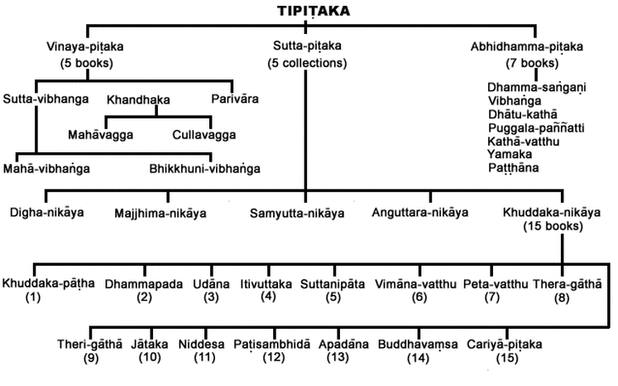




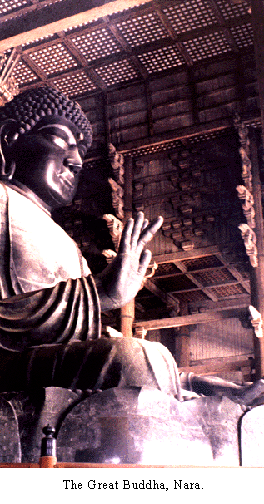

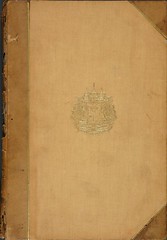
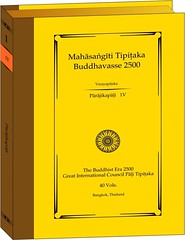
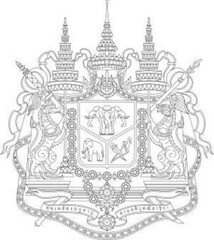





















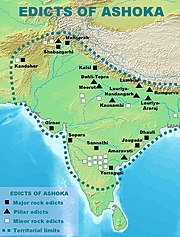
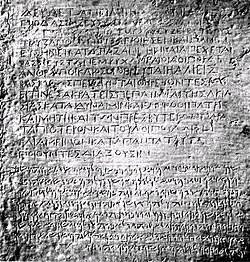
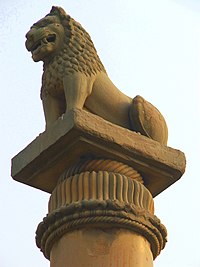








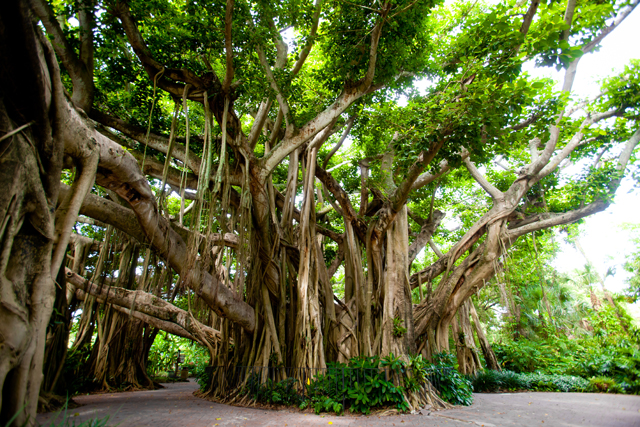







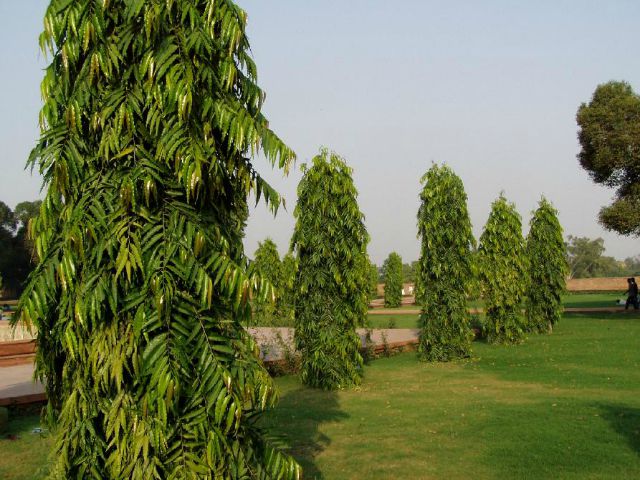













































































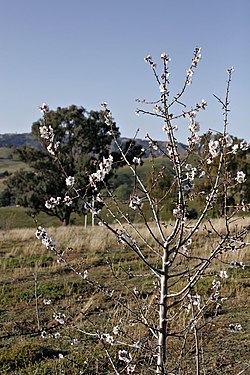

 BSP is OF the Sarvajan Samaj, BY the Sarvajan Samaj and FOR the Sarvajan Samaj ( All Societies)!
BSP is OF the Sarvajan Samaj, BY the Sarvajan Samaj and FOR the Sarvajan Samaj ( All Societies)!

![[IMG]](https://pbs.twimg.com/media/DUmcz2mUMAEN2hC.jpg)
![[IMG]](https://pbs.twimg.com/media/DUSK-SPWsAATHOF.jpg:large)













































































